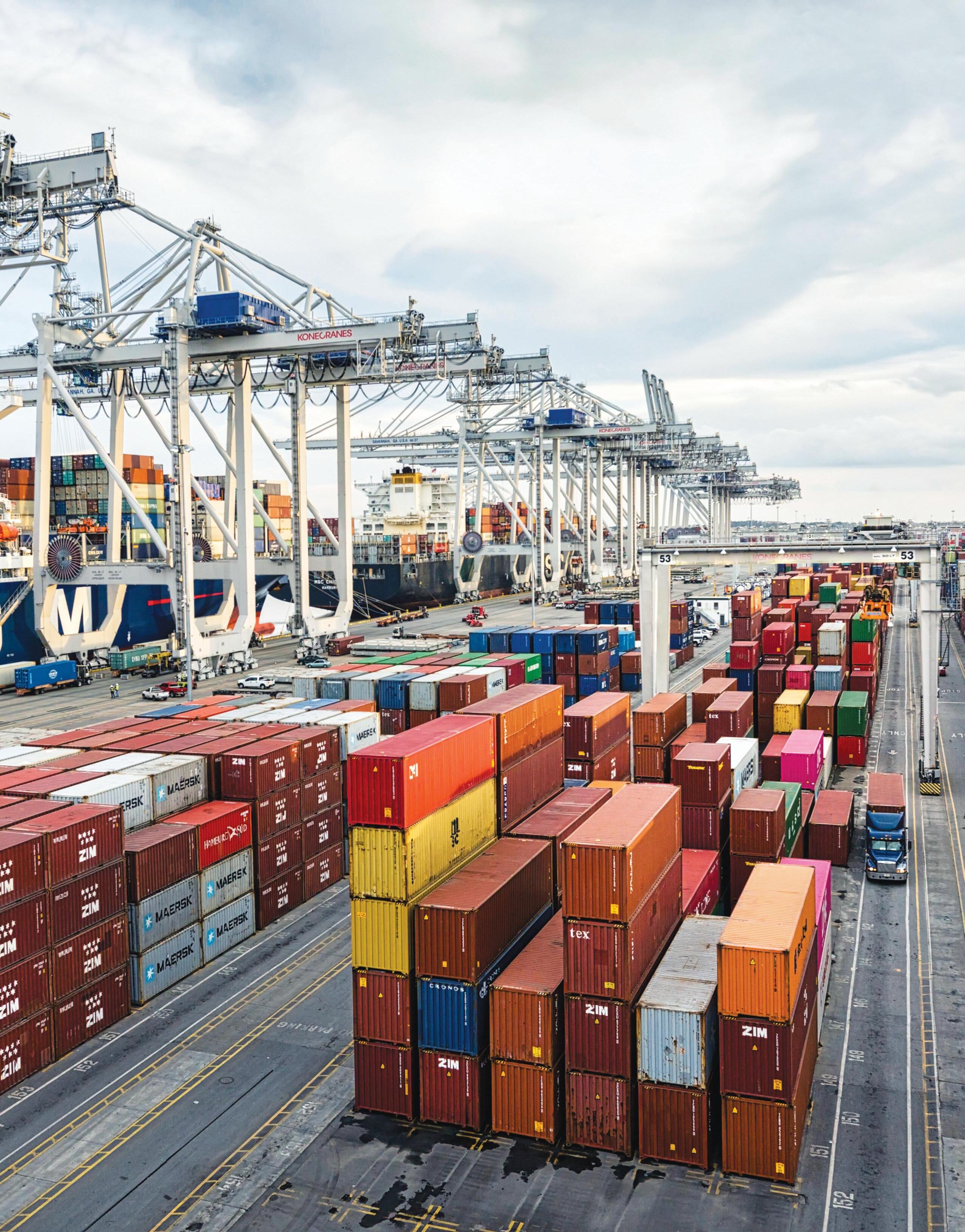
International Journal for Port Management J A N UA RY / F E B R UA RY 2 0 2 3 W O R L D P O R T D E V E L O P M E N T I n t h i s i s s u e : O C R U p d a t e B e n e l u x Po r t S u r v e y M ex i c a n Po r t s W W W. W O R L D P O R T D E V E LO P M E N T. CO M Q u a y s i d e K P I s High-t ec h r eac hes new heights Po r t C r a n e S e c u r i t y Co n t a i n e r C r a n e D e s i g n S t r a d d l e C a r r i e r Po r t S u s t a i n a b i l i t y Po r t Co n s t ru c t i o n High-t ec h r eac hes new heights
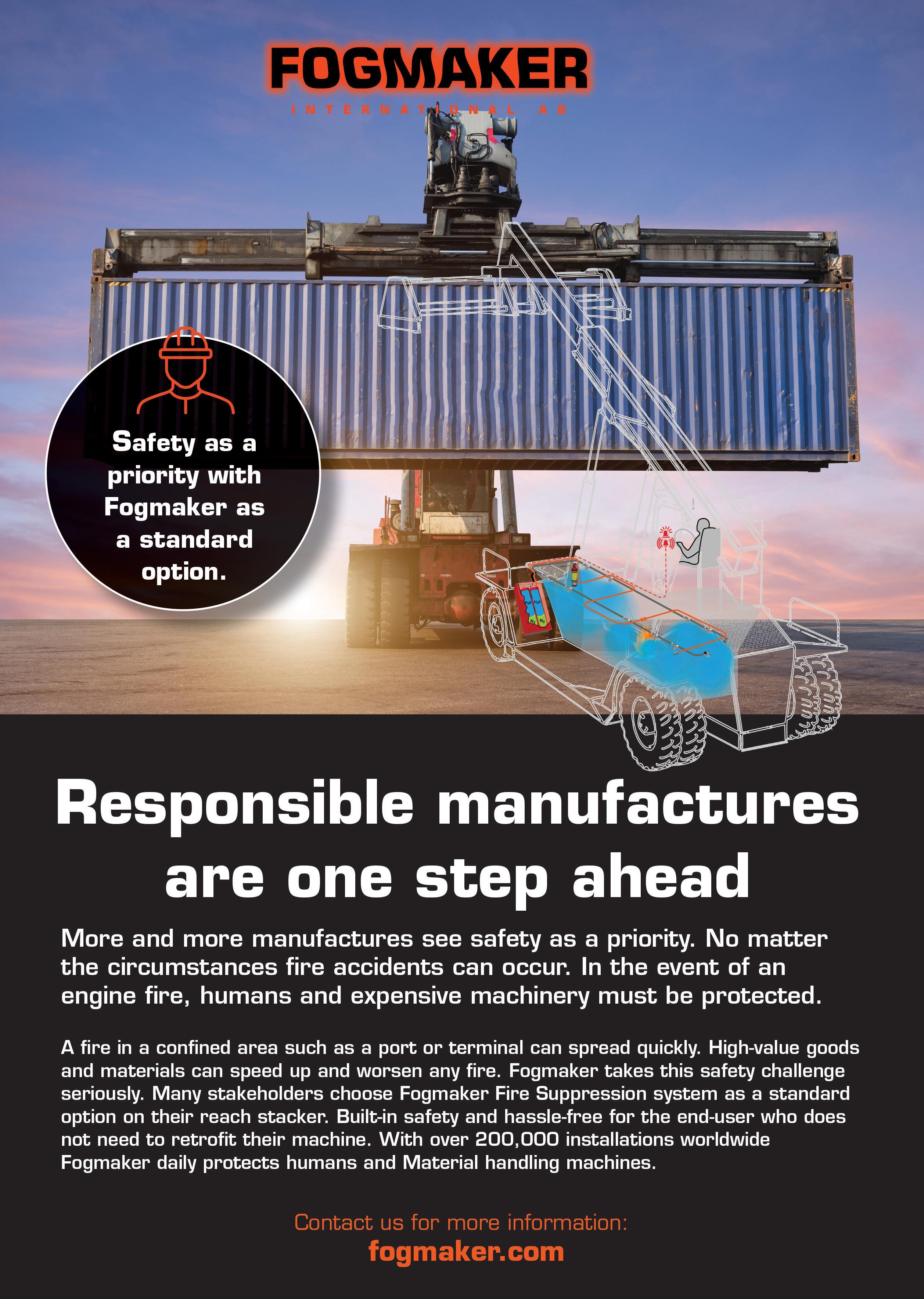

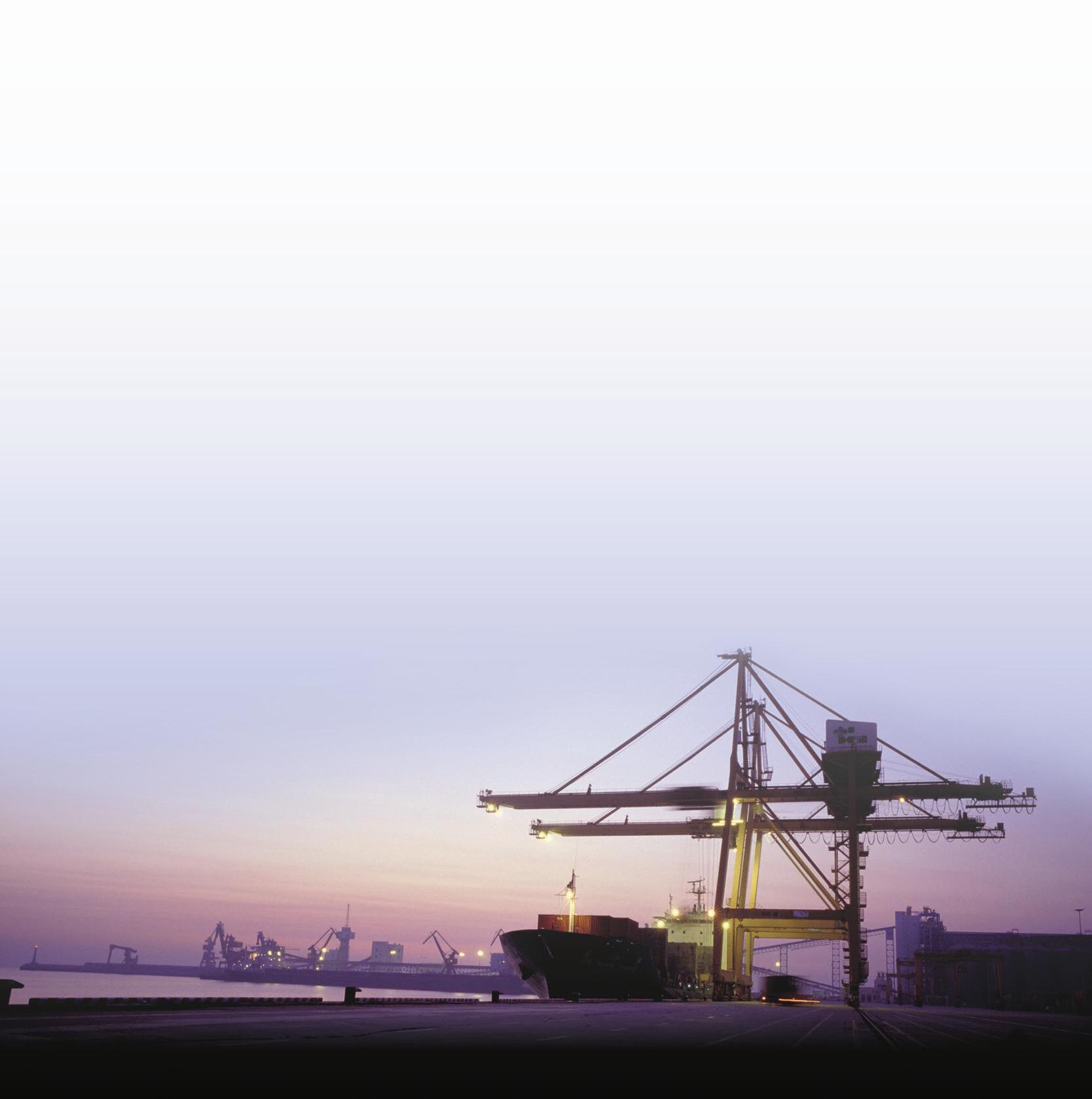
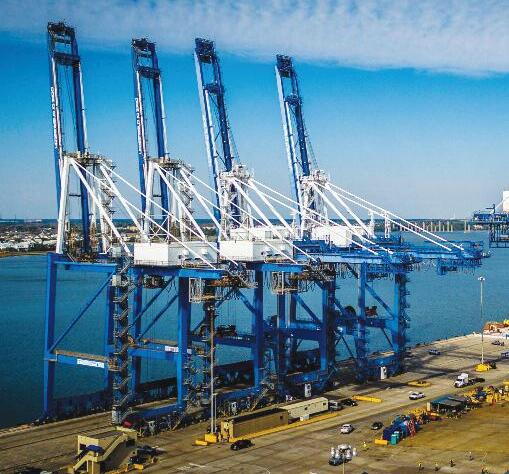
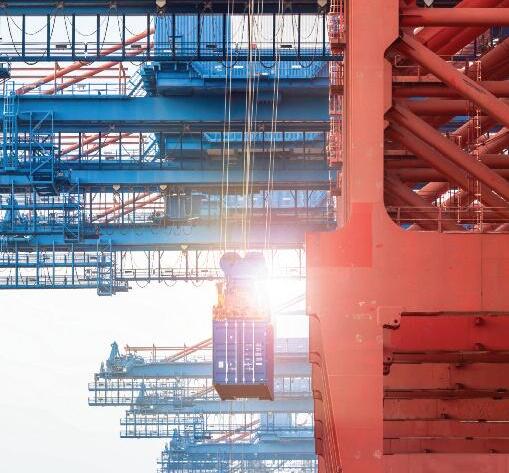
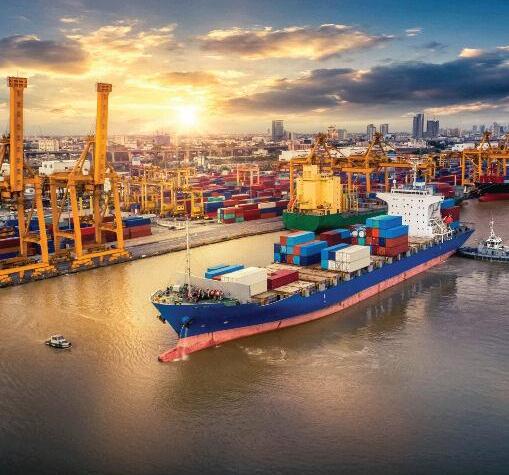
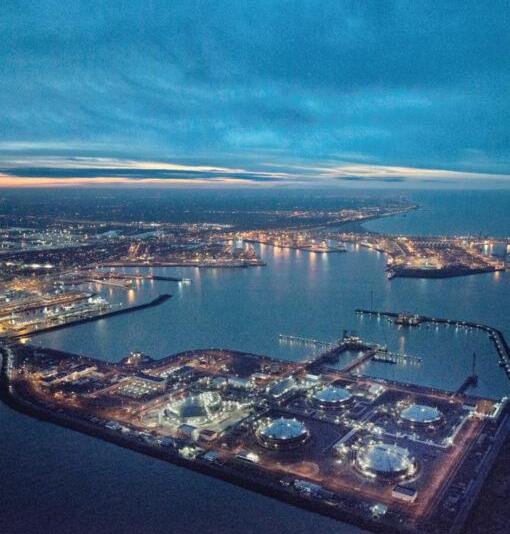
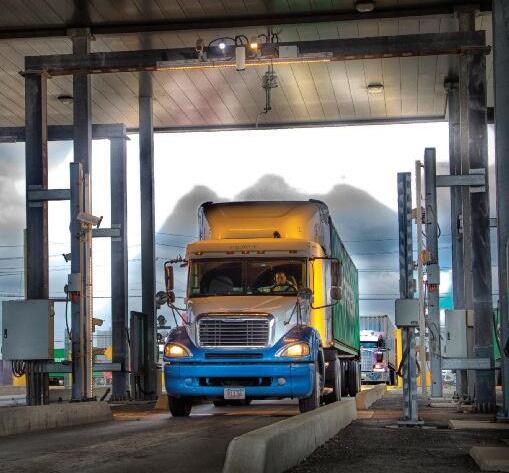
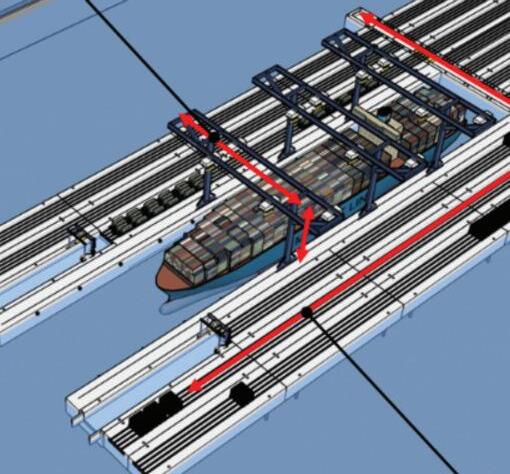
January/February 2023 World Port Development 1 contents visit our website -- www.worldpor tdevelopment .com 16 Unshakeable tenacity in uncertain times Claire Instone brings reader s insight into how Benelux ports remain stable 18 Mexico’s ports are moving up a gear Gordon Feller reports on recent developments and global maritime trade in Mexican ports... 21 Problems ahead? Proposed new US legislation might affect the US crane industry Thomas Francis reports… 26 How to improve quayside KPIs John Lund tak es a look at how advancements in OCR and GOS are changing quayside operations... 32 OCR: much more than data alone Certus Automation gi ves an update on the OCR industry and its future... 38 A floating container terminal Reece Shaw looks at a new design for a floating automated ship-to-shore container terminal... 3 Viewpoint 4 News from around the globe 20 Creating global momentum for sustainable shipping 23 High-tech reaches new heights 30 Hybrid is the buzz word... for now 34 Bedeschi outlines future trends for the stacker/reclaimer 42 Striving to be best-in-class In conversations with terminal operators about Straddle Carriers the word electrification pops up constantly along with reduction of carbon footprint ... Bedeschi provides their outlook on the market for stacker/reclaimers WPCAP has contributed to the faster adoption of sustainability standards and measures in the wider shipping industry The port industry continues to be served by crane manufacturers that listen and deliver Thomas Francis reports Claire Instone reports on the latest from the port construction industry
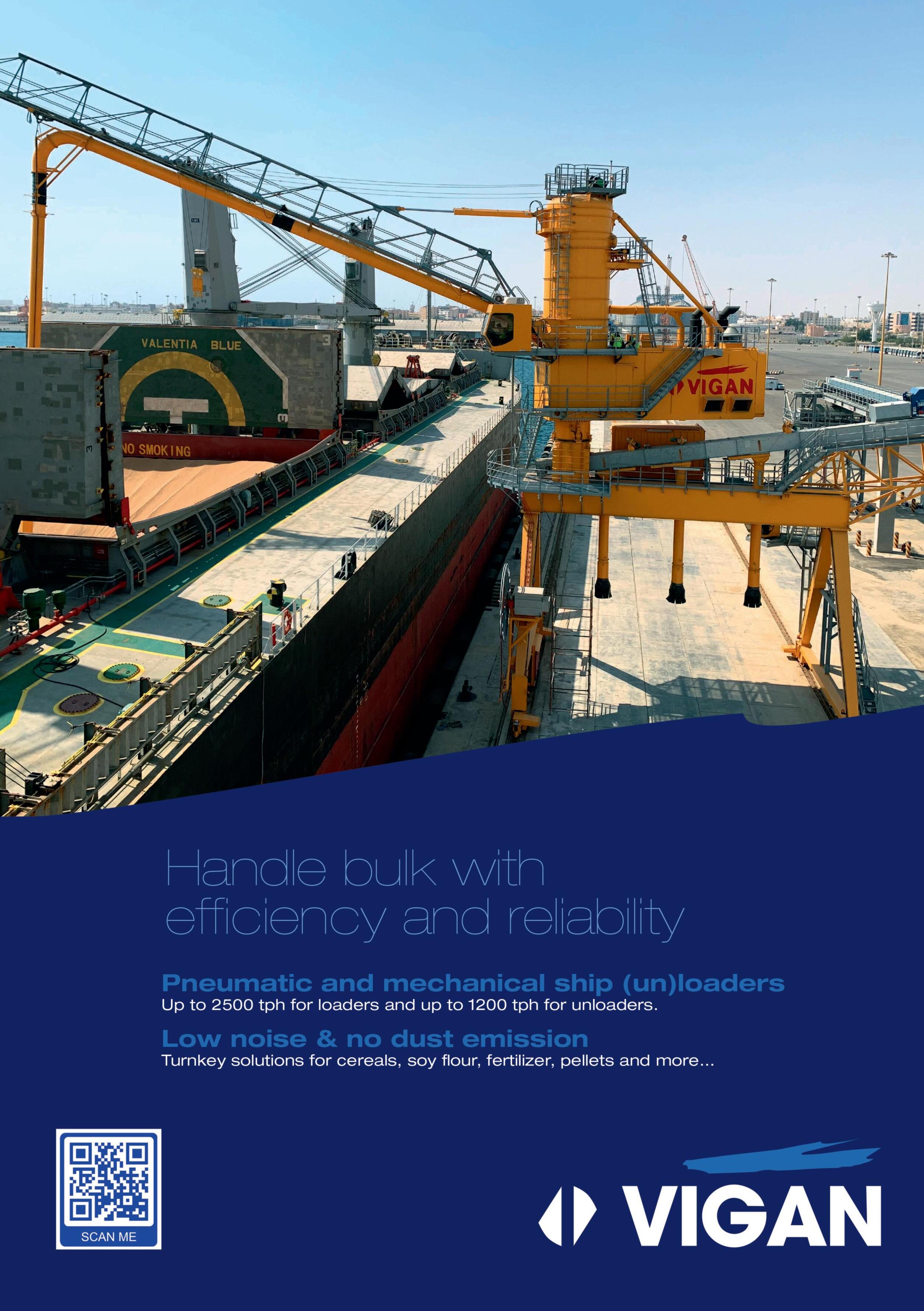
Published
Consulting Editor : Sheila Moloney sheila@worldportdevelopment.com


Editor : Claire Instone claire@worldportdevelopment com
Editorial Consultants: Gordon Feller gordon@worldportdevelopment com
Thomas Francis info@worldportdevelopment com
Commercial Director : Peter van Schie peter@worldportdevelopment com
Business Development: Selina Palmer info@worldportdevelopment com
Production Manager : Helen White info@worldportdevelopment com

Unshakeable tenacity in uncertain times
Our Januar y/Februar y issue kicks off 2023 with a bang delving straight into the latest developments and insights from across the por t industr y - from the future of OCR to trends in the por ts of Benelux and Mexico.
After the disruption of recent years, shipping lines and cargo owners are looking for capacity, reliability and growth oppor tunities and that’s what operators and por t authorities are striving to provide This is the focus in our first por t construction round-up of the year provided by myself Turn to page 42 to find out more about the projects underway to expand and improve infrastructure and create brand new best-in-class facilities.
One por t in par ticular that is ‘moving up a gear ’ is the Por t of Manzanillo The Pacific’s biggest por t is leading the way in terms of expansion and redevelopment, as are many other Mexican por ts as Gordon Feller discovers on page 18.
The por ts of the Benelux are also under the microscope in our inaugural 2023 issue WPD brings readers an insight into how maritime facilities in this region have kept throughput performance stable despite difficulties of the war in Ukraine , sanctions against Russia, and the changes in global energ y flows
As always, the industr y must not only focus on how to get bigger, but how to do this in a manner which is environmentally-friendly Creating global momentum for sustainable shipping is a topic this month’s issue hones in on as we detail the highlights from WPC AP’s latest meeting of por ts for sustainable shipping on page 20.
As promised, as par t of our Jan/Feb offering, we proffer up the latest on the OCR market. We are delighted to welcome editorial on how to improve quayside KPIs from Visy Oy as well as an ar ticle from Cer tus Automation explaining how OCR is more than just data alone See pages 26, and 32, respectively
Email: info@worldportdevelopment.com
If you are interested in the latest in innovation then look no further than page 38 which offers up a detailed look at a proposed floating container transfer/offshore wind turbine fabrication and assembly terminal as delivered by Reece Shaw of Burns & McDonnell
In our market round-up section this edition of WPD delves into the future trends and challenges for the stacker/reclaimer industr y, while Thomas Francis examines the most recent news from the straddle carrier market
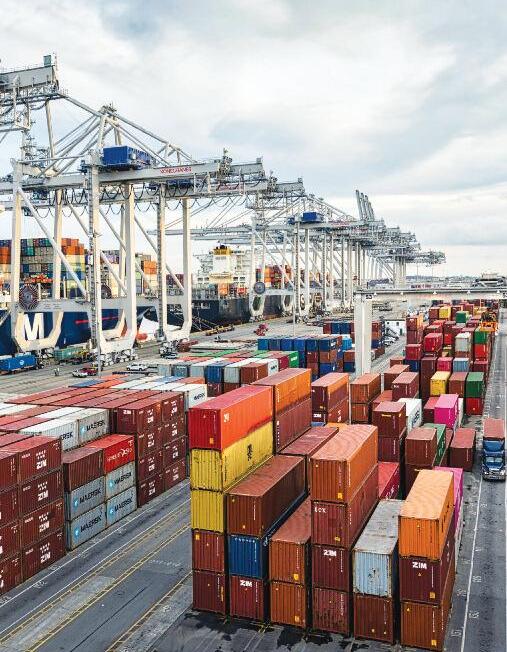 Claire Instone Editor
Claire Instone Editor

January/February 2023 World Port Development 3
viewpoint
1/2
for non receipt of issues must be made within 4 months of publication of the issue or they will not be honoured without charge
Volume 23 Number
Claims
DEVELOPMENT
Court
WORLD PORT
Suite 11 - Maple
Grove Business Park White Waltham Berkshire SL6 3LW United Kingdom Tel: +44 (0)1628 820 046 Fax: +44 (0)1628 822 938
Por t Development is published 6 times per year at an annual subscription rate of UK£175 00 by MCI Media Limited Registered address: “Chantr y House”, 156 Bath Road, Maidenhead Berkshire SL6 4LB England Ever y care is taken in compiling the contents of the magazine, but the publishers assume no responsibility in the effect arising therefrom All views expressed in this magazine are those of the respective contributors and are not necessarily the opinions of the publisher, neither do the publishers endorse any of the claims made in the articles or the advertisements © 2000-2023 World Port Development A l rights reserved No part of this publication may be reproduced stored in a retrieva system or transm tted n any form or by any means, electronic , mechanical, photocopying, recording or otherwise, without the prior perm ssion of the copyright owner
Website: www worldportdevelopment com World
The Georgia Ports Authority has announced that the Port of Savannah handled a record 5 9 million TEUs in 2022 - an increase of 5% compared to 2021
EUROGATE Group and Konecranes celebrate 53 years and 530 SCs
EUROGATE Group and Konecranes celebrate 53 years and 530 SCs
One sign of a successful human relationship is how long it lasts
The relationship between the EUROGATE Group and Konecranes goes back to 1970, when the Konecranes straddle carrier factor y in Germany delivered EUROGATE’s first straddle carriers to the Por t of Hamburg. Since then, 530 Konecranes Noell Straddle Carriers have been delivered to the EUROGATE Group, which has grown steadily over the years to become indispensable to European container traffic In 2022 many straddle carriers of the Konecranes Noell hybrid type NSC 644 EHY were delivered to EUROGATE’s German container terminals. This type stacks 1-over-3 with Konecranes Noell twin-lift spreaders NTS 62 F. For EUROGATE it was of paramount impor tance to advance decarbonisation in connection with efficiency goals With the new machines, emissions can be reduced by up to 30% or approximately 80 tons of CO2 per year compared to the CO2 emissions of the existing straddle carriers The hybrid Konecranes Noell Straddle Carrier NSC 644 EHY carries on the tradition of the diesel-electric straddle carrier with a downsized power train/genset. It uses a batter y pack instead of brake resistors, giving uncompromised performance in comparison with diesel-driven machines The relationship with EUROGATE is an excellent example of Ecolifting, Konecranes’ continuous work to decrease the carbon footprints of its customers

Imaginative solutions drive environmental goals

Imaginative initiatives will drive the Por t of Long Beach’s goal to become the world’s first zero-emissions seapor t, Executive Director Mario Cordero said during the first in-person State of the Port address since 2020 Cordero committed to supporting state and federal efforts to increase renewable energ y sources as he declared 2023 as the “Year of Imagination ” Among the innovative projects planned, Cordero announced the por t’s bid to assemble and manufacture offshore wind turbines that will increase the state’s supply of renewable energ y and reduce greenhouse gas emissions The por t is also establishing a Zero Emissions, Energy Resilient Operations Programme to invest in projects aimed at reducing the impacts of operations and improving air quality
NWSA has record-breaking year for breakbulk
At 342,351 metric tons, 2022 was a record-breaking year for breakbulk cargo handled at NWSA-operated breakbulk terminals. Across all facilities, breakbulk cargo volumes grew 30 7% for 478,455 metric tons in 2022 Auto volumes were 172,979 units, up 6 5% over 2021 In other news, Washington United Terminals (WUT) will be receiving two additional super post-Panamax cranes in the second quarter of 2023 These new ZPMC cranes will boast a 24-wide container row reach, a lift above crane rail of 175 feet, and a lift capacity of 65 long-tons using a spreader and 100 long-tons with a cargo beam The cranes are due to be operational in mid-July following a commissioning period This investment will fur ther expand WUT’s capability to handle larger vessels
n e w s p o r t & t e r m i n a l World Port Development January/February 2023 4
CEDA releases new findings on energ y efficiency

The quest to improve the energ y efficiency of dredging projects and equipment has been a constant goal within the industr y, par ticularly as fuel prices rise and the IMO’s greenhouse gas emissions strategy comes under revision this year. The CEDA working group on energy efficiency (WGEE) has released an information paper about ‘ energ y efficiency considerations for dredging projects and equipment’ aimed at raising awareness and suppor ting informed decision-making by members. The paper promotes sustainable and cost-effective measures in suppor t of energ y efficiency Through the exploration of concepts such as the life-cycle of infrastructure projects, alternative fuels, and technical improvements, the paper determines that for energ y efficiency to be sustainable , it needs to factor in both environmental practices and the economy This creates a business case for owners of dredging equipment to be early adopters of new technologies for their fleet to keep pace with market trends The authors argue that investing in new technology to optimise energ y efficiency can help reduce inefficiencies within operational procedures, ensure regulator y compliance, and reduce costs by using less fuel Thus, dredging companies making these investments will see benefits The paper also highlights the impor tance of reducing a dredging project’s impact on air quality (local) and climate (global)
To implement this, managers must take into account the phases of life-cycle infrastructure projects to address energy efficiency of dredging campaigns
DP World repor ts ahead of market volume growth
DP World Limited handled 79 0 million TEUs across its global portfolio of container terminals in full year 2022, with gross container volumes increasing by 1 4% year-on-year on a repor ted basis and up 2 8% on a like-for-like basis On a Q4 2022 basis, DP World handled 19 5m TEUs, up 2.4% on a like-for-like basis. 2022 gross volume growth was broad based with Asia Pacific , Middle East & Africa, Australia, and Americas regions all delivering like-for-like growth At an asset level, Jebel Ali (UAE), Jeddah (Saudi Arabia), Angola (Angola), Sokhna (Eg ypt), London Gateway (UK), Constanta (Romania), Caucedo (Dominican Republic), Posorja (Ecuador), DP World Santos (Brazil) and all DP’s por ts in Australia (Brisbane , Sydney, Fremantle and Melbourne) delivered a solid performance . Group Chairman and Chief Executive Officer, Sultan Ahmed Bin Sulayem, commented: “We are delighted to repor t another solid volume performance with like-for-like growth of 2 8% in 2022, which is once again ahead of industr y forecast of a marginal decline of -0 5% This outperformance continues to demonstrate that we are in the right locations and our strategy to offer integrated supply chain solutions to beneficial cargo owners is bearing fruit As expected, growth rates moderated in the final quar ter of 2022 due to the more challenging economic environment Looking ahead to 2023, we expect our por tfolio to continue to deliver growth, but the outlook remains somewhat uncer tain due to rising inflation, higher interest rates and geopolitical uncer tainty ”
Increased freight volumes at the Por t of Gothenburg
The strained situation in the global transport system that has prevailed over the year has been managed well at the Por t of Gothenburg
The por t has also increased the freight volume handled in total, and is also winning market shares in all segments. Container handling via the por t continues to increase The final quar ter of 2022 saw an increase of 8%, which means the por t is seeing growth in container volume for the ninth successive quar ter. Around 885,000 TEUs were handled at Gothenburg in the full year 2022, an increase of 7% Most of the port’s container volumes are handled by the terminal operator APM Terminals
ICTSI outlines its vision for Australia’s biggest por t
ICTSI has outlined a significant proposal for the expansion of the Victoria International Container Terminal (VICT), its 100 percent owned subsidiar y in the Por t of Melbourne , Australia. The proposal would increase efficiencies and pave the way for larger ships to ber th ICTSI could invest over AUD500 million (approx USD343m) in addition to the more than AUD700 million (approx. USD480m) it has already
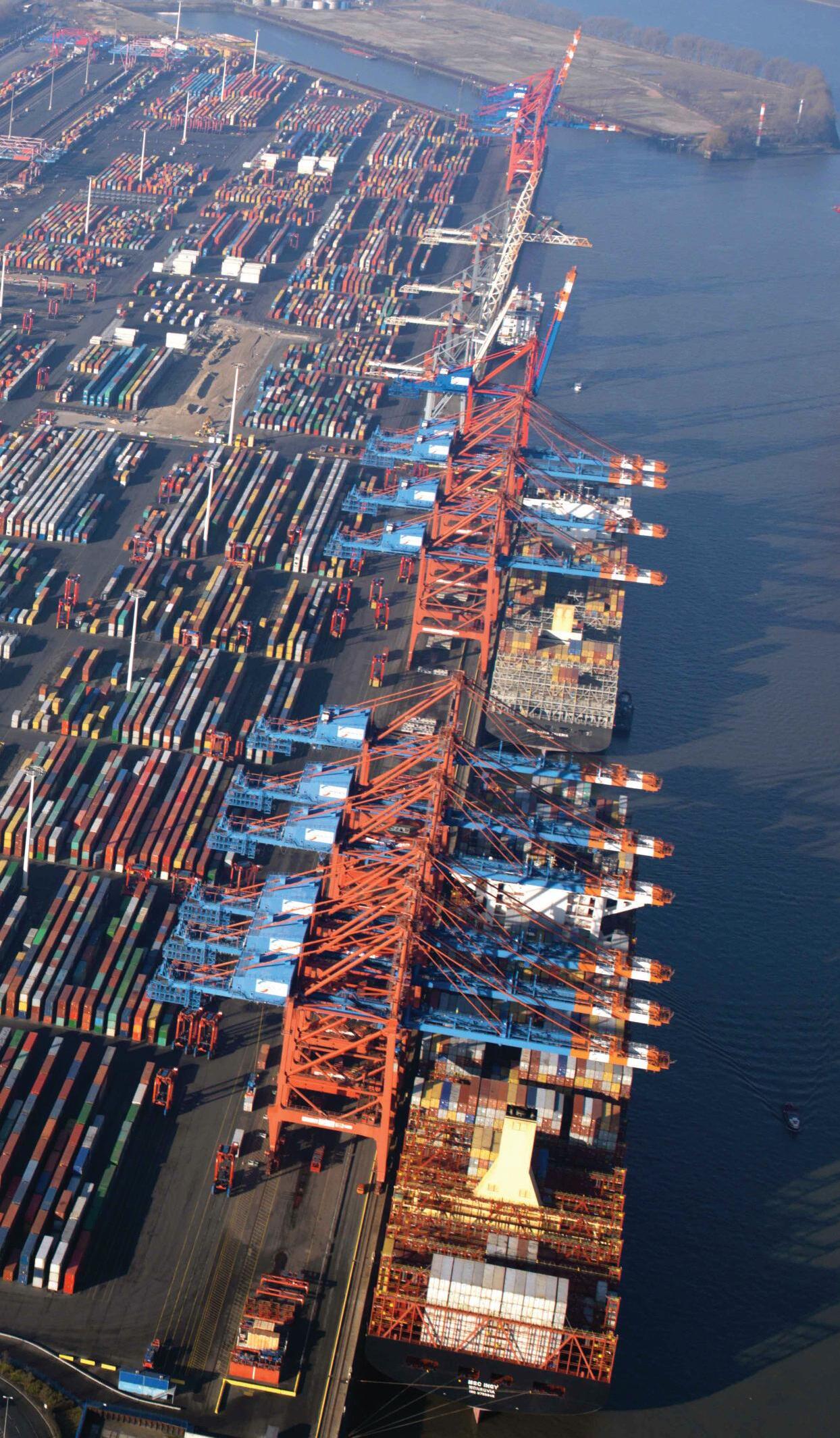
invested in Victoria since the establishment of VICT in 2014 Under the proposal, ICTSI would under take a phased development of the Webb Dock North Container Terminal and integrate its operations with VICT The development would increase VICT’s capacity to 3.7m TEUs.
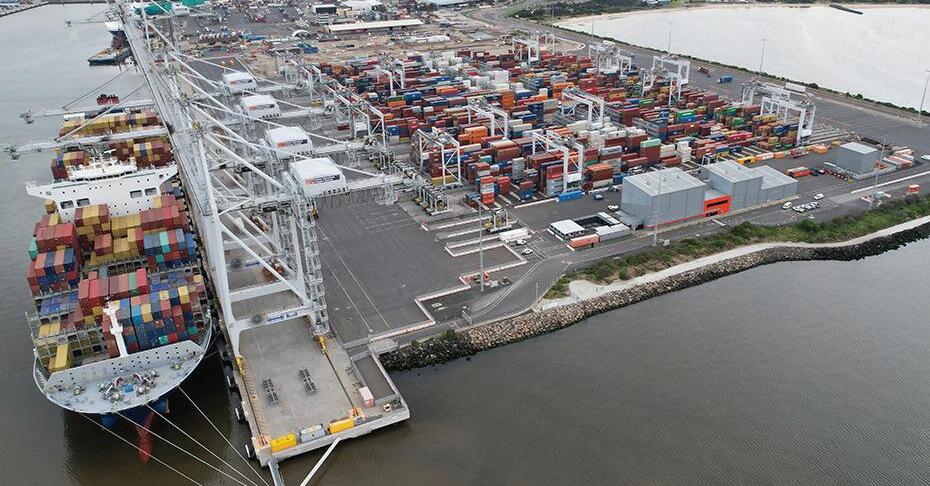
n e w s p o r t & t e r m i n a l January/February 2023 World Port Development 5
Market Intelligence Market Intelligence
Nor t h America
* Softened consumer spending, increased prices driven by inflation and a shift in trade routes contributed to a dip in shipments moving through the Por t of Long Beach in Januar y. The facility processed 573,772 TEUs, down 28 4% from Januar y 2022, which was the por t’s busiest Januar y on record Impor ts decreased 32.3% to 263,394 TEUs and expor ts declined 14 2% to 105,623 TEUs Empty containers moving through the por t were down 29% to 204,755 TEUs “We are taking aggressive steps to meet a new set of challenges for the new year, ” said Por t of Long Beach Executive Director Mario Cordero “I remain optimistic that we will recapture market share and develop projects that will enhance our long-term growth, sustainable operations and the reliable movement of goods through the Por t of Long Beach ”
* Por ts of Indiana has named Jody Peacock as the new CEO Peacock has ser ved in various leadership positions for the Por ts of Indiana since 2001, and is moving up from the position of Senior Vice President for Business Development. Peacock’s experience with the Por ts of Indiana spans over 22 years, where he has led business development effor ts to attract millions of dollars in private investment to Indiana’s por ts, expand the state’s foreign-trade zone and financing programmes, and secure multiple federal grants for new infrastructure projects.
* The Por t of Montreal has earmarked more than C A$335 million ($247 million) in its new five-year investment plan for its infrastructure on the island of Montreal
The por t is aiming to invest massively in its infrastructure on the island which extends over 26 kilometres between Cité-du-Havre and the east of the island, as the por t approaches its full container handling capacity
These investments are intended to pursue four main objectives: develop and sustain por t infrastructure to accommodate the growth of trade; strengthen, optimise , and streamline the supply chain of Greater Montreal; accelerate the decarbonisation of por t activities and the energ y transition; and improve the city-por t interface Projects include the optimisation of rail capacity, with the addition of 6-kilometer tracks to improve the fluidity of rail transport and storage space , and the modernisation of whar ves to accommodate ships in complete safety.
* The Por t of Savannah’s loaded container expor ts grew by 21 percent in Januar y The nation’s busiest por t for US goods handled 110,305 TEUs of expor ts, an increase of 19,419 TEUs “We’re excited to suppor t a strong month for American farms and factories at the Por t of Savannah,” said Griff Lynch, Executive Director of the Georgia Por ts Authority “We achieved par ticularly robust growth last month in expor t trade lanes to Europe and the Mediterranean ” Compared to pre-pandemic numbers, the Por t of Savannah’s Januar y trade of 421,714 TEUs in total cargo showed 11 7 percent improvement over Januar y 2020, in which GPA handled 377,671 TEUs.
* The Por t of Virginia is posting its most productive year on record having processed more than 3 7 million TEUs in 2022, an increase of 5.1%. “We made real progress in 2022 and it was another ver y solid year for volumes,” said Stephen Edwards, CEO and Executive Director of the Virginia Por t Authority.


“Our ser vice and performance levels continue to improve and each quar ter our truck, chassis, rail and vessel performance metrics advanced.” The por t achieved three of its top four months for container volume in 2022, with trade volumes peaking in May at an
all-time high of 341,611 TEUs The por t’s focus on its sustainability programme and becoming a net-zero carbon emissions operation by 2040 also advanced New capital projects using electric equipment coupled with power purchase agreements from exclusively clean energ y production has the por t on track - and in some areas ahead of schedule - to meet is 2040 goal.
Sout h America
* As par t of its strategic objective of global representation and to develop oppor tunities in Argentina, The Bahamas Maritime Authority (BMA) has signed a Memorandum of Understanding (MoU) with Argenmar SA, an independent shipping group established in Argentina in 1992 that provides specialised shipping and logistics ser vices in Argentina and Latin America The MoU relates to future business oppor tunities within the Argentine maritime sector and the broader Latin America region. Argentina, which is a member of the Acuerdo Latinoamerico Vina del Mar MoU on por t state control within Latin America, had over 10,000 ships calling at its por ts and operating within the River Plate region in 2021 This figure , which includes Bahamas flagged ships, covers a wide diversity of ships ranging from oil, container, bulk, passenger and general cargo vessels When combined with maritime traffic through the Hidrovias Waterway, this results in more than 100,000 tons of cargo movement annually The MoU was signed during a meeting held in Argentina in conjunction with the VII Community of Latin American and Caribbean states (CELAC)
* In Q3 2022, two port operating companies in Guyana - Muneshwers Ltd and John Fernandes Ltd - made a joint order for two Generation 6 Konecranes Gottwald mobile harbour cranes to build up cargo handling
n e w s p o r t & t e r m i n a l World Port Development January/February 2023 6
terminals in the capital Georgetown When the cranes arrive in Q2 2023 they will be the ver y first mobile harbour cranes in Guyana, and Konecranes Gottwald MHCs will be present in all coastal states of South America The two Generation 6 cranes have a working radius of 49m and a capacity of 125 tonnes to ser ve container ships up to Panamax class They will be used for container handling mainly, but their flexibility allows them to handle general cargo when needed
* ZIM Integrated Shipping Ser vices Ltd has announced the launch of ZIM Colibri Xpress (ZCX) - a new premium line from South America West Coast to US East Coast, commencing on the coming weeks from Chile. ZCX will operate on the following rotation: San Antonio (Chile), Callao (Peru), Guayaquil (Ecuador) – Car tagena (Colombia) –Kingston (Jamaica) – Philadelphia - Miami, Kingston (Jamaica) - Buenaventura (Colombia – Guayaquil (Ecuador) – Callao (Peru) - San Antonio (Chile). ZCX will offer a superior competitive ser vice for refrigerated cargo from Chile , Ecuador, Peru and Colombia, with the fastest transit time to Philadelphia - as a first por t of call in the US East coast - and competitive transit time to additional US ports ZIM Colibri Xpress (ZCX), operated independently by ZIM, will deploy 6 x 1700-TEU vessels on a weekly ser vice with increased capacity for reefers It will offer excellent connection between the por ts of West Coast of South America and the US East Coast with ver y shor t transit time between major por ts in the region.
Europe
* Logistics ser vice provider, Schweizerzug, has started a direct train connection between Basel, Zürich and Rotterdam The 650-meter shuttle operates on this route three times a week and has a capacity of 96 TEUs.Matthijs van Doorn, Commercial Director at the Por t of Rotterdam Authority, said: “ We are ver y pleased with the decision of Swissterminal and DP World to launch this direct rail ser vice , which will fur ther enhance the ties between Switzerland and the Netherlands Supply chains have been under tremendous pressure in the past few years This supplementar y ser vice will make them more resilient, and it is a great additional option for clients.”
* Kalmar, par t of Cargotec , has secured a large order to supply PSA Italy with a total of eight Kalmar Eco reachstackers for deployment at its Genova Pra’ and SECH container terminals The order was booked in Q1 2023 and the machines are scheduled for deliver y in Q2
They will include Kalmar Insight, a performance management tool that turns data into actionable and impactful insights, along with a variety of add-on safety features including a fire-suppression system It offers an improved overall driving experience with smoother acceleration and less cabin noise

* Valenciaport has reported a fall in container throughput in January this year In terms of TEUs, the facility reached 4.9 million indicating a decrease of 11 5% Transit declined 28 1% and unloading by 32 3%, while expor t container throughput contracted by 10.2%. The total goods traffic stands at 5 7 with a dip of 15 95%
* On April 5, the shipping company Samskip will call at APM Terminals in the Por t of Gothenburg for the first time The traffic will ser ve the container terminal ever y week and then sail on to Faroese Runavik and Reykjavik in Iceland, then arriving in Rotterdam four days later Samskip is a Dutch logistics company with a focus on intra-European traffic within multiple modes of transpor t.

* The year has just begun and Konecranes has already introduced two exciting technical developments to their lift trucks range: reachstackers to handle heavier empty containers and spreaders with an increased capacity Not all containers are fully loaded when stuffed for transit or completely emptied when they reach their destination
So Konecranes has introduced the SMV 128 TC6 reachstacker for semi-laden and empty containers that can handle up to 12 tons Moreover, a new, stronger combi spreader, for the handling of laden ISO containers and trailers, is now available for Konecranes reachstackers designed for intermodal operations
* The Por t of Barcelona has processed over 3.5 million TEUs in 2022. The por t saw an increase in impor t containers by 3 4% and a rise in transit containers by 4 5% On the otherhand, export containers went down 5.9%. The Por t of Barcelona passed the 70 9 million-tonne mark in total traffic last year, representing growth of 6.9% from 2021.
* Italian logistics and transpor t company Grimaldi Group has acquired strategic assets in the Amerikahaven area of the Por t of Amsterdam through its subsidiar y Amsterdam Multipurpose Terminal (AMT)
The purchased assets cover a surface area of over 200,000 square metres and include storage areas, warehouses, logistics areas, and two quays The 20-year concession obtained by AMT in the Por t of Amsterdam aims to improve the ser vices offered to the Dutch market and businesses while also developing the port’s potential as a multimodal logistic hub
* Associated British Ports (ABP) has become the first por ts group to be approved by the Institute of Environmental Management and Assessment (IEMA) to act as a training provider for IEMA courses From Januar y of this year, ABP employees have star ted to par take in the IEMA-accredited course: Environmental Sustainability Skills for the Workforce The IEMA is the global professional body for individuals and organisations working, studying, or interested in the environment and sustainability “This concentrated one-day course provides a practical introduction to environmental sustainability, equipping our workforce with the knowledge, understanding and motivation to make a positive difference within their role at ABP,” Kerr y Thompson, ABP Group Head of Academy
Asia
* The government of Sri Lanka is set to invest $132 million in por t development projects using revenue generated from por t operations. According to repor ts, the Eastern Container Terminal is to receive over $100 million, while Jaya Container Terminal will get $32 million. Both terminals are fully owned by the Sri Lanka Por ts Authority Moreover, the government plans to develop the Trincomalee harbour for bulk cargo operations and Galle harbour for tourism purposes The latter will be developed to facilitate yacht ser vices and accommodate large ships. These investments are par t of Sri Lanka’s broader aim to become a logistics and transpor t hub in the Indian Ocean and a boost economic activity.
* On 11 Februar y an incident occured in the Long Tau river in Ho Chi Minh City (HCMC), southern Vietnam, when the 2,038-TEU Wan Hai 288 and 920-TEU Resurgence collided leaving both vessels damaged Resurgence crashed into the por t bow of Wan Hai 288 and caused damage to a number of containers. According to repor ts, the vessel underwent inspection operations after travelling to Cat Lai Terminal in HCMC following the accident. Wan Hai 288 was making its way towards a por t in HCMC while carr ying around 1,383 containers The Resurgence was repor tedly carr ying over 600 containers and travelling in the opposite direction
* A new freight ser vice connecting Asia and Europe via Jeddah Islamic Por t has been announced Saudi Ports Authority (MAWANI) and Saudi shipping giant Bahri have jointly announced the addition with the route’s first ship due in Februar y 2023 The new route will help grow Bahri’s shipping network
n e w s p o r t & t e r m i n a l January/February 2023 World Port Development 7

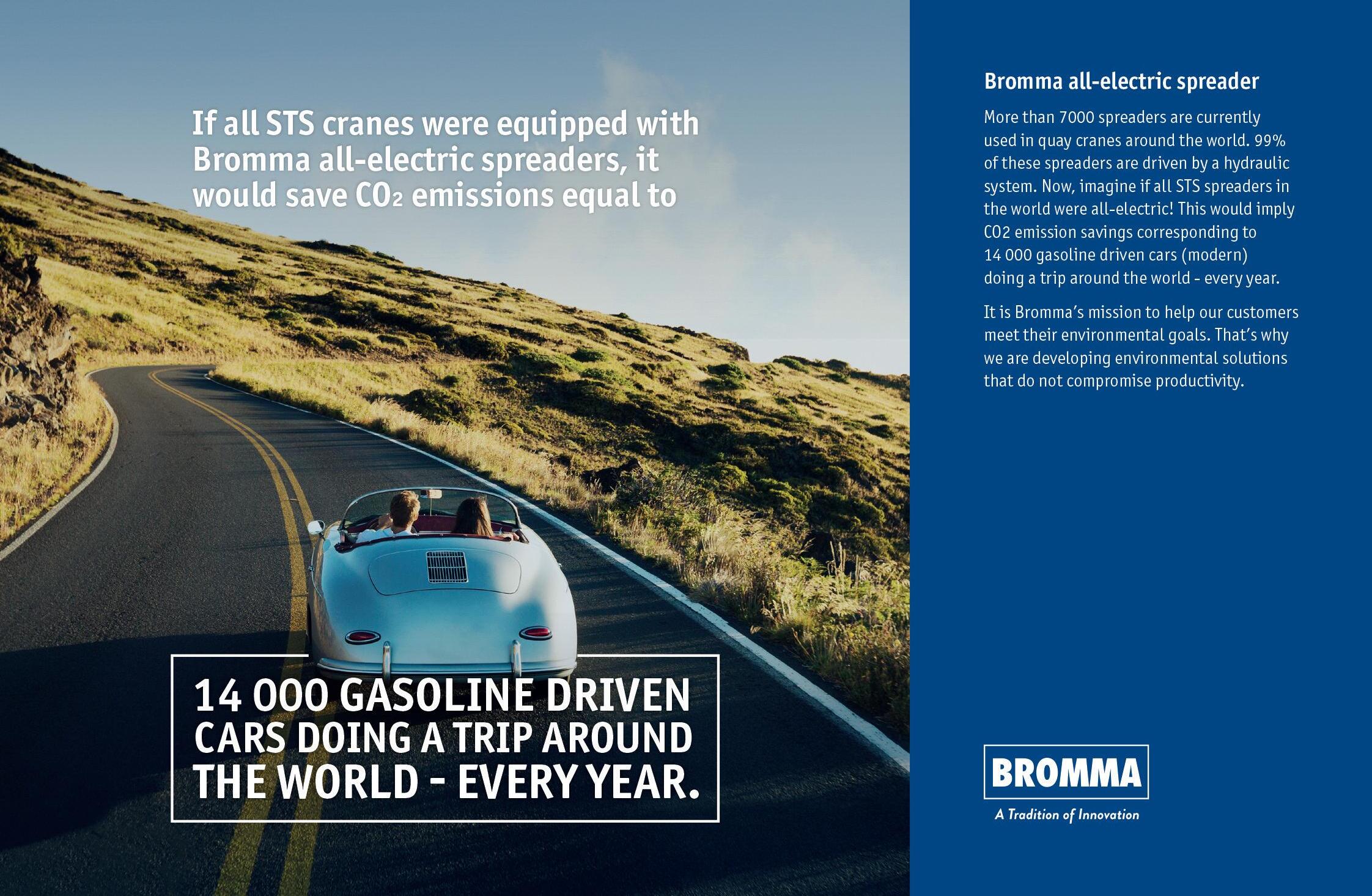

n e w s p o r t & t e r m i n a l World Port Development January/February 2023 8
THEMONTHINPICTURES
Long Beac h closes 2022 wit h second-busies t year

Por t of Long Beach marked its second-busiest year on record by moving 9.13 million TEUs in 2022, allowing for a return to normal operations while once again ser ving as the nation’s leading expor t seapor t The por t ended 2022 with 9,133,657 TEUs moved, down 2.7% from 2021, which remains the por t’s most active year in its 112-year histor y Impor ts declined 4 9% to 4,358,789 TEUs, while expor ts totalled 1,414,882 TEUs, -1 6% Despite the slight decline , the Por t of Long Beach remained the nation’s leading expor t por t for a second consecutive year, for loaded TEUs.
High volumes at Por ts of Stoc kholm
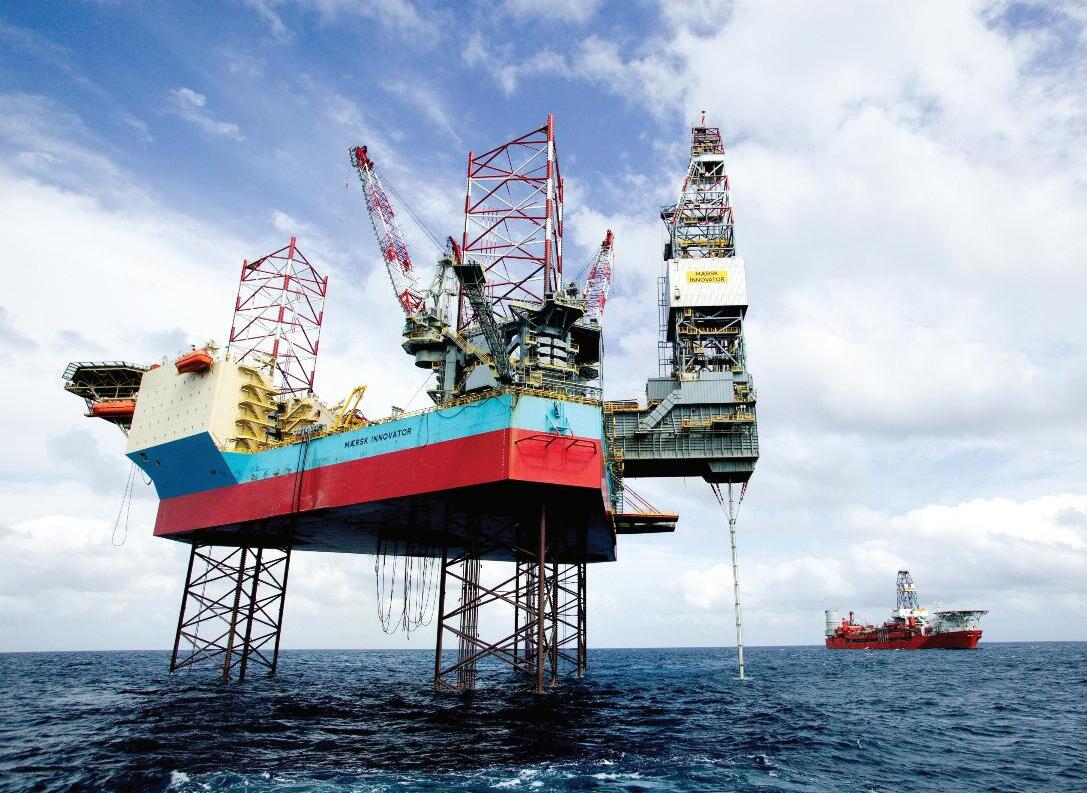
Despite a declining economy, goods volumes remained high at Por ts of Stockholm across 2022. At Sweden’s newest por t, Stockholm Nor vik, container traffic was up 8 5 percent and RoRo-traffic increased by 16.5 percent in comparison to the previous year Stockholm Nor vik Por t had 2,400 vessel calls in total during 2022, which is 34 percent more than in 2021
2. Jordi Torrent, Head of Strategy at Port of Barcelona, was appointed secretary general of the Mediterranean ports’ association MEDPorts 3. The first ship of the year for the Port of Sept-Iles was M/V Cape Alexandros, which arrived at 11:00am on January 4, 2023, from Rotterdam in the Netherlands 4. The Georgia Ports Authority has named Flavio Batista as its new Vice President of Sales and Marketing Batista comes to


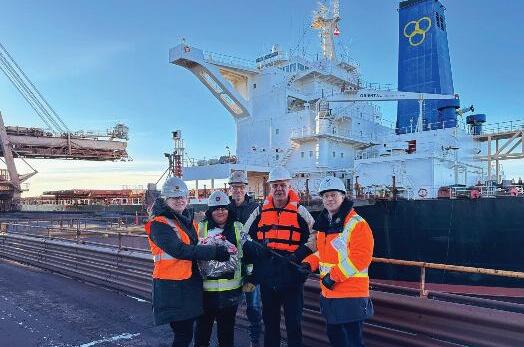

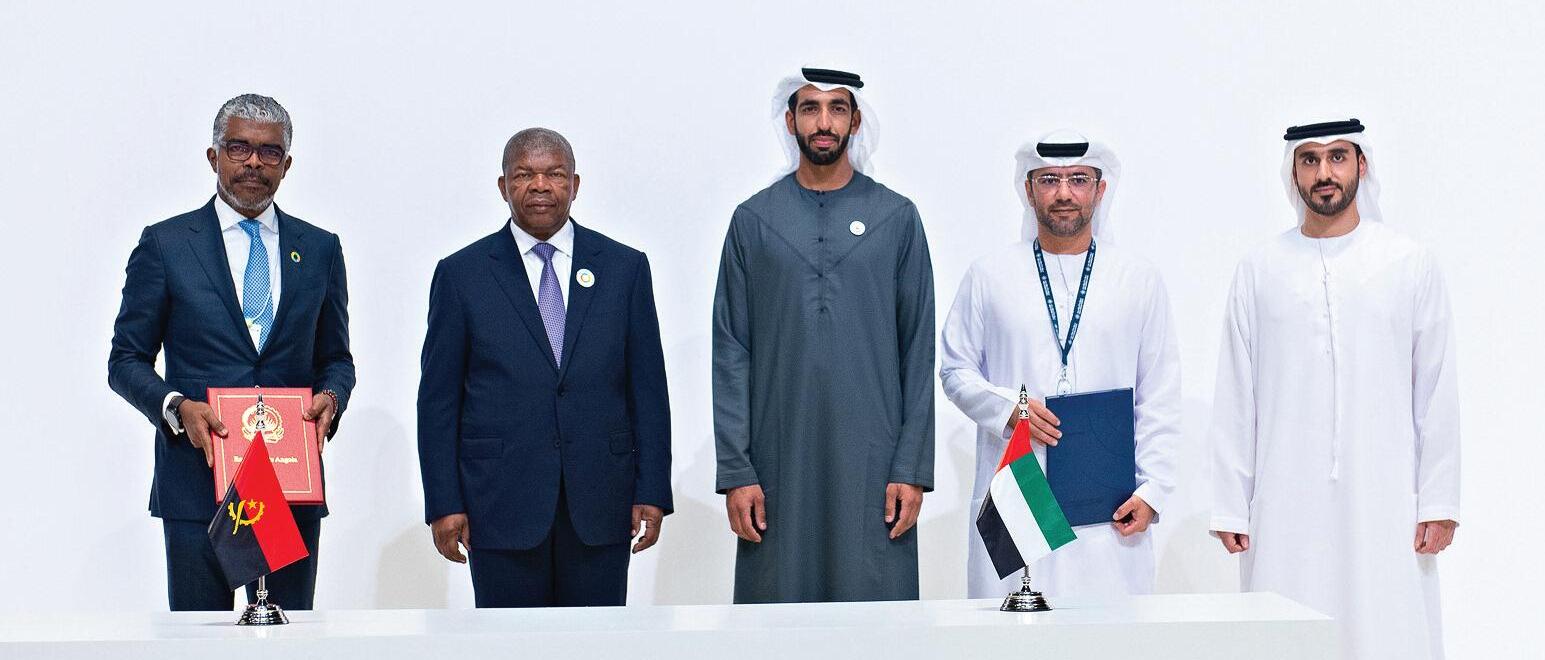
GPA from the Wallenius Wilhelmsen Group, an ocean carrier focused on developing sustainable shipping and logistics solutions 5. Freeport East has appointed Steven Wilson as its new Head of Innovation He will lead engagement with universities, R&D centres, large and small businesses and a range of public and private funders and investors to ensure Freeport East builds an innovation cluster that supports local businesses and communities and helps position the region for greater inward investment 6. A jack-up rig sporting legs more than 200 metres in height has become the largest ever vessel to visit Port of Aberdeen The Noble Innovator offshore rig arrived for maintenance
SPOTTED SOMETHING OF INTEREST?
If you have seen something unusual or something of interest for inclusion in this column make a photograph of it and send it by email to: yourpicture@worldportdevelopment com
“It is really pleasing to see that Ports of Stockholm shows strong figures for both the amount of goods and number of passengers Shipping is an efficient and sustainable mode of transpor t that creates good oppor tunities for the entire region to continue growing,” says Clara Lindblom, Chair of the Board at Por ts of Stockholm. The number of ferr y passengers increased significantly, and the recover y following the pandemic has been ver y good
January/February 2023 World Port Development 9
1. During Abu Dhabi Sustainability Week 2023, AD Ports Group entered into a framework agreement with the Ministry of Transport of the Republic of Angola to begin collaboration on the development of maritime services and infrastructure across the country
2 1 4 3 5 6
n e w s p o r t & t e r m i n a l
Salerno adds LHM 600
The Gallozzi Group - parent company of SCT - and Liebherr are building upon a par tnership that began around 2017 as Salerno Container Terminal (SCT) adds a new LHM 600 to its fleet. The new LHM 600 HR strengthens an existing fleet of four other Liebherr mobile harbour cranes The new addition will focus on container operations and is planned for 24/7 operation. The crane ’ s reliability and flexibility, as well as trust in the provided ser vice , were cited among the main reasons for the customer to continue investing in Liebherr equipment Salerno Container Terminal is a maritime gateway connecting worldwide container shipping networks to South and Central Italy’s impor t and expor t markets It operated the first container vessel at the por t of Salerno in 1977 and today ranks among the top Italian por t facilities, supplying more than 40% of the countr y ’ s consumer population. SCT already benefits from a variety of Liebherr por t equipment and mobile harbour cranes, including two LHM 800 and two LHM 600, both in the High Rise or HR version. The new crane is outfitted with a tower extension of 12 meters Cranes of this variety benefit from a better view of the cargo/containers, thanks to a higher cabin, which is at 37 1 meters in case of the new crane The pivot point is also higher, allowing for larger ships to be ser ved. With the crane ’ s extended range , more container rows can be accommodated The new crane also features VDL twin-lift spreaders with a capacity of 2 x 32 5 tonnes The crane is thereby strong enough to lift two containers simultaneously. This allows for notably efficient operations in container handling This shipment also achieved a remarkably fast turnaround time , with the order being completed in November and the crane being delivered to SCT on December 29, 2022
GPA handles nearly 6 million TEUs in 2022
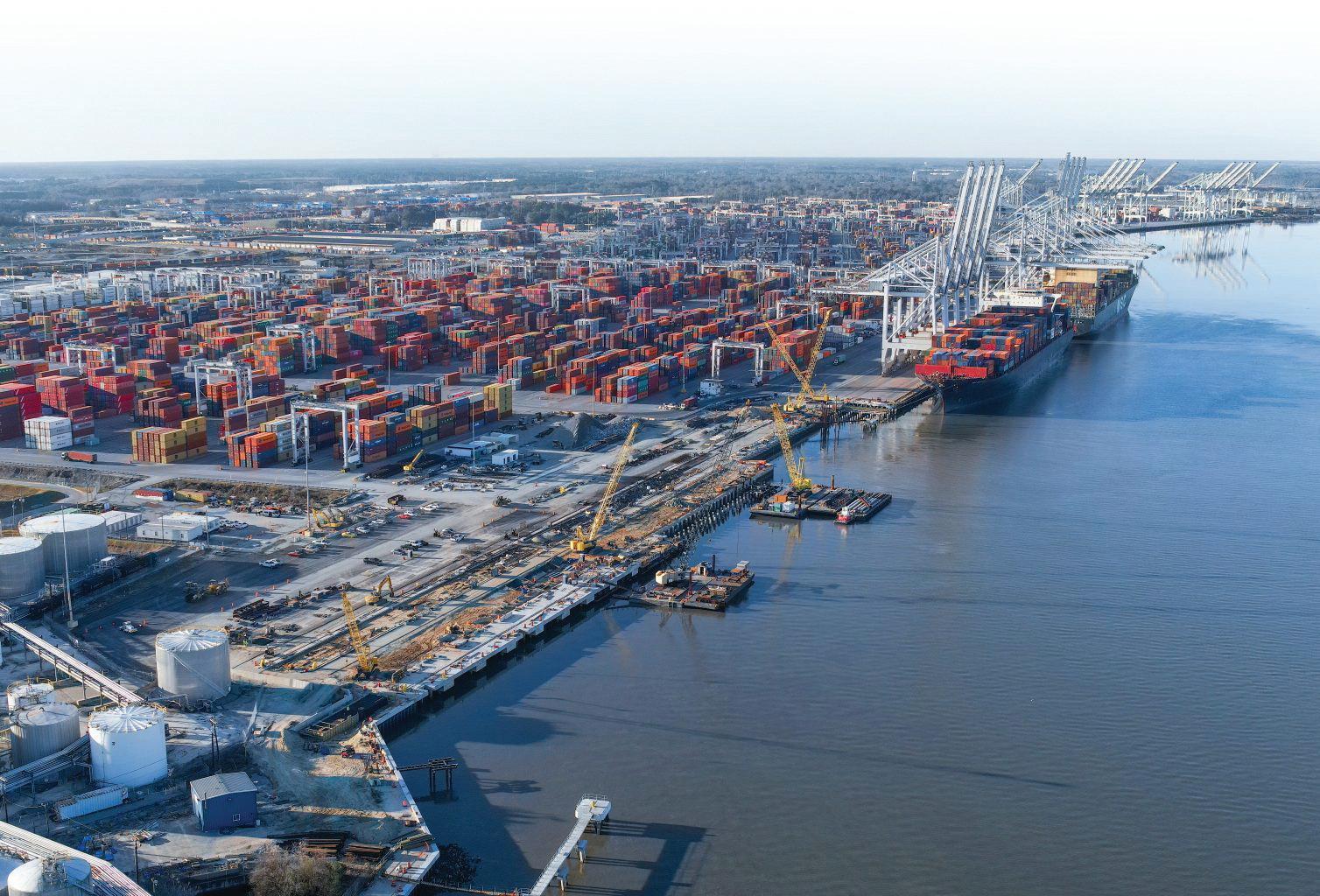
The Georgia Por ts Authority (GPA) handled a record 5.9 million TEUs in Calendar Year 2022, an increase of 5 percent over 2021 “It was a challenging year, but collaborative effort across Georgia’s supply chain ensured cargo movement remained fluid,” said GPA Executive Director Griff Lynch “I want to thank our Board for approving new infrastructure that allowed us to handle more cargo. ” The Por t of Savannah achieved four of its top five months for container volume in CY2022, with trade volumes peaking in August at an all-time high of 575,500 TEUs “We’re excited about the possibilities ahead, with major infrastructure projects delivering greater capacity and efficiency for our customers,” said GPA Board Chairman Joel Wooten “At Georgia Ports, we ’ re bringing to market faster vessel service, quicker turn times for trucks and more room to grow business.” In addition to record container cargo in 2022, GPA achieved a 16 percent increase in breakbulk tonnage to nearly 3 3 million tons last year, an improvement of 443,000 tons compared to 2021 In Roll-on/Roll-off cargo, Colonel’s Island Terminal in Brunswick handled 651,101 units of autos and heavy machiner y. Ocean Terminal in Savannah moved another 19,630 Ro/Ro units, for a total of 670,731, an increase of 0 4 percent Total tonnage crossing all GPA docks reached 42 4 million tons last year, an increase of about 2 percent or nearly 760,000 tons.
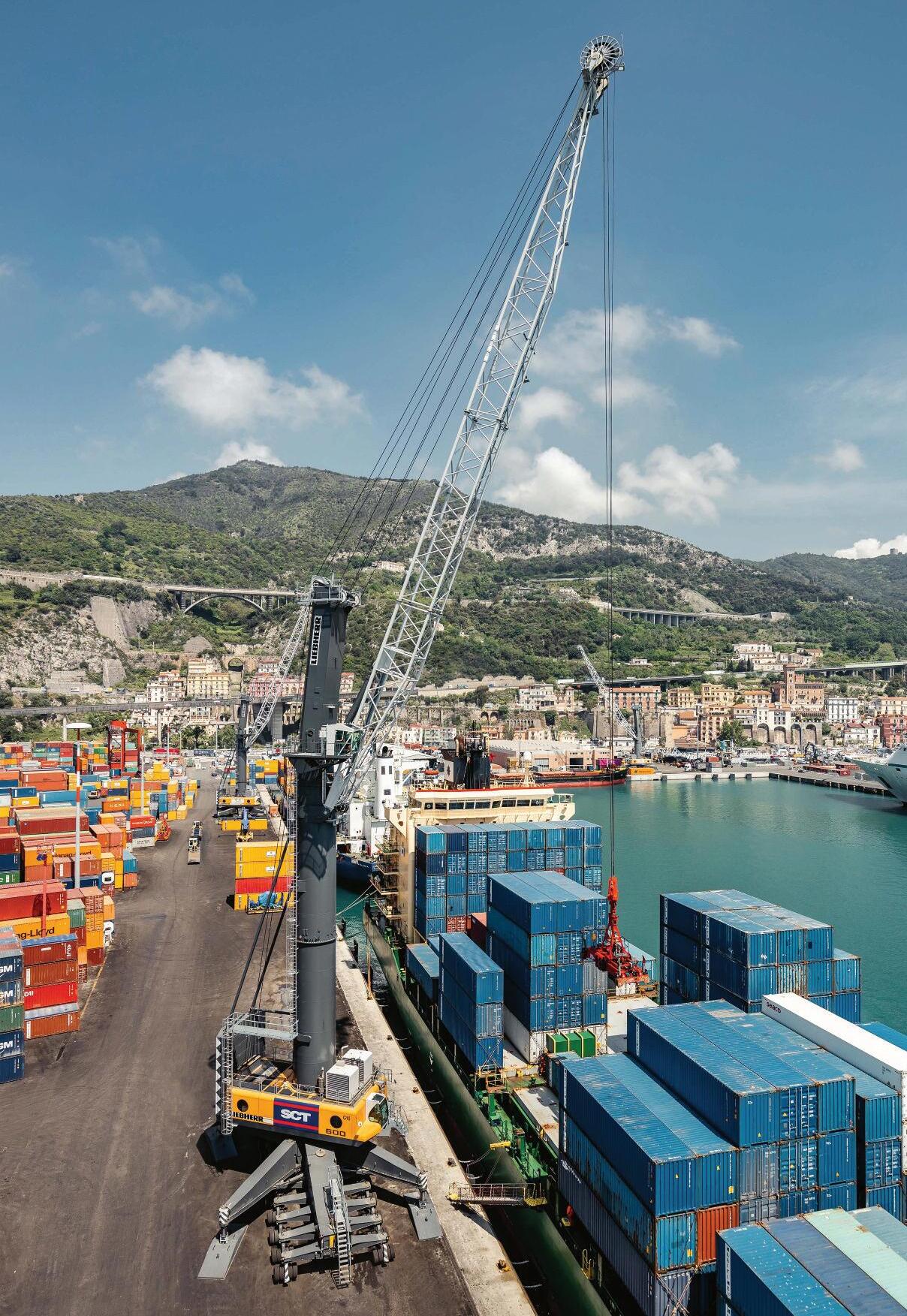
Electric trucks now in use for container traffic at the Por t of Gothenburg
Skaraslättens Transpor t is Sweden’s biggest provider of container transport on the roads, hauling 850-900 containers daily to all Swedish container por ts The lion share goes to the Por t of Gothenburg, and the haulage company has deployed two electric trucks on container flows to the por t - with a third truck joining them shor tly “We don’t want to be standing on the side-line when the transition takes place - we want to be leading the way, and we ’ re also seeing our customers increasingly requesting sustainable transpor t operations With that in mind, this was a pretty easy decision to make,” says Johan Söderström, CCO at Skaraslättens Transpor t The trucks represent an important milestone for Gothenburg, yet they are just the beginning of a development that will accelerate during 2023, with more haulage and freight companies preparing to deploy electric heavy trucks
n e w s p o r t & t e r m i n a l
Shor t Sea boost for London Thamespor t
The range of shor t sea container ser vices available from Hutchison Por ts London Thamespor t is to be increased following the announcement by Viasea Shipping of a new ser vice from the South East UK por t

Commenting on the new sailing, Mark Taylor, Director, London Thamespor t, said: “London Thamespor t is already well established as one of the leading shor t sea container por ts in the South East of England and offers excellent ser vice levels in both quayside and landside operations We are delighted that Viasea Shipping has chosen Thamesport as its gateway into the region. The addition of their UK-Norway ser vice complements the regular and reliable connections we already have to Nor thern and Southern Europe We look forward to working with them over the coming years to increase the range , frequency and reliability of options for shippers.” Norwegian-owned Viasea Shipping, established in 2016, is an independent shor t sea operator connecting Norway with the UK, Europe and the Baltic states The new ser vice from London Thamespor t will call weekly with connections to Moerdijk and the Norwegian por ts of Oslo, Moss and Kristiansand, with onward connections into the Baltic and Poland
COSCO launches China Electric Ship Innovation Alliance
COSCO Shipping Corporation Limited and COSCO Shipping Development have par tnered up to form the China Electric Ship Innovation Alliance This alliance officially began on 8 Februar y, following its founding conference which held over 80 companies in attendance . These companies included the National Development and Reform Commission of China, the Water Transpor t Bureau of the Ministr y of Transpor t, the Center for International Economic and Technological Cooperation, and the Yangtze River Maritime Safety Administration to name just a few A strategic collaboration agreement for the Green Water Zero Carbon Project was also inked during the event China Energ y Engineering, China Cheng Tong, China Merchants Capital, and COSCO Shipping Development have all signed a cooperative agreement
HHLA Next invests in FERNRIDE - joint pilot project in Tallinn
HHLA Next, Hamburger Hafen und Logistik AG’s innovation unit, is investing in Munich-based star t-up FERNRIDE. A pilot project for highly automated and electric container logistics is being launched at the HHLA TK Estonia terminal in Tallinn in par tnership with HHLA International. The goal of the project is to develop solutions for the gradual automation of trucks within live operations
HHLA Next is investing in FERNRIDE's innovative solution to drive forward automation and sustainability in logistics and to address the lack of truck drivers En route to automated transpor t logistics, the unique approach of FERNRIDE lies in the gradually increasing autonomy of trucks and tractor units The combination of autonomous driving technology of the vehicles and human exper tise in remote operation already offers a reliable ser vice available now in live operations This creates an immediate added value and speeds up the journey towards more sustainable logistics
Simone Lode , Managing Director of HHLA Next: “ We see great potential in autonomous driving solutions With FERNRIDE, we are investing in a company that has already implemented a viable solution with a par tner network of respected companies from industr y and logistics with ver y good results ”
Visy crane OCR system to be delivered to Baltic Hub
Visy is ver y pleased to announce that its par tner Autepra has been awarded the quayside automation contract for 14 STS cranes at Baltic Hub (DCT Gdansk) The system will include Visy TopView (spreader OCR) and Visy LaneView with terminal tractor matching. The system will image containers in flight and automatically recognise container codes and other attributes to expand the terminal’s process automation capabilities By automating quay operations with the addition of Visy OCR, Baltic Hub will improve KPIs such as operational capacity and ber th productivity, while enhancing the accuracy and safety of the container handling process The project scope includes system deliver y, integration with Navis TOS, and suppor t and maintenance ser vices
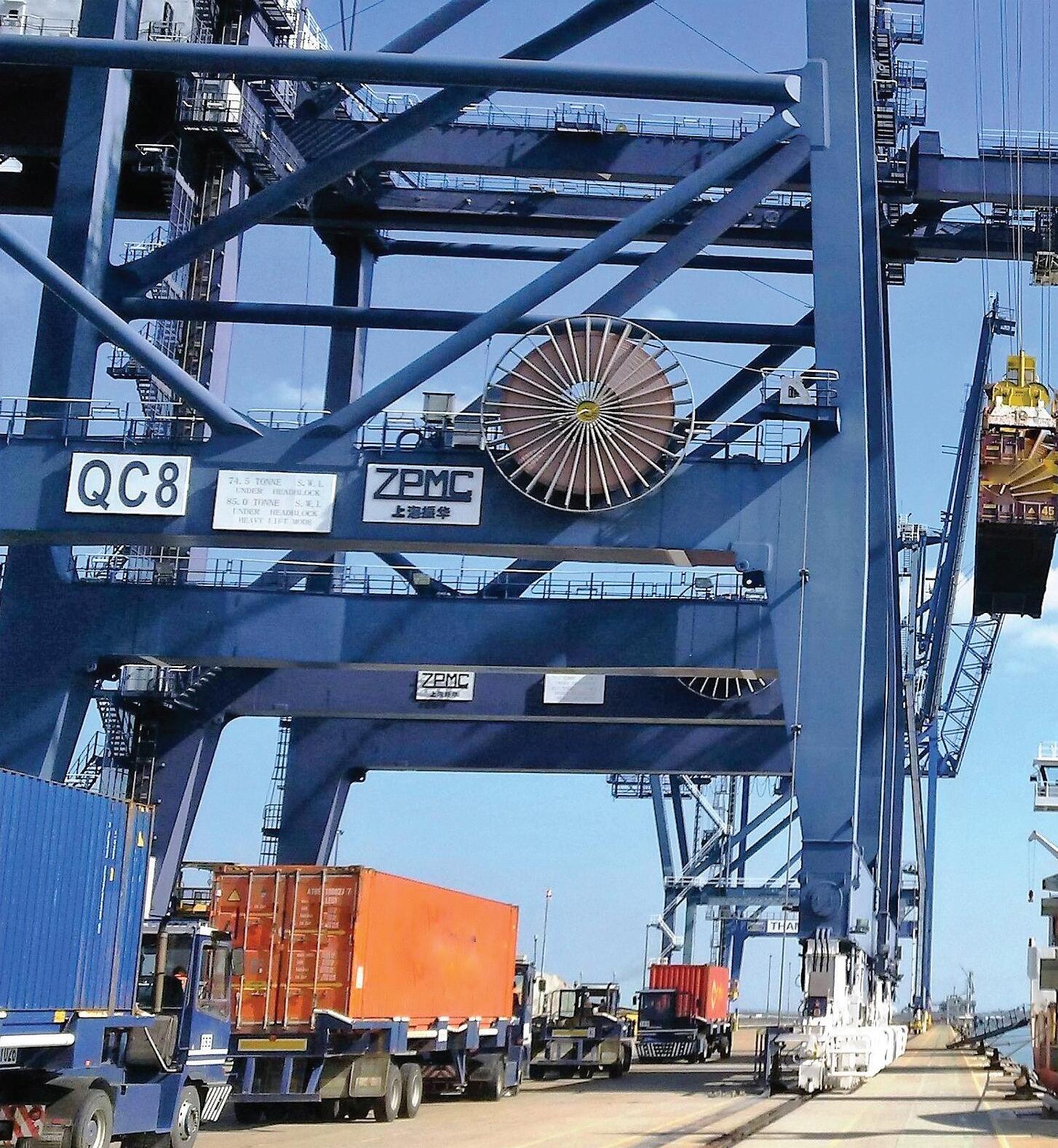
n e w s p o r t & t e r m i n a l January/February 2023 World Port Development 11
New facility at Por t of Vancouver gets green light
The Rober ts Bank Terminal 2 Project at the Por t of Vancouver has had the go-ahead from Canada’s Federal Minister of Environment and Climate Change. Minister Steven Guilbeault has deemed the project to have sufficient information to suppor t government decision-making His approval comes after the Vancouver Fraser Port Authority (VFPA) provided additional information in response to a government request regarding potential effects of the project on fish and fish habitat, salinity, and Indigenous people The VFPA demonstrated that the project could be completed in an environmentally responsible nature and included measures for mitigation and adaptive management as well as increased monitoring The project is set to increase Canada’s West Coast container terminal capacity by 30% and is viewed as a critical piece in meeting the countr y ’ s growing trade needs, suppor ting economic prosperity, and ensuring access to goods for Canadian consumers and businesses
End of 2M alliance
terminal in Savona,
Italy.
order was booked December 2022 and will be delivered in June 2023 “We have high expectations for our material handling cranes, and Konecranes has fulfilled them all They’ve offered us an easily adaptable , high-performance hybrid solution that will bring a new level of productivity to our terminal while helping us to cut our carbon emissions and fuel consumption,” says Ettore Campostano, Owner and CEO of CG The
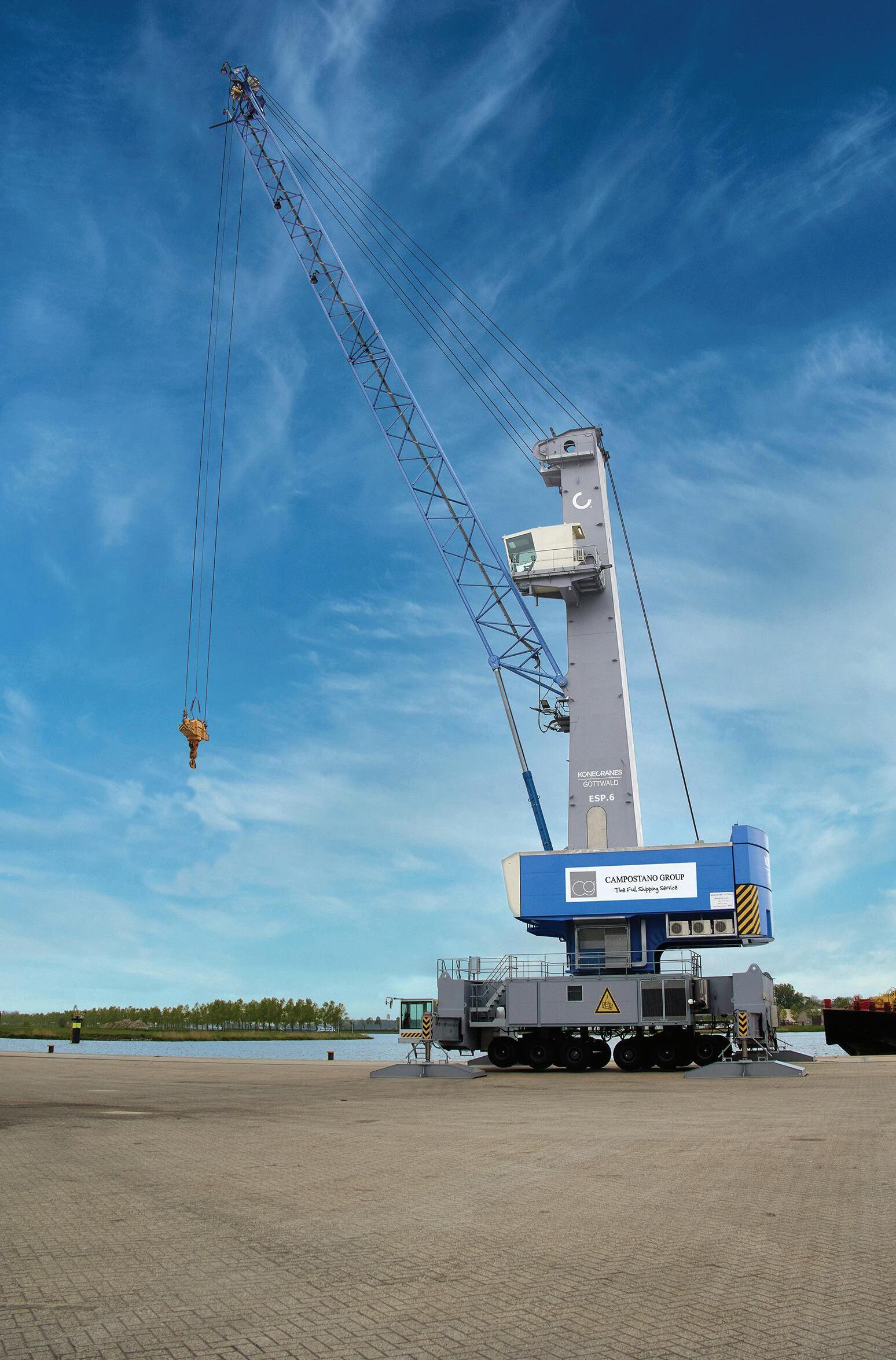
Por t of Los Angeles container throughput down in Januar y
The Por t of Los Angeles processed 726,014 TEUs in Januar y of this year, a 16% decrease from the previous Januar y ’ s all-time record. “We expect softer global trade throughout the first quar ter, par ticularly compared to last year ’ s record-breaking start,” Executive Director Gene Seroka told journalists during a media briefing “Many factories in Asia have had extended Lunar New Year closures, retailers continue to discount products to clear warehouses and inflation-led economic concerns remain top of mind for Americans. With capacity on our docks today, we ’ re ready to unlock new levels of value and ser vice at the Por t of Los Angeles ” Seroka was joined at the briefing by John Padgett, President of Princess Cruises Padgett discussed plans for Princess to expand operations in LA after a strong 2022. The por t had 229 cruise calls last year and expects cruise demand to continue to increase . Januar y 2023 loaded impor ts reached 372,040 TEUs, down 13% compared to the previous year Loaded expor ts came in at 102,723 TEUs, up 2 5% compared to last year
Mediterranean Shipping Company (MSC) and A P Moller – Maersk (Maersk) have mutually agreed to terminate the 2M alliance and is due to be complete by Januar y 2025 In a statement, the CEOs of both companies, acknowledged that the shipping industry has undergone significant changes since the alliance was established, and that discontinuing 2M would allow both companies to pursue their own individual strategies. The 2M alliance was star ted in 2015 as a strategic par tnership that allows for the sharing of shipping routes and resources to enhance efficiency and reduce expenses The decision will not have any immediate impact on the ser vices provided to customers currently using the 2M trades

n e w s p o r t & t e r m i n a l World Port Development January/February 2023 12
Italy’s Cam pos tano Anc hor updates its f leet Italy’s Cam pos tano Anc hor updates its f leet
Campostano Anchor, part of the Campostano Group (CG), has ordered a Generation 6 Konecranes Gottwald mobile harbour crane for general cargo and bulk material handling to update their existing fleet at their
nor thern
The
new crane has a working radius of 49m and a lifting capacity of 125 tonnes to ser ve vessels up to Panamax class.
Construction on Saudi Arabia’s largest Integrated Logistics Park begins
A.P. Moller - Maersk (Maersk) and the Saudi Ports Authority (MAWANI) have star ted work on Saudi Arabia’s largest Integrated Logistics Park at Jeddah Islamic Por t Located on an area of 225,000 square meters, the greenfield project will be the first of its kind at the Jeddah Islamic Por t, offering myriad solutions aimed at simplifying the supply chains of Maersk’s customers in the Kingdom The ground breaking ceremony was attended by the President of the Saudi Por ts Authority, Danish Ambassador to Saudi Arabia, CEO of Zamil Construction, and the Managing Director of Maersk Saudi Arabia Cited to create more than 2,500 direct and indirect jobs in Saudi Arabia, the $346 million investment will be 100% powered by solar energ y generated from rooftop solar panels spread over 65,000 square metres Moreover, the trucks used for transpor tation at the park will also be fully electric vehicles Plans also include a dedicated eCommerce fulfilment centre to cater to the rapid growth of eCommerce in Saudi Arabia.
Hull terminal storage capacity upped with £4.8 million investment
ABP Humber has recently completed an extension to its Humber Container Terminal at the Por t of Hull in the UK The facility at the Por t of Hull welcomes around 12 vessels per week from Rotterdam, Amsterdam, and Ghent, ser ving customers Samskip, iMotion, and BGF
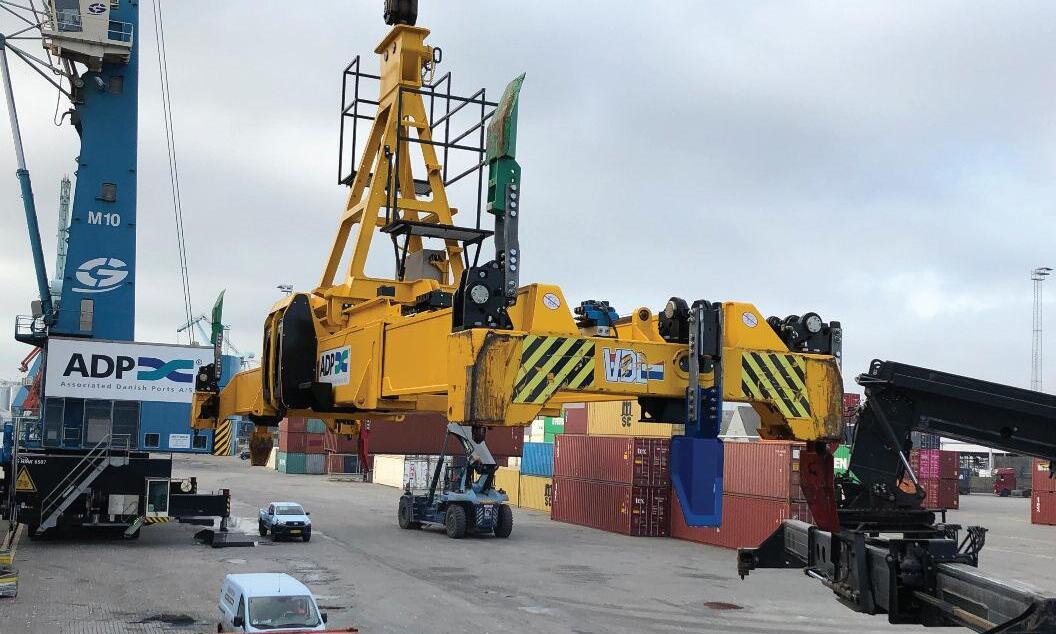
An investment of £4 8 million has enabled an additional 17,600 square meters of heavy-duty paving to expand the terminal’s storage capacity This adds to the 15 vessels ser ved by the Humber Container Terminal at the Por t of Immingham Simon Bird, Director, Humber, said: “Having completed a £50 million investment at the start of 2021, the Humber’s provision to ser ve the container sector goes from strength to strength with these ongoing investments The extra space and equipment is fur ther evidence of the growing value the terminals have in the economic life of the Nor th of England and the Midlands.” Clearance works for the extension were carried out by Stoneledge , and the construction works were completed by CR Reynolds
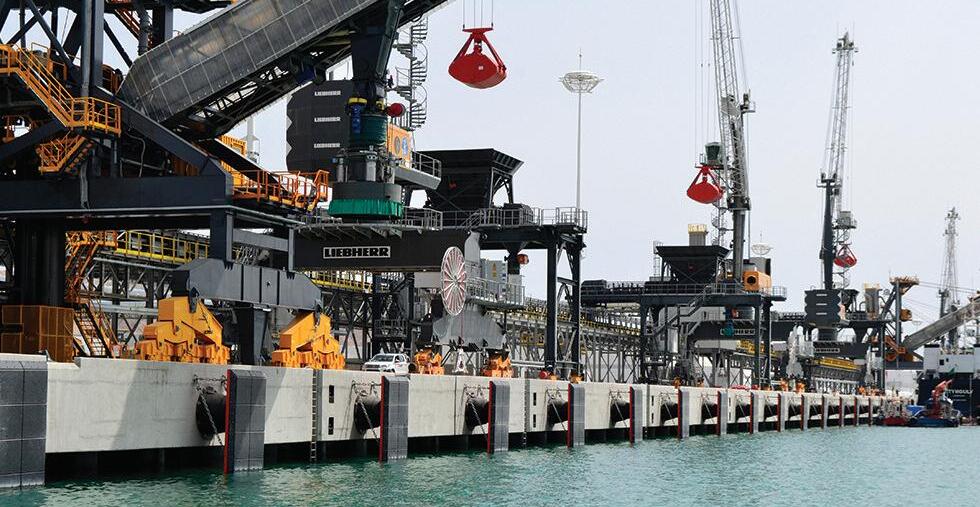
Por t of Hamburg TEUs down during 2022

The Port of Hamburg processed a total of 8 3 million TEUs during 2022, reflecting a 5 1% decrease from itsr volume in 2021 Hamburg terminals handled 119.9 million tonnes in 2022 showing a 6.8% decrease from the previous year Impor ts came in at 4 2 million TEUs, 6 1% lower than in 2021 The por t expor ted 4 1 million TEUs, a 4 1% drop from the year prior. The Port of Hamburg attributed much of its 2022 annual results to geopolitical issues, par ticularly the Ukraine-Russia conflict
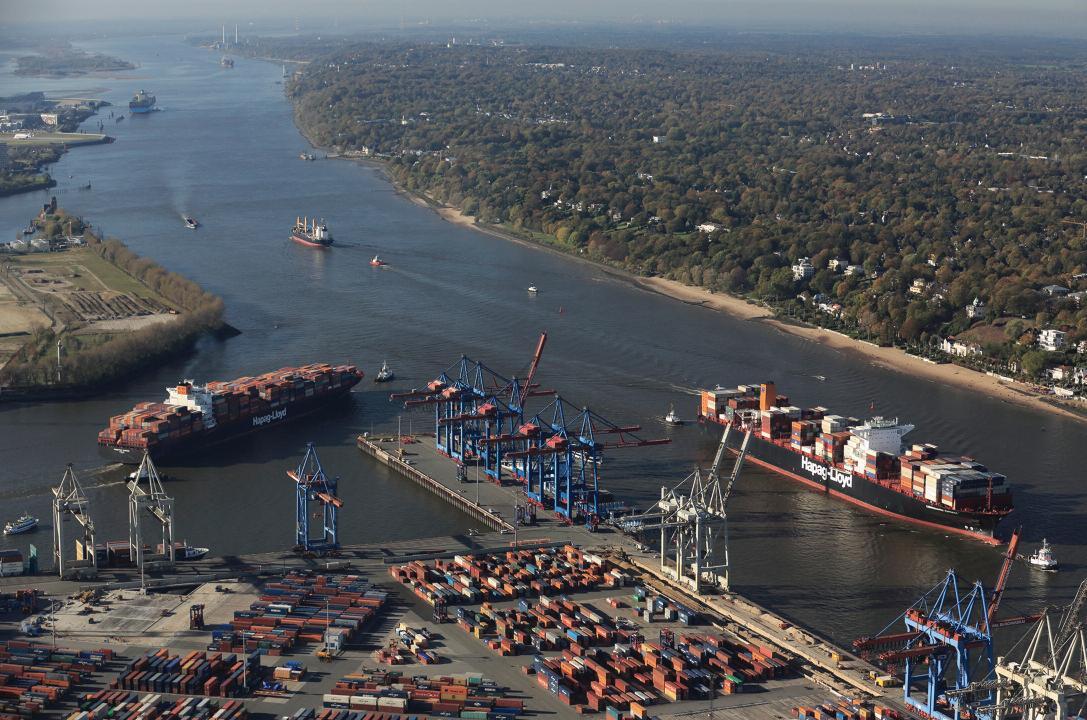
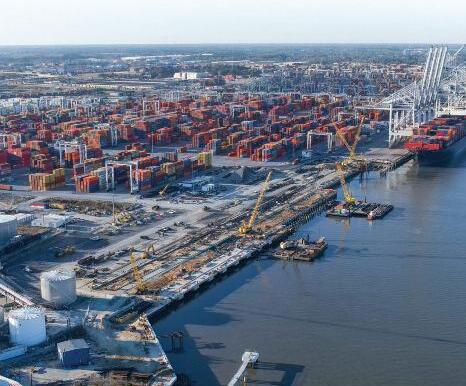
n e w s p o r t & t e r m i n a l January/February 2023 World Port Development 13 Spr eader s T he latest mar ket news and pr oduct developments... PLUS US East Coast por ts Pneumatic shipunloader s Floating cranes Ter minal lighting Fender s A round-up of the latest news... International Journal for Port Management W O R L D P O R T D E V E L O P M E N T NEXT MONTH Don’t miss out . To make sure you get the next issue of World Por t Development subscribe TODAY. Email subscribe@worldportdevelopment .com
Courtesy: SFT
Courtesy: VDL
Courtesy: GPA

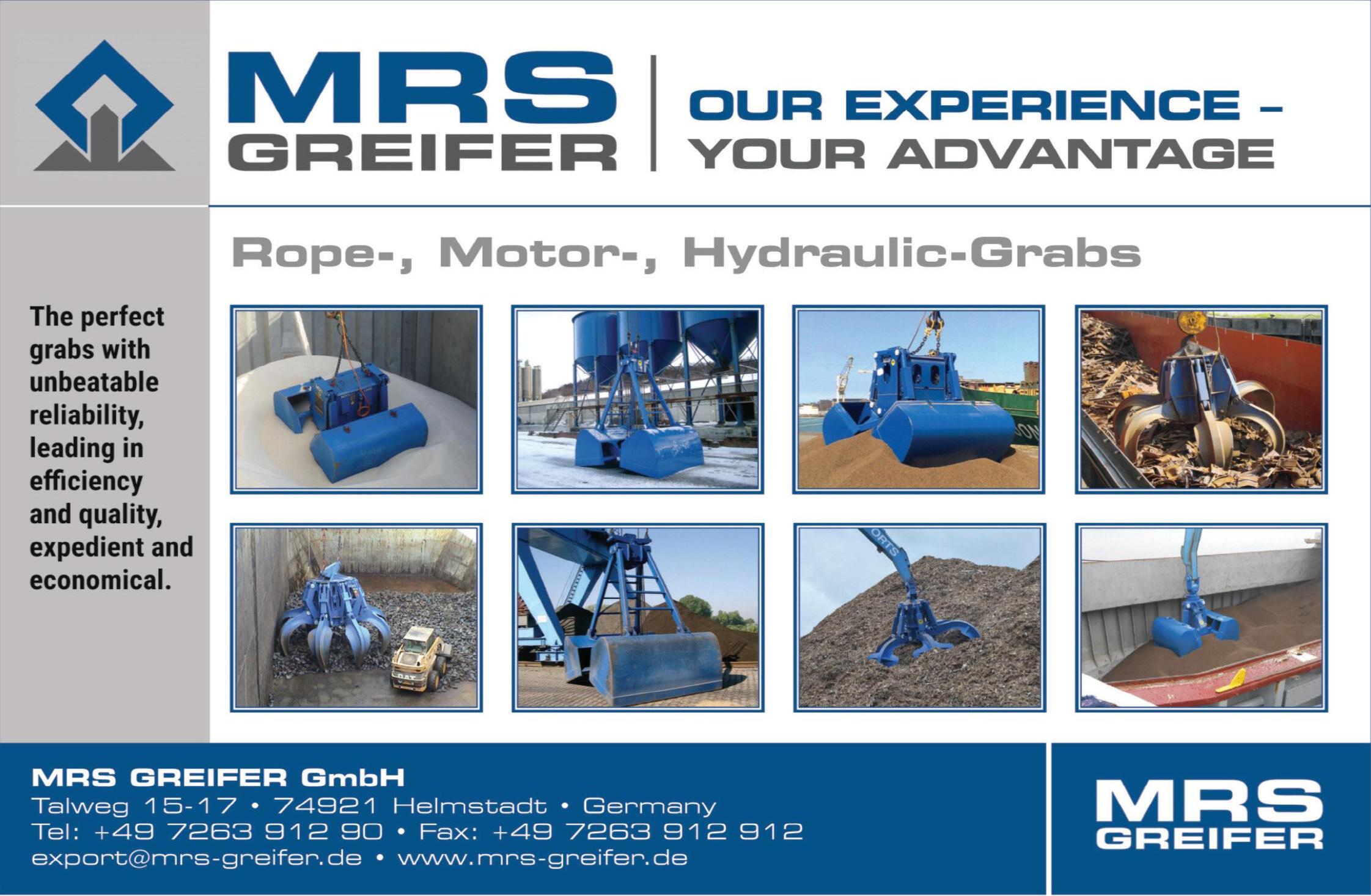
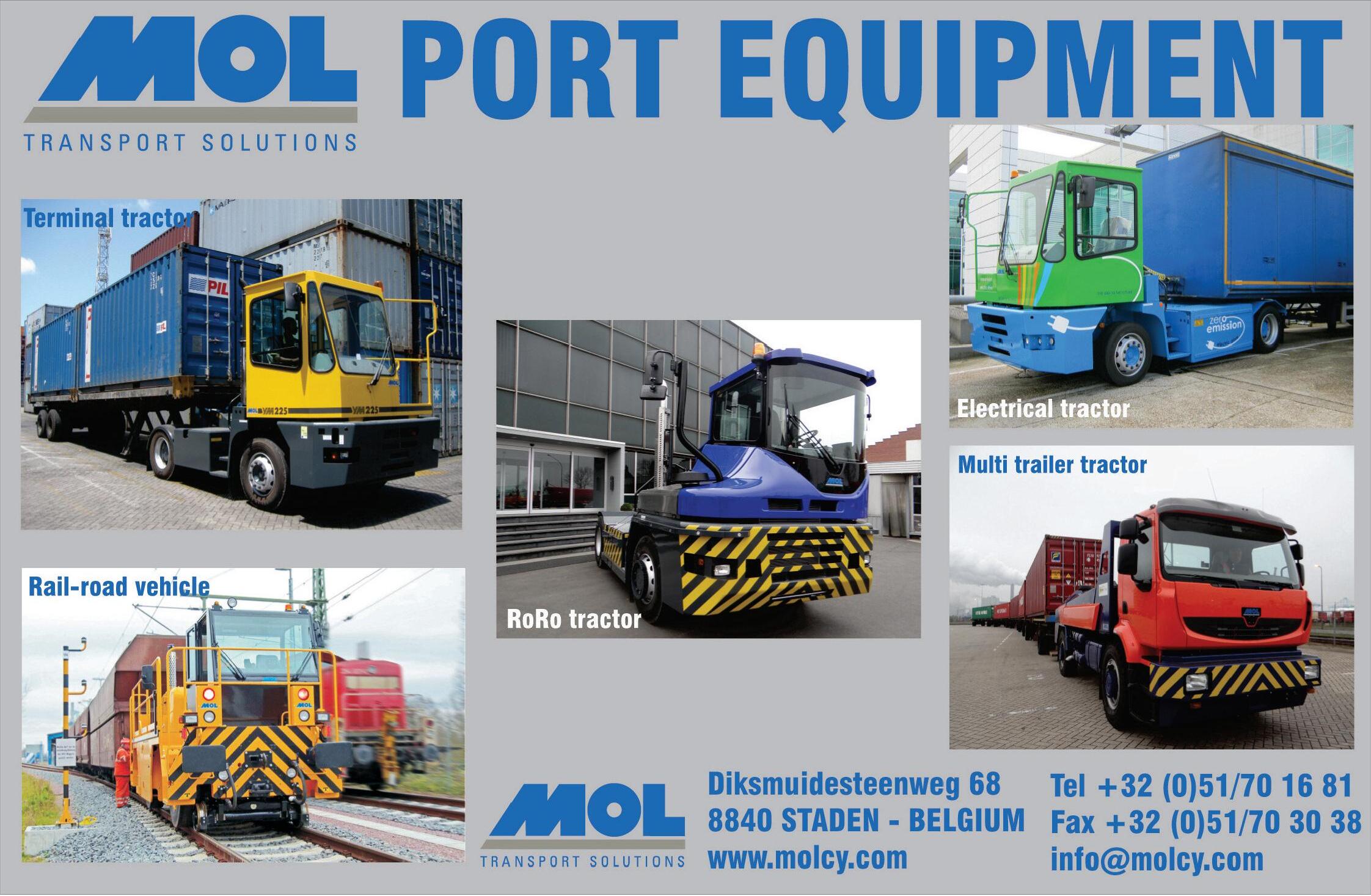
n e w s p o r t & t e r m i n a l World Port Development January/February 2023 14
VIP begins 2023 with cleanenerg y resources
Virginia Inland Por t (VIP) is fulfilling all of its operational electricity needs from clean energ y resources and in doing so moves The Por t of Virginia forward with its goal of reducing emissions and becoming carbonneutral by 2040 The inland por t gets its power from Rappahannock Electric Cooperative and through a new agreement the cooperative will provide clean electricity to VIP from Virginia-based solar installations. The clean energ y began flowing on Jan 1; VIP is the first of the por t’s six general cargo terminals to get 100% of its electricity from renewable sources “We have a clearly-stated goal of getting away from fossil fuel use and this is another impor tant step forward,” said Stephen Edwards, CEO and Executive Director of the Virginia Por t Authority (VPA)
“This por t is a modern, worldclass operation and we are overlaying it with a twenty-first century approach to sustainability This move helps reduce our contribution to global climate change and will help make us a leader among our US East Coast peers in terms of environmental sustainability ”
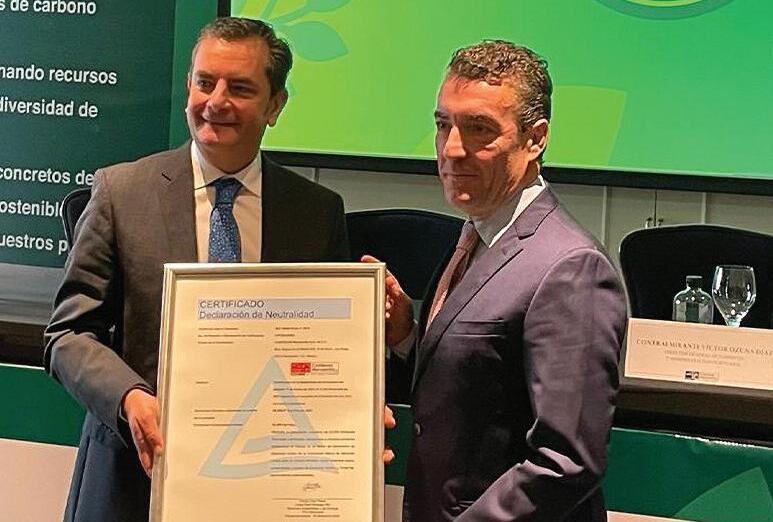

SC Por ts has record 2022 SC Por ts has record 2022
SC Por ts moved nearly 2 8m TEUs in 2022, a 1 5% increase over 2021. When accounting for containers of any size , SC Por ts moved more than 1 5 million pier containers in 2022, a 1% increase from 2021 “South Carolina’s excellent por t team and maritime community efficiently handled record cargo volumes and exper tly navigated supply chain challenges to keep freight moving for our customers,” SC Por ts President and CEO Barbara Melvin said Inland Por t Greer and Inland Por t Dillon handled a combined 167,147 rail moves in 2022, enabling more companies throughout the Southeast to quickly move goods to and from the por t via rail
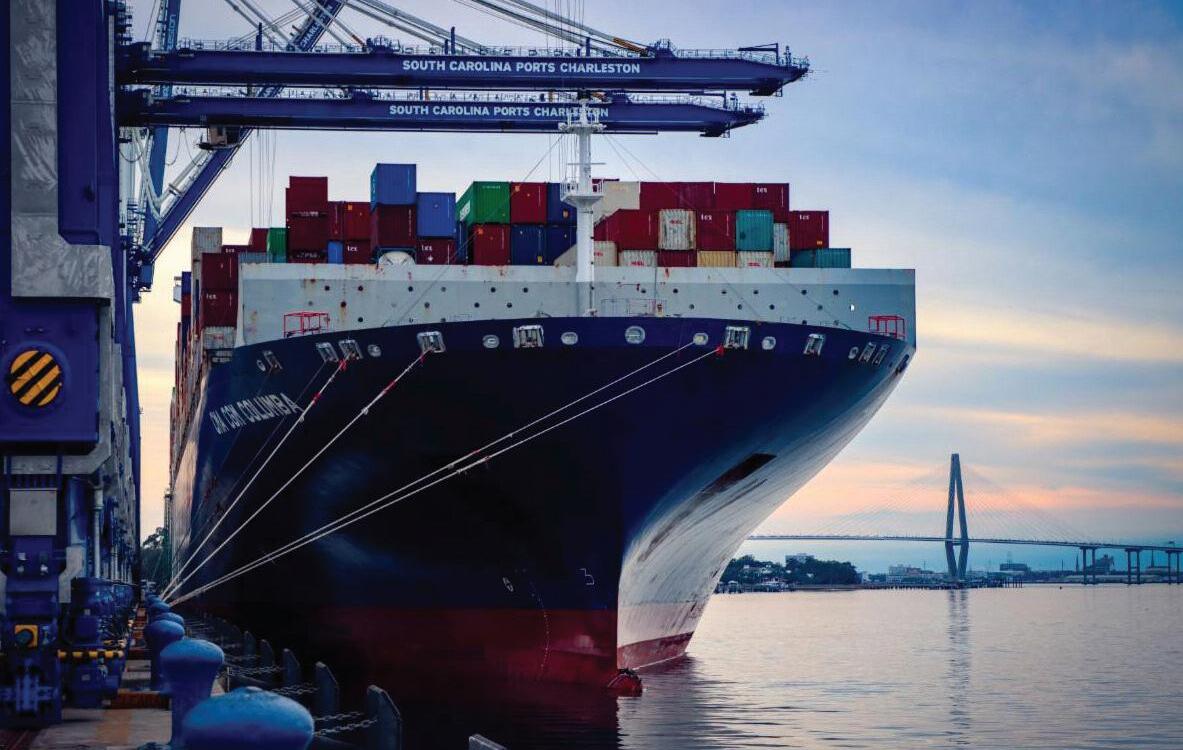
HOPA Por ts records strong season despite
At the conclusion of the 2022 shipping season, Hamilton-Oshawa Por t Authority (HOPA) saw 10,366,810 metric tonnes (MT) of cargo transiting the por ts of Hamilton and Oshawa combined
A total of 628 vessels visited its two por ts during the season, 569 in Hamilton and 59 in Oshawa
In 2022, 9.8 million MT transited the Port of Hamilton Meanwhile, in Oshawa, 481,318 MT were recorded in 2022, moderately lower than 2021 totals as a result of lower finished steel and fer tiliser totals In 2022, HOPA completed major maintenance dredging at Oshawa, while also kicking off a major capital improvement project, which will see more than USD32 million invested
Everglades receives grant
for
sea rise infrastructure
Por t Everglades was awarded a USD32 million grant to mitigate environmental threats from flooding and sea level rise and ensure continued access for vessels The por t will use the money to replace bulkheads in the nor thern par t of the facility, to assist in reducing the impacts of climate change to the por t
Contecon Manzanillo is Mexico’s first carbon-neutral port Contecon Manzanillo S.A. de C .V. (Contecon Manzanillo), a business unit of International Container Terminal Ser vices, Inc (ICTSI) and concessionaire of the Specialised Container Terminal of the North Zone of the Por t of Manzanillo (TEC-II), is the first organisation across the Mexican por t industr y to be cer tified carbon neutral The Carbon Neutrality UNE-14064-3:2019 cer tification recognises Contecon Manzanillo’s commitment to global initiatives to combat climate change, promote renewable energ y and decarbonise por ts and maritime transpor t The carbon neutrality cer tificate highlights the company ’ s effor ts to offset greenhouse gas (GHG) emissions through reduction and compensation practices. José Antonio Contreras, Contecon Manzanillo CEO, explained the cer tification’s relevance not only for Mexico’s por t sector but also for industrial activity in general: “We are proud to be the first terminal in Mexico verified under this regulation. At Contecon, we are quite clear about maintaining an agenda aligned with our business in which climate change is combatted and the use of renewable energ y is encouraged More impor tantly, we are moving firmly towards the decarbonisation of por ts and maritime transpor t of Mexico Having this type of certification portrays us as an organisation that demonstrates commitment, talent and a real position for change in the face of environmental problems.”
n e w s p o r t & t e r m i n a l January/February 2023 World Port Development 15
Claire Instone brings readers insight into how Benelux ports remain stable.
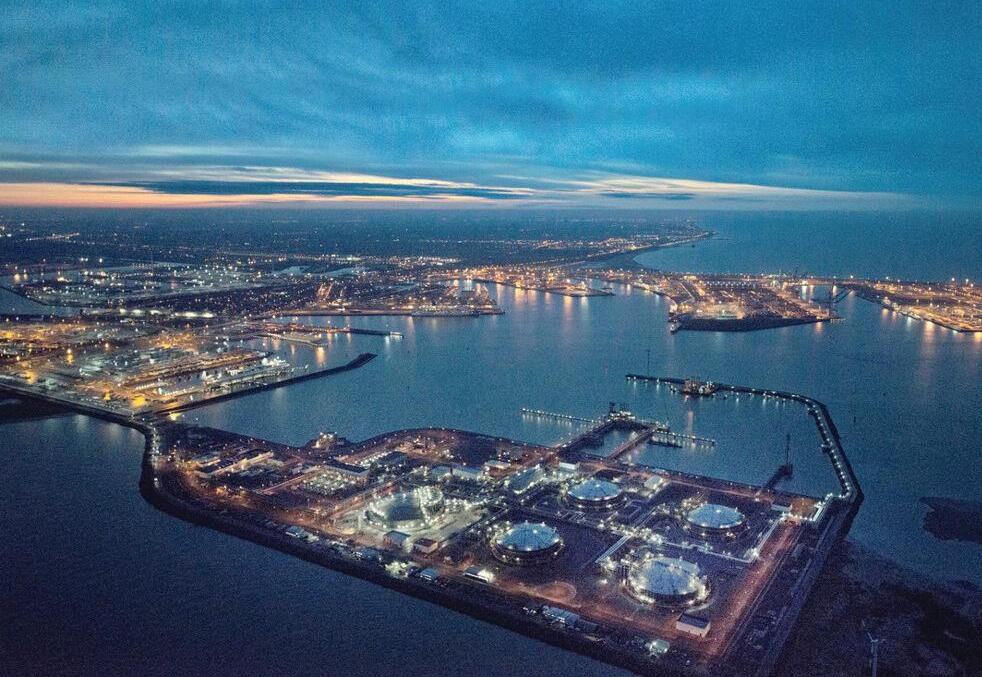
When reporting on the performance of Benelux por ts across 2021 in our last regional sur vey, we noted the por ts of Belgium and the Netherlands had pushed on through and achieved growth despite numerous challenges, from post-pandemic losses and Brexit to the British driver shortage and congestion problems. The expectation for 2022 was that any losses of the previous two years would be made up for, and - for the most par t - they have been.
The fact that the por ts of Antwerp-Bruges and Rotterdam achieved stable results, and Nor th Sea Por t experienced its best year since the merger back in 2018, is outstanding considering they have had to fight through a fresh new wave of difficulties including the fallout from the war in Ukraine, the sanctions against Russia, and the changes in global energy flows With no figures available at the time of print for the Por t of Amsterdam we are unable to share an update on the North Holland facility, however keep reading to see how other ports of the Benelux have remained steadfast despite myriad shocks to world trade in what continues to be uncer tain times
Antwerp-Bruges, Belgium
2022 was a big year for the por ts of Antwerp and Zeebrugge with the two facilities merging to form the Por t of Antwerp-Bruges. The agreement, finalised in April of last year, makes Antwerp-Bruges Europe’s largest expor t por t - with 147m tonnes per yearmaking it a global heavyweight Moreover, it is a leading container port by tonnage processing around 159m tonnes annually
“The fact that, despite the challenges, we also achieved so many successes in 2022 makes me ver y proud. 2022 was the year of the merger and therefore a historic year, ” says Dirk De fauw, Mayor of the City of Bruges and Vice President of Port of Antwerp-Bruges. Reflecting on the facility’s performance across 2022 shows it was a year of challenges, however Antwerp-Bruges held its own amid geopolitical difficulties, the energ y crisis and ongoing disruptions in supply chains
“2022 was, once again, an eventful year. As a world por t, we are at the centre of this drama and are holding up well With our strong international position, we can make a difference in challenges such as the energ y transition Together with our par tners and thanks to financial suppor t, such as the
impor tant European funding of 500 million euros for the Antwerp and Kairois@C projects, we can live up to our pioneering role , ” states Jacques Vandermeiren, the CEO of Por t of Antwerp-Bruges Despite the issues faced, throughput was only down 0.7% year-on-year to 286 9 million tonnes of cargo The challenges were most palpable in container traffic Global disruptions within container shipping, and the resulting congestion with peak call sizes and delays, put pressure on volumes throughout the year In addition, the conflict in Ukraine caused a decrease in Russia-related traffic by 59% And while operational challenges at container terminals and congestion have been slowly easing since the third quar ter, high energ y prices and economic uncer tainty have caused a slowdown in demand for container traffic As a result, container throughput fell 8.6% in tons and 5.2% in TEUs in 2022, compared with a strong 2021, back to pre-pandemic levels

The war in Ukraine , the sanctions against Russia and the energ y crisis greatly changed the energ y landscape and flows in Europe , which translated into strong growth in bulk Dry bulk throughput increased 13 8% in 2022 The liquid bulk segment grew 10%, mainly due to a 61.3% increase in demand for LNG as an alternative to natural gas via pipelines from Russia After record figures in 2021, conventional breakbulk (+1.1%) held up well in the first half of the year due to growth in the throughput of steel As for roll-on/roll-off, traffic saw a rise of 6.5%.
As for what the coming year has in store , a flood of new investments and projects since the merger confirms the attractiveness and added value of the unified por t The resilience of both por t platforms has allowed impor tant steps to be taken in projects that contribute to the por t’s sustainable growth and role in the energ y transition The projects are ready to be further rolled out this year. The hydrogen strategy to make the port a European hydrogen hub for the impor t, local production and throughput of green hydrogen and hydrogen carriers will be fur ther refined.
Moreover, the completion of the first par t of the NextGen District, the future hotspot for the circular economy, is almost complete and the first spade will go into the ground soon In addition, as par t of the por t’s ‘greening’ of its fleet, the Hydrotug and Methatug, the world's first hydrogen and methanol-fuelled tugs, are making an appearance
World Port Development January/February 2023 16 p o r t s u r v e y b e n e l u x U n s h a k e a b l e t e n a c i t y i n u n c e r t a i n t i m e s
And the Digital Twin, the digital copy of the por t area with real-time info via sensors, drones and smar t cameras, will be deployed on both platforms in the coming months to fur ther build a smar t, safe and smoothlyoperated port. “We are confident that in 2023 we can continue to focus on sustainable economic growth; certainly thanks to the many investments announced by our companies,” confirms Annick De Ridder, Vice-Mayor of the City of Antwerp and President of the board of directors of Port of Antwerp-Bruges The port is cer tainly well on its way to anchoring its position as a green energy hub and shaping the energy transition towards a sustainable future
Rotterdam, the Netherlands
At the time of print, full year statistics for 2022 for the Por t of Rotterdam were not available

However, we know from the por t’s state of address and figures from the first nine months of last year that Europe’s largest seaport had an extraordinary year with level throughput results.
“We are proud that - despite all the disruption - the por t of Rotterdam has continued to thrive in close cooperation with our clients and partners Our investments have increased, with the focus on, among other things, fur thering the use of renewable energ y sources such as hydrogen and biofuels. With the reclamation of 55 hectares of new land on Maasvlakte 2, we are creating space for sustainable companies,” confirms Allard Castelein, CEO “It is wonderful that we have been able to demonstrate our flexibility and resilience as a por t complex.”
Despite seeing major changes in goods flows, throughput at Rotterdam remained at the same level as last year for the first nine months of the year - 351 million tonnes (+0 3%) However, there were some major underlying differences, especially due to the war in Ukraine , the sanctions against Russia, and the changes in global energ y flows For instance , considerably higher volumes of coal and LNG were impor ted as alternatives to Russian gas Container trans-shipment decreased, especially as a result of the loss of trade with Russia
“The total volume makes it seem as if it is business as usual in the port, but the big changes, especially with respect to LNG and coal, indicate that the energy landscape has changed dramatically With the high energ y prices the energy-intensive chemical industry in particular is going through hard times. A faster energ y transition makes us less dependent on geopolitical developments in the long term,” states Castelein
Looking at other segments shows dr y bulk experienced a drop of -17 9% in iron and scrap, as did the throughput of agribulk (-14.8). On the flip side, coal volume increased (+24 8%), while other bulk, such as raw materials and building materials, also jumped sharply (+22.6%). As for liquid bulk, the overall increase was 3 9% As for containers, the segment dropped 8 6% in total weight and 4 4% in terms of TEUs in the first nine months. As a consequence of the sanctions, container traffic between Russia and Rotterdam has almost come to a standstill In the past few years, about 8% of container traffic was related to Russia The difference between tonnes (-8 6%) and TEUs (-4 4%) is because proportionally more empty containers found their way via Rotterdam
As for trans-shipment, the Por t of Rotterdam expects volumes for 2022 to be of the same level as that of the year prior One thing that is for cer tain when it comes to figures for 2022 is Rotterdam’s position as Europe’s leading bunker por t Last year, maritime shipping bunkered significantly more fuel in Rotterdam; 10.8 million compared to 10.2 million up to 2021 With that, demand for fuel oil, gas oil, methanol and LNG was 6 3 percent higher than in 2021
With an eye on the future,Vivienne de Leeuw, CFO Por t of Rotterdam Authority, believes the por t’s robust financial position is essential to continue investing in traditional hardware such as quay walls and jetties in the years ahead, but particularly in infrastructure for the energy transition “By maintaining our position as a por t with world-class infrastructure , we are ensuring that we remain an attractive location for companies to invest in the transition.”
Nor th Sea Por t, Belgium and the Netherlands
With 73 6 million tons of cargo trans-shipment from maritime shipping (+7%) and 64 5 million tons from inland shipping (+7%) in 2022, companies in Nor th Sea Por t experienced their best year since the merger in 2018 Moreover, dr y bulk continues to increase and the US replaced Russia as the biggest trading par tner
“With another record year, Nor th Sea Por t is cementing its position as the number ten por t in Europe That’s pretty remarkable after Brexit, two years of the pandemic , the impact of the Ukraine-Russia war and the energ y crisis,” states Daan Schalck, CEO of Nor th Sea Por t

Five years ago, Zeeland Sea Por ts (Vlissingen and Terneuzen) in the Netherlands and the Flemish/Belgian Por t of Ghent merged to form a single por t Nor th Sea Por t became the new brand name of the 60-kilometer-long cross-border Dutch-Flemish por t. It instantly became one of Europe’s top ten por ts
“Our aim was to grow in various areas to make sure we could maintain that position as a newly established por t, and indeed to continue our development into a top European por t. With a new record year since the merger five years ago, the companies in the por t have fur ther cemented that,” continues Schalck.
Nor th Sea Por t has traditionally always been a bulk por t Dr y bulk continues to show marked growth, even compared to the pre-Covid period Liquid bulk and general cargo remain below their pre-Covid levels In 2022, dr y bulk again accounted for more than half of seaborne cargo trans-shipment: 54% (39 9m tons, +10% compared to 2021) Liquid bulk accounted for 24% of the total (17 6 million tons, +5%) Meanwhile , the share of break bulk was 14% (10 million tons, +5%) with roll on/roll off growing 5% (3 7 million tons, +2%).
As for containers, they made up 3% of seaborne cargo trans-shipment (2.6 million tons, -9%) There was also a fall in terms of TEUs to 230,000 (-31,000 TEUs) Setting a new record last year was inland navigation trans-shipment coming in at 64 5 million tons, up 7% (on top of a 9% increase in 2021) Impor ts increased by 8%, expor ts by 7% The impor t-expor t ratio was 41%-59%. With a seaborne trans-shipment volume of 73 6 million tons and 64 5 million tons of cargo trans-shipped via inland navigation, North Sea Port recorded a total trans-shipment of 138 1 million tons in 2022, compared to 129.1 million tons in 2021.
As for its forecast and outlook for 2023, Nor th Sea Por t expects it to be less of a bumper year, but still a solid one , with seaborne cargo trans-shipment experiencing similar volumes in the four quar ters, well above 70 million tons. The hope is that energ y prices will fall and that investment will continue at a similar level
In a world transformed by Brexit, corona, war and energ y prices, por ts of the Benelux are showing unshakeable tenacity
January/February 2023 World Port Development 17 p o r t s u r v e y b e n e l u x
por ts are moving up a gearand the biggest Pacific por t is leading the way
Mexico’s por ts are moving up a gearand the biggest Pacific por t is leading the way
Gordon Feller reports on Mexican Ports.
Boasting close to 6,000 miles of coastline , with 102 por ts and 15 terminals, Mexico is the world’s 11th-leading expor ter The countr y ’ s por ts and terminals are connected to more than 145 countries, bolstered by Mexico’s free trade agreements with over 40 countries, including China, the EU, the US, Japan and Israel.
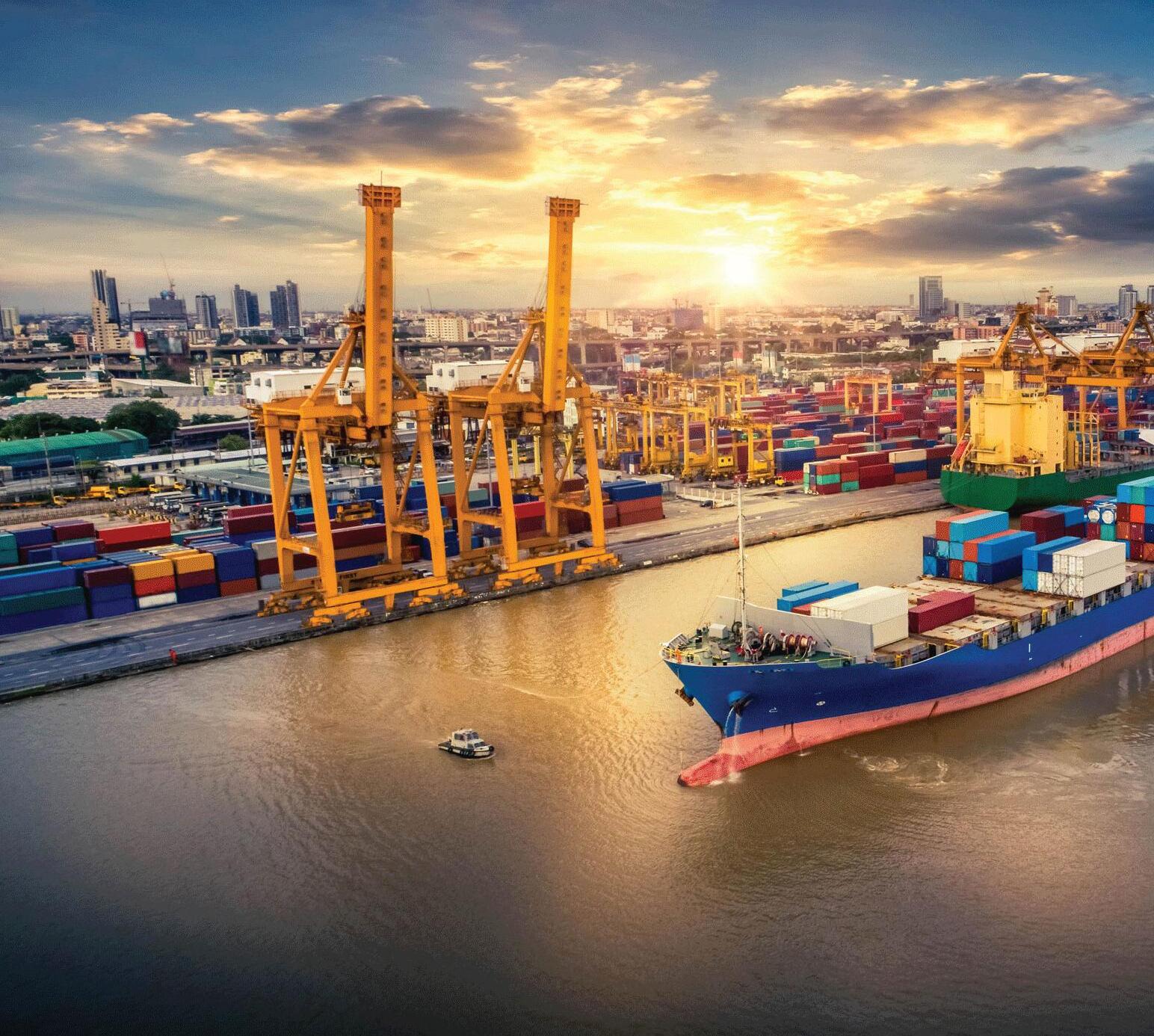
Some of Mexico’s leading por ts are now undergoing expansions and redevelopment. One impetus for this wave of activity was a series of legislative changes promoted by Mexican President Andres Manuel Lopez Obrador. It was in 2021 that his moves aimed to prevent a continuation of the mismanagement, corruption, and smuggling
which was occurring at customs.The government decided to transfer the management of por ts from the Ministr y of Communications and Transpor t (SCT) to the Secretariat of the Navy (SEMAR) It was in June of 2021 that “inter-secretarial cooperation mechanisms” were established for the operation of the National Por t System (SPN) to facilitate the transfer of power

The resources of the General Coordination of Por ts and Merchant Marine (CGPMM) of the former SCT were subsequently passed to SEMAR, which now grants por t concessions as the regulatory authority It approves master plans ever y five years, and obtains six percent of revenues which flow to the ASIPONAS (Mexico’s port managers). These can be owned by the federal or state government They are constituted as “priority public companies” -
and they are responsible for managing the awarded operating rights; implementing master plans, programming; development; use and exploitation of the por t within the framework of a concession They are designed to (ideally) be self-sufficient, and productive , and competitive .
According to the central government’s 2022 Federal Expenditure Budget Project, ASIPONAS will have a budget of MX$2.4 billion (approximately US$118 4 million), 10 percent below the budget approved for last year. ASISPONAS currently have 48 open projects for the development and conser vation of infrastructure with public resources Business lines mainly include fluids, petroleum, containers, automotive , agricultural and mineral bulk, general cargo and cruise
World Port Development January/February 2023 18 p o r t s u r v e y m e x i c o
Mexico’s
SSA Mexico, one of the Pacific coast’s major operators, has announced plans to invest $30 million in eight new cranes for its container terminal at the Por t of Manzanillo. This one terminal traffic accounted for 30% of traffic handled at all of Mexico’s Pacific por ts, with an annual growth rate of 10%.
The Por t of Manzanillo is located in Mexico’s State of Colima It ranks first amongst all of the Mexican por ts, with the highest throughput in 2022, having handled roughly 2 68 million metric tons of cargo As Mexico’s largest container por t, Por t of Manzanillo ser ves as the primar y threshold for international trade with Mexico, the por t handles an average cargo tonnage of 2.2 million TEUs. The facility opened in 1825 and became a city in 1873. Economic growth in the area expanded, and especially so with the completion of a railroad
to Colima in 1889. In 1908 the city was officially designated as a por t of entr y to the countr y Interestingly, the city had a brief stint as the Capital of Mexico, for less than a month in 1915, while Pancho Villa’s troops threatened to capture the City of Colima
The modern histor y of The Port of Manzanillo begins in 1971, after Mexico’s government created the National Commission for Por t Coordination in order to improve the relationship with workers
To suppor t these effor ts, the National Commission took charge of increasing the por t’s handling speeds by obtaining new equipment. Subsequently, productivity has improved significantly, and in the last 40 years, the Por t of Manzanillo has seen unprecedented efficiency

As a result, it was in 2017 that Mexico’s shipping por ts, including Manzanillo, were growing at a faster pace than both the US and Canada. This makes Mexico’s ports the fastest-growing in Nor th America This trend of rapid growth continued. The Por t of Manzanillo’s strategic location on the Pacific coast makes it a prime gateway for Asian impor ters and expor ters Additional expor ts from this por t go to the US, Canada, Guatemala, Colombia, Chile , Spain, Russia, and Germany
The por t’s most recent expansions include both a new Specialised Container Terminal and a Multi-Purpose Terminal These terminals feature capacities of 13.6 million tons and 2 46 million tons, respectively Additionally, a new railway tunnel enabling 24-hour direct railroad access, the Manzanillo Freight tunnel, opened in June of 2018.
Manzanillo is considered the most impor tant and active multipurpose por t in Mexico due to its specialised terminal for containers, general cargo, agricultural and bulk minerals, vehicles, perishables, and cruise ships. As the leading Latin American container por t in the Pacific Ocean, the port has specialised terminals to receive sixth-generation container ships up to 360 meters in length, with a capacity of 13,400 TEUs Terminals and facilities are entrusted to national and foreign private companies for an average of 20 years.
The main por t ser vices that will be required are ser vices to vessels to carr y out their operations internally, as well as por t manoeuvering ser vices and general ser vices The port’s master plan runs from 2021 to 2026, with a projected MX$11.3 billion (US$540 million) budget

The ser vice goals specified in the budget include the following: optimising the por t structure and equipment; expanding the por t’s concession for the development of new por t facilities and terminals’ promoting socially and environmentally sustainable development; maintenance; monitoring and upgrade of navigation channels; urban planning development; fnancial and legal feasibility studies aimed at developing private par ticipation processes - through public-private par tnerships
The Por t of Manzanillo’s growth, as well as its contributions to Mexico’s economy, has cemented its place as a major player in the global container shipping landscape

January/February 2023 World Port Development 19 p o r t s u r v e y m e x i c o
Port of Manzanillo
World Port Development reports.

The World Por ts Climate Action Programme (WPCAP) is a cooperation between the ports of Antwerp - Bruges, Barcelona, Gothenburg, Hamburg, HAROPA
PORT (Le Havre - Rouen - Paris), Long Beach, Los Angeles, New York / New Jersey, Rotterdam, Valencia, Vancouver and Yokohama
‘In addition to helping its 12 member por ts decarbonise , WPC AP has contributed to the faster adoption of sustainability standards and measures in the wider shipping industr y ’ That was the main take away from the four th meeting of CEO’s and working group members of WPCAP, which was founded almost 5 years ago to accelerate actions to combat climate change in the maritime sector
“Back then we felt it was unjust that the shipping industr y did not take par t in the Paris climate agreement and to address this, we star ted WPC AP together ” said Allard Castelein, CEO of the Por t of Rotterdam
“Today, this issue of climate change is top of mind with industr y leaders and other stakeholders alike and I am proud of the initiatives that we have implemented in the past years. I believe these have helped speed up the transition of the industr y at large and are testimony to our collaborative effor ts ”

The meeting focused on the work done to improve efficiency, aid the adoption of shore power, and accelerate the transition to clean shipping fuels. Members also discussed the decarbonisation of cargo-handling equipment, noting in par ticular the potential of hydrogen fuel cells as a zero-emission technolog y as this can deliver high performance with relatively low additional requirements for infrastructure investments.
Still large potential for global efficiency gains
Efficiency continues to be seen as low-hanging fruit for decarbonisation effor ts, and the significant progress made in setting standards to improve efficiency has elicited positive responses from both WPC AP members and the wider shipping community The WPC AP working group focused on the top efficiency measures identified in a sur vey among almost 600 exper ts from more than 100 countries Members collaborated with the IMO to calculate
the CO2 impact of different efficiency measures and developed a guide and standards for ports to implement just-in-time arrivals and deliver significant fuel savings In addition, the members worked with the International Hydrographic Organization (IHO) and other bodies to develop a platform for sharing nautical data between ports, improve ship-berth compatibility and fur ther improve efficiency
Ben van Scherpenzeel, Chairman of the Efficiency Working Group and Director Nautical Developments at the Por t of Rotterdam, noted that both the IMO and ship operators welcomed the measures as they help with planning operations more efficiently, saving fuel costs and reducing emissions He concluded that that there is still a lot of potential for fur ther efficiency gains by rolling out the new tools beyond the WPC AP network, at por ts across the globe
Shore power adoption continues to rise
Of all the topics discussed, shore power saw perhaps the biggest change in attitude in the shipping industr y in the past five years, thanks in part to the work done by WPCAP members. Jarl Schoemaker, Chair of the Power-to-Ship Working Group and Senior Advisor Environmental Management at the Por t of Rotterdam, noted that while shore power has been around for a long time , the roll-out was traditionally hampered by high investment cost due to low adoption rates
To help create a breakthrough in shore power adaption, WPCAP members made an inventory of available technolog y and exchanged best practices and demonstrated the benefits of collaboration which resulted in an MoU on the use of shore power for container vessels and cruise ships by 2028 They also commissioned a joint study, which showed that even with the rise of alternative fuels from renewable sources, shore power is likely to remain the best option to reduce emissions from large vessels
Jarl noted that shore power is increasingly recognised by regulators and policy makers as a key instrument for reducing emissions and improving air quality, including in the EU, leading to higher adoption rates and lower cost. This provides an oppor tunity to fur ther team-up with IAPH in engaging with IMO to address remaining challenges and stimulate a progressive worldwide roll-out of shore power
Port readiness for clean shipping fuels
The transition towards clean shipping fuels was a big topic for all WPC AP members and is expected to be the main focus of multiple initiatives in the coming years, including Green Corridor projects launched by several WPCAP members across the globe .Barriers to wider adoption of clean fuels include uncer tainties around fuel availability, concerns about infrastructure and the technical readiness at individual por ts To address this, members joined forces with the IAPH Clean Marine Fuels working group to develop an assessment and communications tool to align global conversations about the availability of clean fuels at por ts
“It is impor tant for por ts to be able to say to ship owners: ‘ we will be ready with this fuel, at this time , and this is what you can expect from us ’ - and this tool does just that,” said Namrata Nadkarni, Chair of the Working Group on Sustainable Marine Fuels and Founder of Maritime Consultancy Intent Communications. “The Por t Readiness Framework allows you to communicate to all stakeholders where you are in the journey to supply new sustainable fuels or allow vessels using these fuels to bunker - from the research phase, to development and finally, deployment and bunkering of new fuels ”
The group is now focused on providing additional guidance and assessment sheets for ports to apply the framework to their efforts. Beyond this, an online tool can be development for voluntary self-assessment of port readiness In the long run, the working group also sees potential for cer tification according to the new standards, although more thinking would be required on the exact implementation first WPC AP members commented the new tool is a unique instrument and has the potential to significantly accelerate the transition to clean fuels, starting around specific Green Corridors.
Force for good
Castelein concluded that WPC AP has helped to create the momentum needed to address climate change in the industr y He invited all members to meet in Rotterdam in May 2023, to discuss the future of the WPCAP programme. “We tr y to move faster by collaborating, exchanging best practices with other por ts, and reaching out to others outside our network. If we continue to work together, are vocal and show our aspirations, we have the opportunity to be a force for good,” he said
World Port Development January/February 2023 20 p o r t s u r v e y s u s t a i n a b i l i t y
W P C A P : C r e a t i n g g l o b a l m o m e n t u m f o r s u s t a i n a b l e s h i p p i n g
Proposed new US legislation might affect the US crane industry. Thomas Francis reports….
At the end of January 2023, Republican US Representative Carlos Gimenez, whose district is south of the Por t of Miami, introduced the Por t Crane Security and Inspection Act of 2022 to Congress, which was referred to the Committee on Homeland Security, and might cause severe disruptions at US Por ts
Although the Bill did not receive a vote , its provisions could become law by being included in another Bill. It is common for legislative text to be introduced concurrently in multiple Bills (called companion Bills), re-introduced in subsequent sessions of Congress in new Bills, or added to larger Bills (sometimes called omnibus Bills) The Bill must be passed by both the House and Senate in identical form and then be signed by the President to become law.
This new Bill proposes strict new prohibition on the purchase and operation of the world’s most popular container cranes It effectively bans container cranes sold under contracts with countries considered a foreign adversar y, which includes China, the world’s largest manufacturer of STS container cranes, from operating at US Por ts
In addition, within five years after the law is enacted, operators of such cranes already in the US would be required to remove any software manufactured by countries covered under the ban that connects the cranes to the por ts’ cyber infrastructure
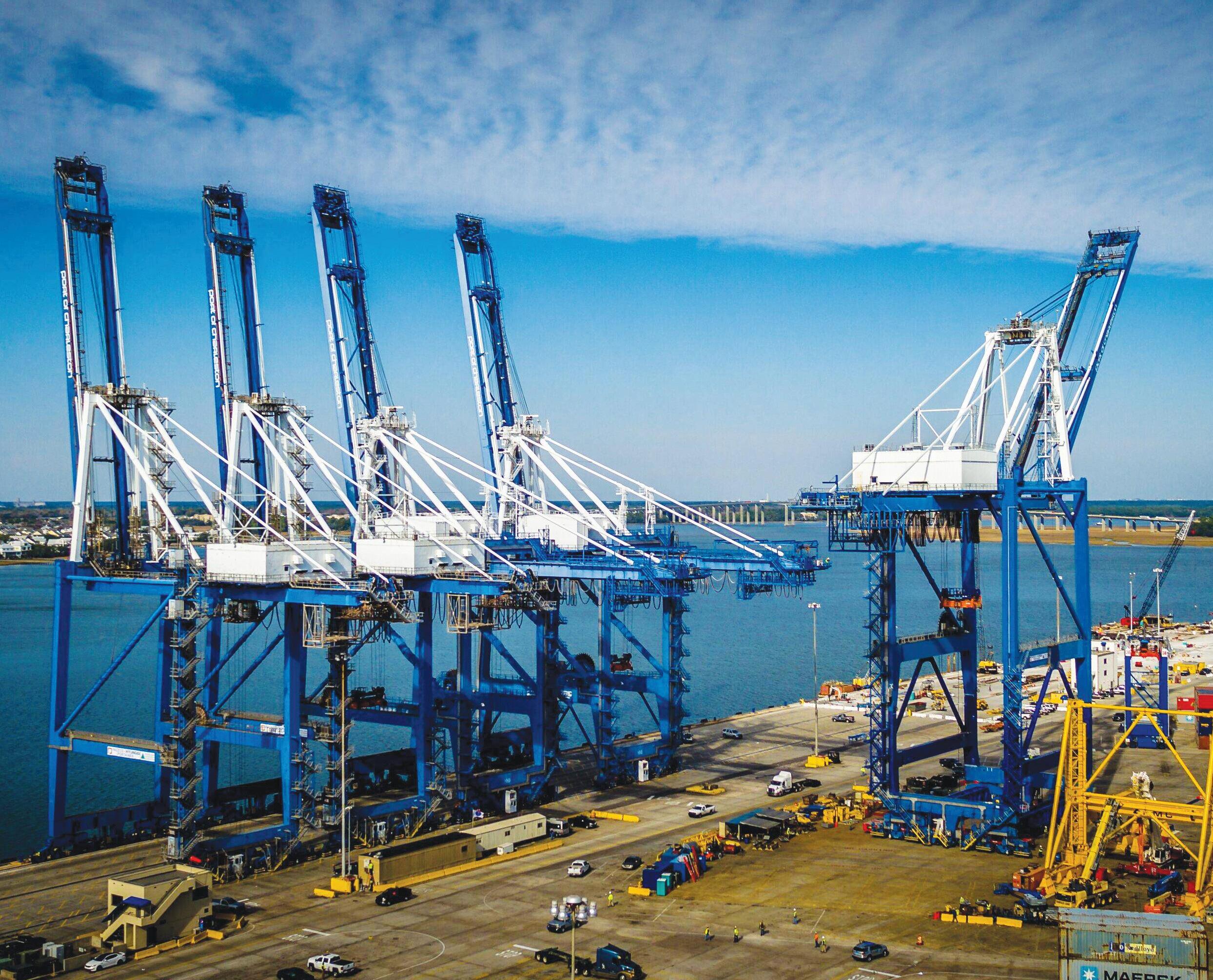
The legislation also states that cranes purchased from China that had been scheduled for deliver y at US por ts and determined by the US Depar tment of Homeland Security “to be of high risk to por t security or maritime transportation security” must be inspected by the Cybersecurity and Infrastructure Security
Agency (CISA) for “potential security vulnerabilities” before they can begin operating

Several analysts told World Por t Development that the Bill is a direct hit on Chinese statecontrolled ZPMC It is estimated that ZPMC ‘controls’ at least 70% of the global container crane market for post-Panamax-size ships and larger, as the company is unburdened by the same profit-turning pressures of its international competitors This means that ZPMC can offer significant below-market prices for container cranes that typically cost around USD10 million to USD12 million or more . ZPMC cranes are currently operating at the largest US container ports, including Los Angeles, New York, Virginia, Baltimore, Seattle, Miami, Houston, Charleston, South Carolina, and Tampa
The Bill is also clear as it explains that the term ‘‘foreign crane ’’ applies to a crane for which any software or other technology is connected into cyber infrastructure at a por t located in
January/February 2023 World Port Development 21 c o n t a i n e r p o r t c r a n e s e c u r i t y
P r o b l e m s a h e a d ? P r o b l e m s a h e a d ?
the United States was, in whole or in par t, manufactured by an entity that is owned or controlled by, is a subsidiary of, or is otherwise related legally or financially to a corporation based in a covered foreign countr y


Such terminolog y could present logistical problems for public and private container operators in these por ts To no longer be able to operate the crane (with the current software) within five years would severely impact landside operations and ultimately the general public .
In addition, installing new software on these cranes and getting them approved by Homeland Security might not be easy These cranes are a major investment for many operators and to have them not working will not only be costly, it will cer tainly have a knock-on effect on the supply chain
There is also doubt if the Secretar y of Homeland Security, acting through the Cybersecurity and Infrastructure Security Agency (CISA), is capable of inspecting each and ever y crane before it is placed into ser vice at a por t or terminal Another concern raised is if CISA would be able to
inspect each crane for the potential security vulnerabilities within the allocated 8 hour window offered by the terminal operator, as they certainly don’t want to have these cranes out of action for much longer
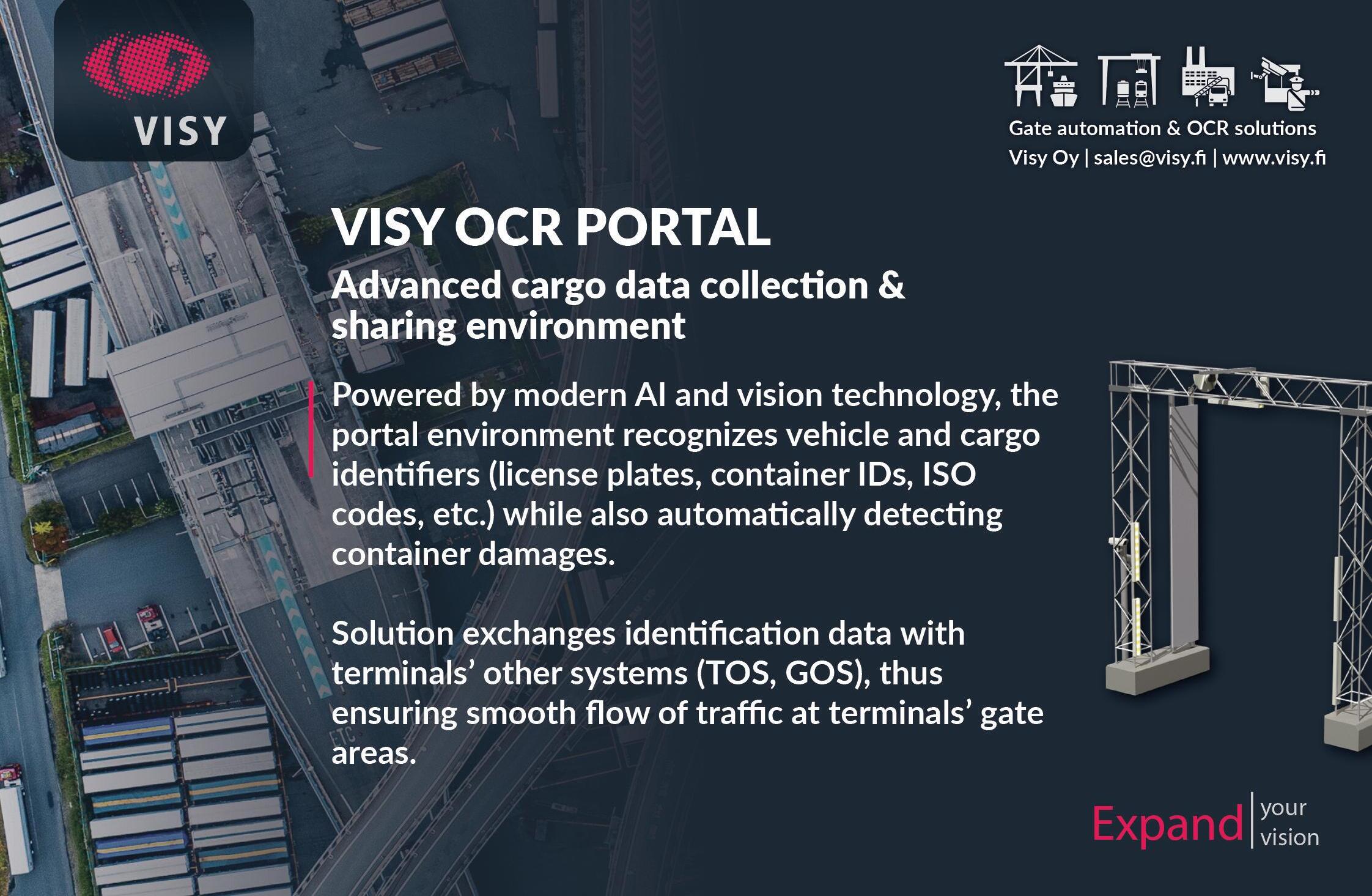
Therefore , it is clear that Homeland Security can’t rely on CISA’s availability and should consider the alternative of allowing third par ties to complete such inspections.
And another Bill…
To soften the impact of the Por t Crane Security and Inspection Act of 2022, Gimenez also introduced a fur ther Bill - the Por t Cranes for America Act. This Bill would see the creation and availability of a grant programme for US terminal/por t operators that would pay up to 80% of the cost of a container crane with a lifting capacity of more than 50 tonnes.
So, for ports looking to expand their operations, the companion legislation would offset higher costs that could result from a potential bump in the price of a container crane due to ZPMC effectively being shut out of the US market, as well as pay for software replacement costs At first sight it seems a good idea to have one Bill compensating a significant offset of the
costs with another Bill, but would it work in practice, and in particular with Federal agencies that don’t hold a strong track record of coordination with other Federal agencies? Would that increase the chances of inconsistent grant awards? For example , the legislation gives the US Maritime Administration (MARAD) the authority to issue the grants when the Federal Emergency Management Administration (FEMA) currently administers the Port Security Grant Programme So for example, if a terminal or por t operator applies for a grant for new crane equipment and this has been approved by FEMA, MARAD may not actually grant the new equipment, or vice versa
All in all it is obvious that ZPMC is the apparent target of the legislation and would potentially see a market hit in the US, as US ports continue to expand. Other crane manufacturers not on the ‘US hit list’ will greatly benefit from such legislation for obvious reasons Overall, there is a general concern that the new legislation might hit US por ts and the logistical supply chain hard and that is something the industr y can do without.
World Port Development January/February 2023 22 c o n t a i n e r p o r t c r a n e s e c u r i t y
Photo caption: Back in 2019 ZPMC delivered several STS container cranes to the Port of Charleston
Despite the impact of COVID, a shortage of OEM parts, and the impact of the war in Ukraine on the logistical supply chain, the port industry continues to be served by crane manufacturers that listen and deliver as Thomas Francis reports….
There is no doubt that in the last couple of decades the por ts industr y has witnessed a huge growth in container throughput, par tly due to the availability of high-tech container handling equipment, such as ship-to-shore container cranes that have improved drastically Driven by the requirements of por t and terminal operators alike , we have not only seen improvements in speed, safety and productivity, but also some innovative crane design
In addition, over the last couple of years global maritime trade was affected by the COVID pandemic with many por t authorities and terminal operators repor ting a considerable fall in their overall container throughput But since last year, when many countries reported that (travel and working) COVID restrictions were lifted, we have seen a steady increase in international maritime trade with many por ts reporting huge increases in container throughput
For example, in January 2023, the Georgia Ports Authority, USA, announced that the Por t of

Savannah handled a record 5 9 million TEUs in 2022 - an increase of 5% compared to 2021 And in February, the port authority announced that container exports grew by 21% in January handling a total of 110,305 TEUs - an increase of 19,419 TEUs. In that same month, the por t also took deliver y of four new STS container cranes manufactured by Konecranes
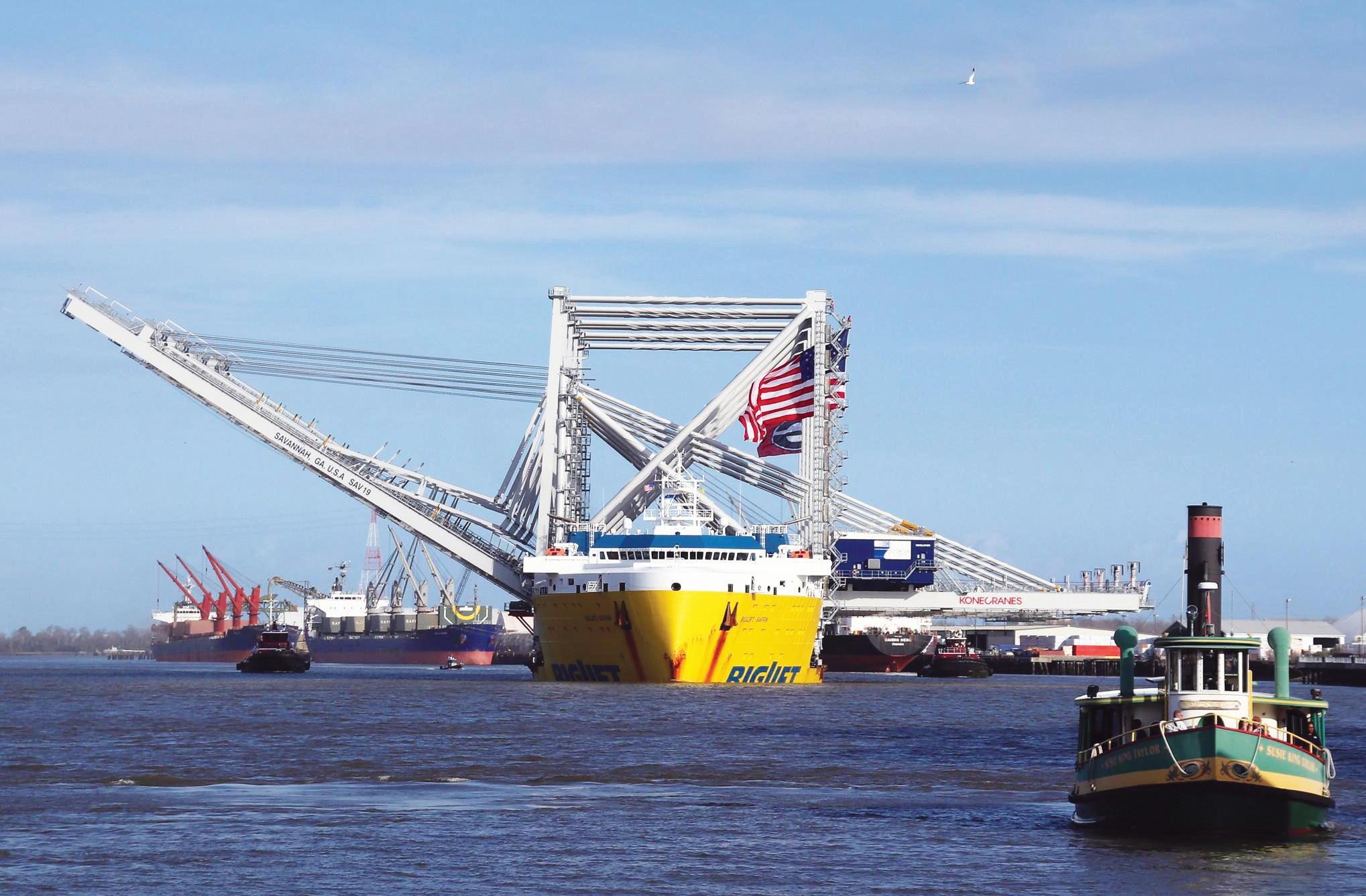
But in a market in which we have only a handful of STS container crane manufacturers worldwide , and dominated by the Chinese manufacturer ZPMC, a surprise announcement was made by Finland-based Cargotec early last year The company announced that its por t equipment brand Kalmar, would exit the heavy crane business and instead focus on mobile solutions, following the cancellation of their proposed merger with fellow Finland-based Konecranes
The announcement made it clear that it intended to either sell Kalmar’s heavy duty cranes segment or, if it couldn’t find a buyer, shut down its production of rubber-tyred gantry (RTG) cranes, rail-mounted gantry (RMG) cranes, automated stacking cranes (ASCs) and ship-to-shore (STS) container cranes
A couple of months later (in July 2022) Cargotec announced that Kalmar and the partner in their Chinese joint venture , Rainbow
Industries, entered into an agreement that saw Kalmar transferring all of their heavy cranes ’ related intellectual proper ties (IP) and assets to Rainbow This decision might have caused some worr ying times for the main European crane manufacturers including Konecranes, Ireland-based Liebherr Container Cranes and Austrian-based Kuenz
Fortunately, one year on, the sale of the IP and assets to Rainbow seems not to have impacted the market at all Perhaps a lack of sales, distribution and service network beyond China might have hampered the company in their attempts to enter the global market but so far it seems they are satisfied with ser vicing the local market - at least for now
So, with Kalmar ‘out of the way ’ and no worries about Rainbow Industries, the other crane manufacturers have been busy with new oppor tunities in a (still) competitive market
“The volume of enquiries from our existing customers and from the market remains at a consistently high level,” says Trevor O’Donoghue, Marketing Manager at Liebherr Container Cranes Ltd “We continue to fur ther develop and innovate our range of cranes with new designs and updated systems. For example , automation and remote control of Liebherr STS cranes are increasingly requested and we
H i g h -
c
e
e i g
s January/February 2023 World Port Development 23 c o n t a i n e r c r a n e d e s i g n
BigLift Baffin on the Savannah River loaded with four Konecranes STS container cranes
t e
h r e a c h e s n
w h
h t
have a number of recent and ongoing orders where automation and remote control are incorporated ”

Last year, Liebherr Container Cranes built three STS container cranes for Maher Terminals in the Port of New York and New Jersey, USA In this instance, fully assembled deliver y wasn’t possible because the cranes had to pass under a series of relatively low bridges that prohibited fully assembled delivery Instead, Liebherr partly assembled the cranes and shipped them with the main boom and beam resting on the sill beams for the voyage Once the cranes were unloaded in the US, they winched the boom and beam into position The project as a whole required detailed planning and innovative engineering, and the passage of the cranes under the Bayonne bridge with only 40cm to spare (and well within limits) was a success
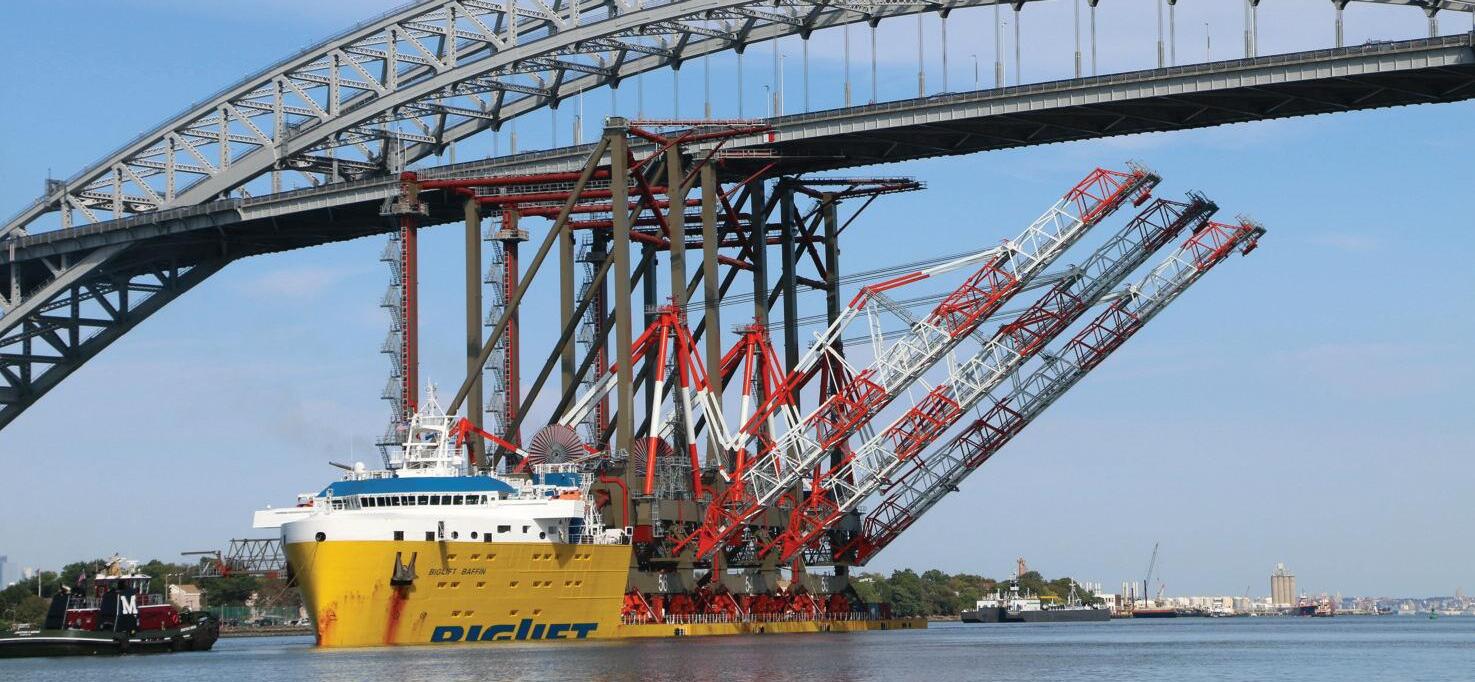
A similar situation arose for transpor tation of the above-mentioned cranes delivered to the Por t of Savannah They were unusually big - the largest of their kind on the East Coast, and (according to the US Coast Guard) the largest-gauge ever impor ted into the United States The first four of such cranes arrived at their new home - the Garden City Terminal, in a similar ‘knock-down’ version as the Liebherr cranes This enabled the yellow heavy load carrier BigLift Baffin to sail under the Talmadge Memorial Bridge, spanning the Savannah River between downtown Savannah and Hutchinson Island, without any problems.
The cranes are needed for a newly redeveloped section of the terminal’s quayside By straightening
out a bend in the terminal’s Ber th 1, the por t will be able to handle one extra 16,000 TEUs vessel at a time , bringing its number of “big” ber ths to four (plus room for three more smaller container ships). This adjustment, combined with the conversion of the nearby Ocean Terminal to an all-container operation, should add about 1 5 million TEUs of annual capacity. According to the Georgia Por ts Authority the work should be completed by July 2023
Somewhat closer to home, the Port of Mardas in Turkey ordered three double boom STS container cranes from Liebherr Container Cranes According to O’Donoghue, the cranes with a dual outreach of 63m and a span of 23 5m will be capable of handling vessels with 24 containers across the deck. The cranes include a number of innovative features such as a busbar for trolley power, a new electrical communications system and a machinery trolley for switchgear and slewing axis
Another more recent ‘first of its type’ contract that was awarded to Liebherr came from Eurogate Container Terminal Wilhelmshaven, Germany for two dual-trolley STS container cranes. The cabinless, automated cranes have a primary outreach of 73m, a lift height of 54 5m, a span of 30 48m and operational back-reach with secondar y trolley of 26m The cranes will be supplied with Liebherr Remote Operator Stations Designed for tandem operation, the primary trolley delivers containers automatically to a pinning platform. The containers rest on frames whilst the twist-locks are removed Once the pinning personnel leave the platform, they activate the secondar y trolley, which automatically delivers the container to the landside automated guided vehicles (AGVs)
Container Terminal Wilhelmshaven is Germany’s only deep-water por t allowing ultra large container vessel access at all tides and its strategic location makes it a key component of Germany’s transpor t infrastructure
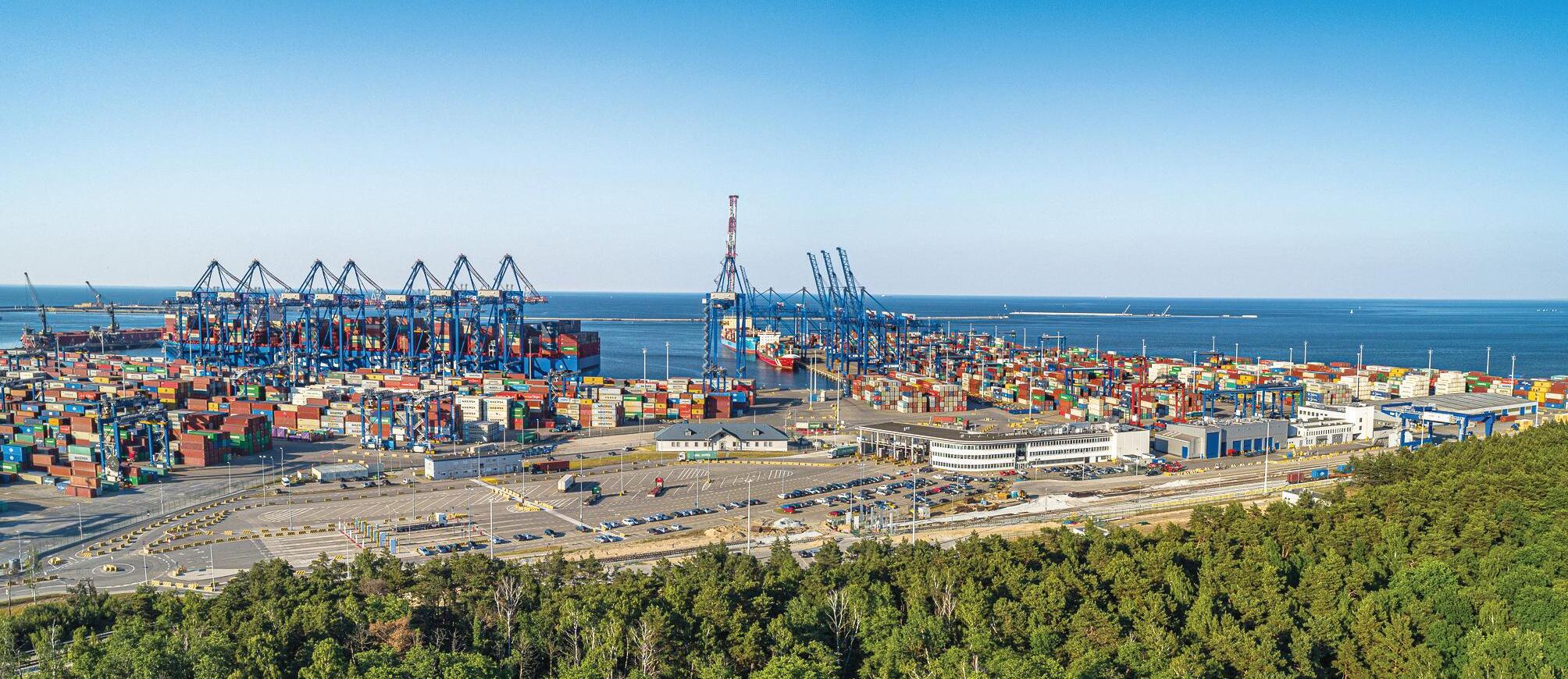
World Port Development January/February 2023 24 c o n t a i n e r c r a n e d e s i g n
Kuenz received an order for 20 automated side-loaded stacking cranes for Baltic’s Hub new T3 Terminal in Gdansk, Poland
Liebherr delivered the container cranes for Maher Terminals with only 40cm to spare when sailing under the Bayonne Bridge
Significant growth in throughput is expected at Wilhelmshaven and Eurogate is expanding and modernising the container terminal into an automated terminal geared for the future
Towards the end of 2022, Liebherr Container Cranes also launched a new patented jacking system - Liebherr Transform - in order to increase the lift height and boom extension of existing container cranes

Liebherr has been carr ying out lift height extensions for many years, but in 2022 the new patented jacking system was deployed at Patrick Terminals - the Brisbane Autostrad terminal located on the eastern coast of Australia for its first use Liebherr has two STS container cranes at the terminal, one new STS crane is currently being commissioned and another STS crane was supplied back in 2015 This 2015 crane has a supplied lift height of 37.5m, but with larger vessels calling at the por t, a lift height extension was required
Preparation takes a couple of weeks and the flexible system allows the crane to be jacked in position or moved back from the rails for jacking if required One of the key features of the system is that it uses the crane ’ s end carriage as a solid base for jacking the crane structure , eliminating the requirement for additional equipment. Fur thermore , since the system uses the crane structure as a basis for jacking, the loadings are low and are carried through the existing crane
The actual crane raise and the insertion of the extensions can be completed in a number of hours and so is suited to terminals prone to high winds The operation is exceptionally quick and the whole process can be completed from as little as four weeks Following completion of the project, the jacks were containerised and shipped onwards for their next deployment in New York, USA
At GCT New York, Liebherr is working on four Liebherr STS container cranes that were supplied in 2004. They have a lift height of 36 57m and an outreach of 50m The Liebherr Transform project will extend the lift height of the cranes by 8 6m and the outreach of the cranes by 5m (for an extra two bays). Once completed, the cranes will have the ability to work the largest vessels currently calling at the por t of NY/NJ allowing GCT to better ser vice their customers
In the context of new services and technology, there were also some interesting announcements coming from other crane manufacturers, including Paceco and Kuenz

For the last couple of years, Paceco has been working on zero emissions for their container handling equipment and the latest news is that they launched a Hydrogen Fuel Cell Power Pack Ready together with Mitsui E&S Machinery Co Ltd for their Transtainer cranes (Rubber Tyred Gantr y Crane)
Mitsui E&S Machiner y Co Ltd (MES-M) announced the successful completion and power generation verification of a hydrogen fuel cell power pack (FCPP), developed as a critical power system for the Paceco Rubber Tyred Gantr y crane (RTG) The RTG with the FCPP will undergo fur ther testing and optimisation at the MES-M Oita Works. If the tests are successful expect that the fuel cell and large high-pressure hydrogen fuel tanks will be used on other container handling equipment in the foreseeable future - another first for the industr y

On a different note , Austrian-based Kuenz, perhaps better known for their innovative (intermodal) cranes has announced at the beginning of the year, that in September 2022 it was awarded a contract for 20 automated side-loaded stacking cranes for Baltic Hub’s new T3 terminal currently under construction Baltic Hub, located in Gdansk, Poland is one of the fastest-growing terminals on the Baltic Sea and a strategically impor tant por t for leading international por t group PSA.

The cranes are fully automatic stacking cranes with a span of 32m and 2 cantilevers with a length of 8 5m each offering container handling of 1 over 6 The electrical equipment, including automation, is supplied by ABB The crane structure consists of a double girder gantr y with Kuenz’s patented trolley The trolley is equipped with a 4-drum hoist with direct outgoing ropes to the head-block. The head-block is equipped with micro-motion, which allows fine positioning in trolley and crane travel direction. A possible skew is also corrected by this system. The proven ABB technolog y consists of 3D laser systems with cameras that allow loading and unloading automatically in the truck area and the container stack
Once these new cranes are installed they will be the first container handling equipment for a side-loaded container terminal in Europe , moving not only the long-standing relationship between ABB and Kuenz to new heights but for the container por t and terminal industr y as a whole
January/February 2023 World Port Development 25 c o n t a i n e r c r a n e d e s i g n
Liebherr Container Cranes Ltd received an order from Eurogate for two dual-trolley STS container crane The company also launched a new patented jacking system
John Lund, Sales and Marketing Director (Global) Visy Oy takes a comprehensive look at how advancements in Optical Character Recognition (OCR) and Gate Operating Systems (GOS) are changing quayside operations.
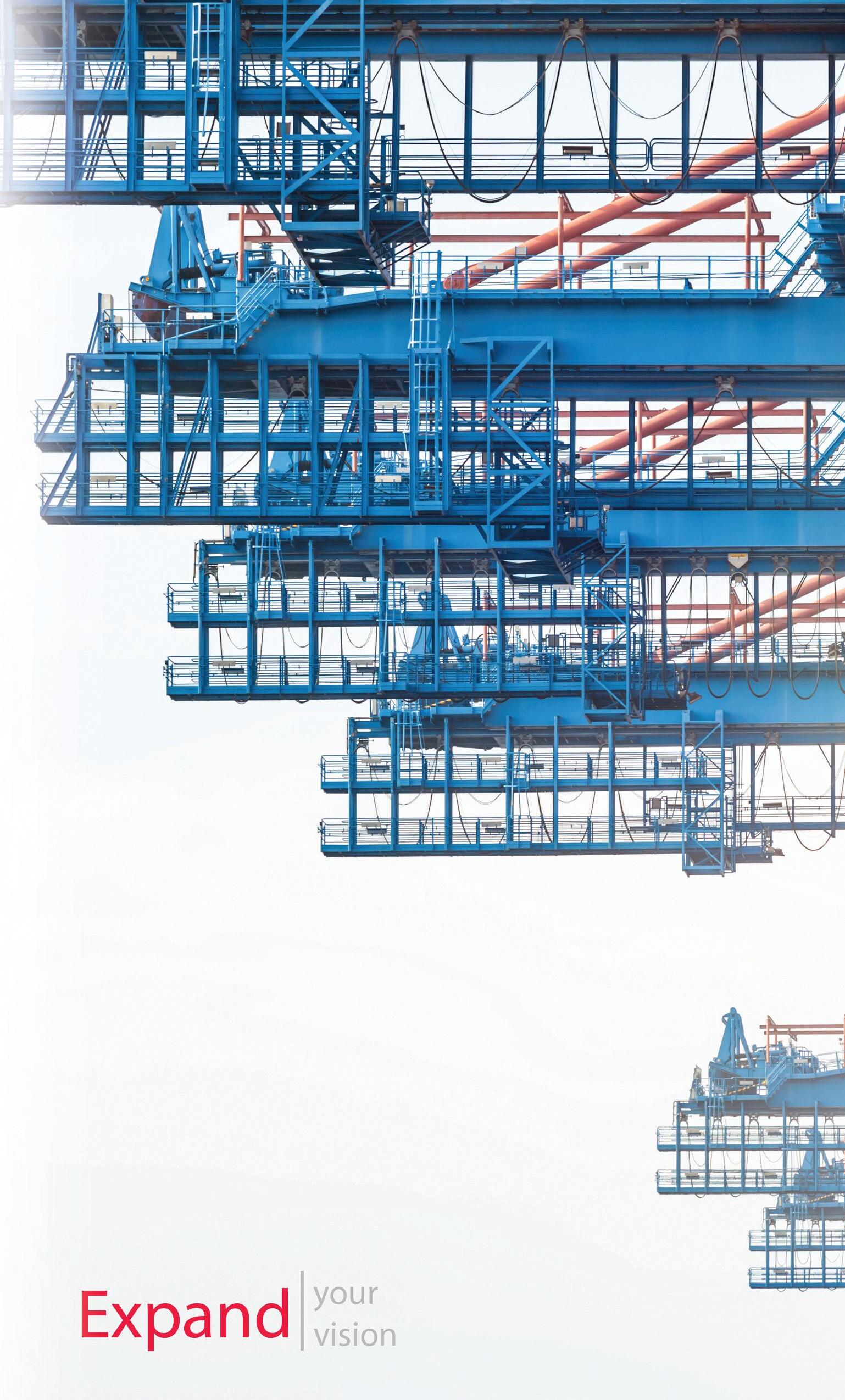
For the modern GOS, it makes little difference if we are talking about quayside, truck gate, rail, or even yard processes
The access and area management requirements for each of those operational areas are fundamentally the same:
1) Identify assets (trucks, CHE, cargo, people , etc )
2) Digitise and share relevant data with 3rd par ty systems such as the TOS
3) Allow the assets to move against the reference of a correct workorder or create an exception handling event if there is a conflict
When we use the term “ process automation” in the context of a GOS, those three overarching aspects may have different implications depending which par t of the operation is in focus
Below we will explore the details of quayside process automation using a modern GOS, and what it means for the terminal’s IT and operations teams
The Visy Ecosystem
The Visy Access Gate (VAG) platform is uniquely positioned to manage all aspects of access and area control in a single ecosystem. As a platform, it allows for an unlimited number of interfaces to 3rd party systems such as a TOS, RFID systems or appointment system, and will interface with any existing equipment such as weigh-in-motion scales, CHE PLCs or radiation por tals
The VAG platform is flexible enough that it can operate in the background, and therefore let existing IT infrastructure take a lead role , or it can be the front-end platform and GUI that unites subsystems and shares all relevant operational data with the TOS With such a range of data collecting and sharing options in a single system (from a single vendor), VAG meets all conceivable requirements of IT and operations to produce scalable , predictable , profitable , and future-proof operations
The primar y goal of the VAG “quay-gate” module is to improve specific KPIs, namely:

1) Cost per lift
2) Cycle times / lifts per hour
3) Ber th productivity.
How to improve quayside KPIs
While each terminal may have site specific requirements to improve those KPIs (and there are more specificities if we look at loading vs discharging operations), the VAG function is to automatically identify assets, reference the TOS, and confirm workorders or create an exception handling event. The quay-gate module is uniquely suited to improve these KPIs because of features found only in the VAG platform such as the Visy Deep Neural Network (DNN), TopView (spreader OCR), and automatic damage detection as described next
Visy LaneView & TopView for Process Automation
Identifying cargo and CHE is critical in quayside operations. In process automation, this function is performed with vision technology and OCR Visy uses a subset of Artificial Intelligence (AI) called “Deep Learning” for all vision technology, including OCR As a pioneer in OCR for logistics applications, the Visy DNN meets all operational data collection requirements with guaranteed results Additionally, the DNN collects and shares relevant event data faster and more accurately than a human, resulting in improved KPIs
World Port Development January/February 2023 26 c o n t a i n e r
The Visy DNN functionality includes:
- Container codes
- Verification of check digit

- ISO codes
- IMO labels
- IMDG/ADR labels
- Dangerous goods labels presence/classification
- Seal presence and type (bolt, zip)
- Door orientation
- Container weight (max, tare , payload)
- Container volume
- Automatic damage detection (structure , dents, bulges, extreme rust, large holes)
- Open doors
- OOG
- Flats
- Hatches
- Bundles
- Terminal Tractor ID
- Twistlock detection
- Lifting type
To achieve reliable process automation for such an extensive list of attributes, 3 - 5 side imaging is required The Visy Crane OCR system includes LaneView, a series of pan-tilt-zoom
(PTZ) cameras mounted on the sill beams and portal beams, and TopView spreader OCR system PTZ cameras are utilised because the system interfaces with the crane ’ s PLC to track the spreader’s flight path in live operations, therefore the system always has “ eyes on the cargo ” and takes images at the right time. This smart-system approach allows the crane operator to work how they believe is the best, and the system conforms to their style. The other advantage of smart PTZ cameras is that if a camera breaks or malfunctions, another camera can take over and therefore avoid disruptions in the operation

January/February 2023 World Port Development 27 c o n t a i n e r o c r
Multiple camera views coupled with a smar t-camera system offers multiple levels of redundancy in the OCR process, and therefore maximises uptime Visy TopView (spreader OCR) also interfaces with the crane ’ s PLC and extends the notion of “smart devices ” As the spreader is the common denominator in container movements, giving it “ eyes ” has clear benefits:
- Automatically links box ID to a specific spreader on each move
- Boosts OCR read rates with 5th side image(s)
- Automatic twin-20 detection
- Early aler t if wrong box is being moved
- Roof picture for damage inspection/claim management
- The roof pictures may also be used for automatic damage detection
- Spreader OCR is the only way to bring mobile harbor cranes into the quayside automation system
- TopView is applicable on all CHE (RTGs, RMGs, reach stackers, etc ), in any par t of the operation, without additional cabling

Fur thermore , since the cameras are on the spreader, the type of operation or the flight path are immaterial Hooking boxes on the vessel, between the legs, on a platform, in the back reach area, or during shuffling, makes no difference to TopView. The system takes images of the boxes at the right time , digitises the relevant data, and shares the data with 3rd par ty systems as required for site-specific process automation
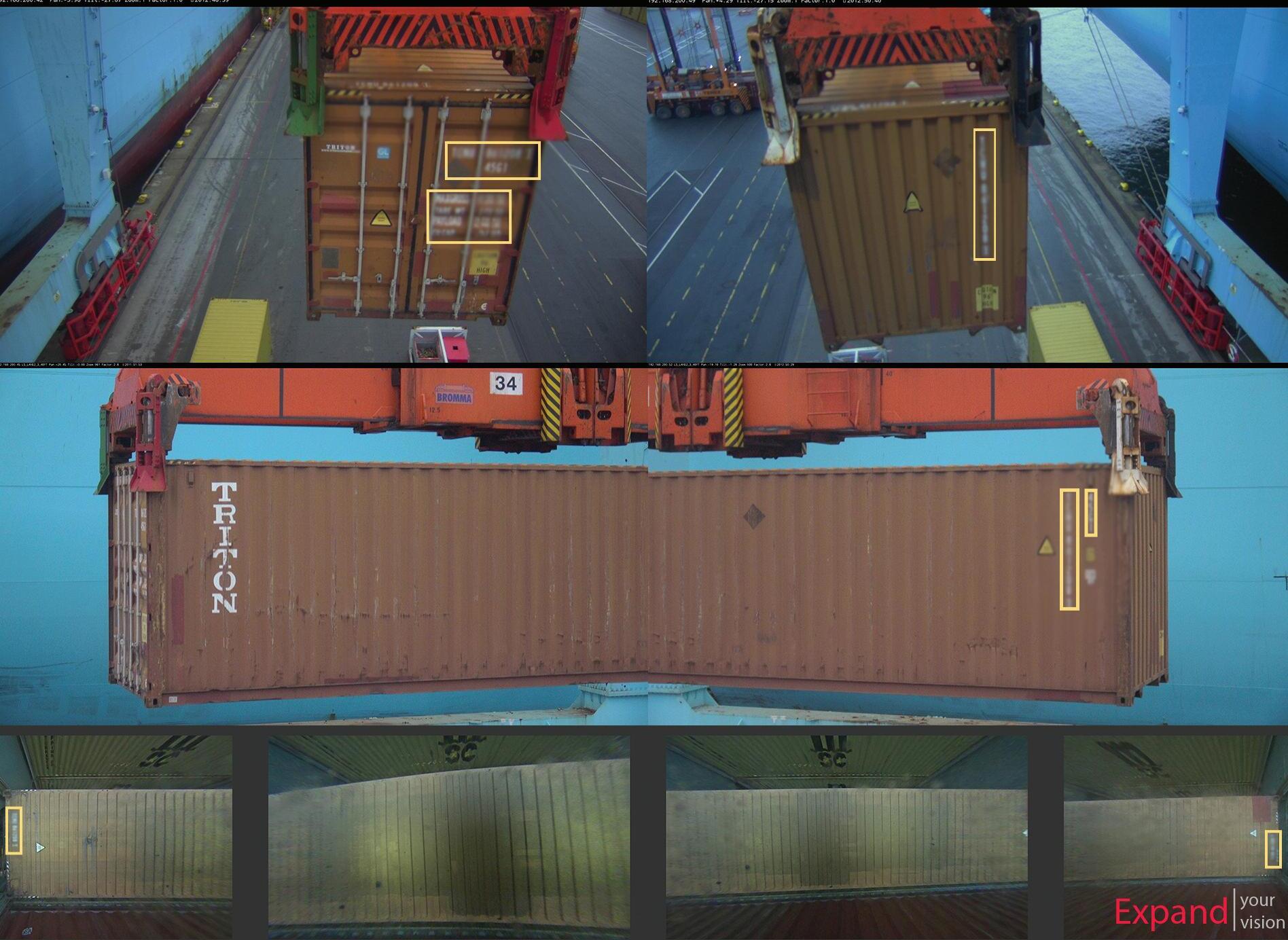
Linking the workorder to the horizontal transportation is an important part of quayside process automation VAG operates with OCR or RFID to identify terminal tractors (TTs) on the quay and automatically make the association with the cargo ID When OCR is used, TTs have numbers painted on the roof of the driver cabin. Cameras placed on the STS cabin point down and automatically identify the roof-top TT number This asset ID is verified for the workorder, and the TOS receives an update. When RFID is integrated into the system, long range readers are placed on the crane frame and each TT is equipped with an RFID tag
When the tag is excited, the system knows that the TT associated with that tag is executing a workorder VAG receives the RFID information, associates it with the box ID and updates the TOS Clerks and operators automatically receive workorder information and don’t need to manually input data thus saving time and possible errors on every transaction
Digitising Damaged Cargo
The Visy Automatic Damage Detection System (ADDS) is the latest feature that can be utilised in any par t of the VAG ecosystem With ADDS, the Visy DNN assess the condition of containers, digitises the assessment, and creates aler ts for containers that are in an unsafe or unacceptable condition Imagine that during a discharge operation, a box is coming off the ship and it has severe structural damage Visy ADDS “ sees ” the damage, digitises the information, and creates an exception handling event for that box so that it doesn’t go into the stacks Similarly, if boxes are coming off the ship and have bulges, dents, extreme rust or holes, the system logs the
World Port Development January/February 2023 28 c o n t a i n e r o c r Visy LaneView and TopView
damage before the box touches the quay and therefore exonerates the terminal of liability
The proactive nature of ADDS allows operators to take control of incoming damaged cargo and share that information with their customers before the problem escalates. ADDS is a software add-on that does not require any additional system hardware It provides operators with the ability to supply value added ser vices to their customers with minimal investment.



Limitations
While VAG for quayside operations is the most advanced system of its kind due to the single-platform ecosystem coupled with unique tools such as TopView, ADDS and the Visy DNN, this type of system is not without limitations The first limitation is regarding seal numbers Unfor tunately, there is no vision technolog y system available today that can read seal numbers while boxes are in flight to a level that is acceptable for process automation. If the seal is dir ty or turned in such a way that the numbers are not visible , it simply cannot be read with a camera system
The second limitation is that in twin, tandem or quad lifts, some sides of the boxes will be obscured by the other boxes in the lift For example, in a twin-20 lift, one of the doors will be blocked and therefore any data on the blocked doors will be impossible for the system (or any operator) to read. In this case the box ID will be read from TopView and other cameras, but seal presence cannot be confirmed during the lift. While these limitations are certainly an inconvenience in quayside automation, they are not enough to suppress the return on investment
Conclusion
The VAG platform identifies ever ything that goes in or out of a terminal by road, rail or quay, digitises that information, and shares it with 3rd par ty systems such as the TOS to provide process automation and thus improve KPIs. In quayside operations, the VAG platform provides unique features such as TopView (spreader OCR), LaneView PTZ smar t cameras that image ever y visible side during a lift, terminal tractor identification, and the Visy DNN which guarantees the best OCR read rates in the industr y and even incorporates ADDS. While there are limitations to any quayside vision technolog y system, the ability of the technolog y to collect and share data faster and more accurately than a human make it a prudent investment for any operator seeking to improve their processes and provide their customers with enhanced ser vice
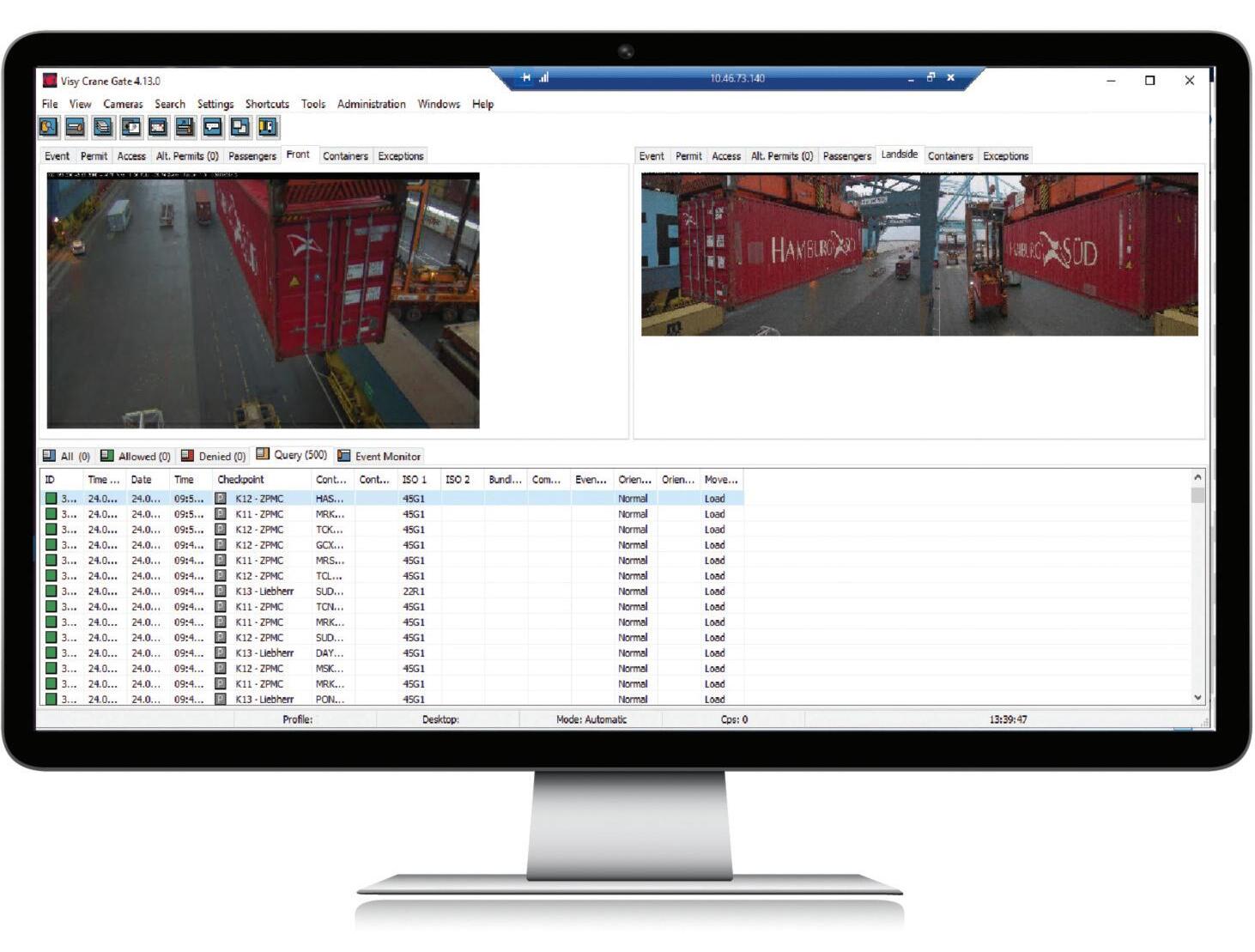
STS Crane OCR for Baltic Hub
Visy’s par tner Autepra has signed a contract to supply crane OCR and quayside automation to the Baltic Hub terminal (DCT Gdansk, member of PSA Group) Phase 1 of the project scope is design, deliver y, implementation, integration with Navis TOS and 5 years suppor t and maintenance of 14 STS cranes With the planned Baltic Hub (DCT Gdansk) expansion, the system has the potential to be extended to new quays in the future The system uses Visy’s LaneView crane OCR solution with fixed PTZ cameras. The quayside automation is an extension of the gate and rail OCR automation that Visy and Autepra have already delivered More on that project can be found at: https://youtu be/iOJAcO2A2Ow
About the Author
John Lund has more than 15 year s of exper ience helping mar ine and intermodal terminals ac hieve their operational objectives with tec hnology He has worked on a wide range of projects in Europe , Afr ica and the Amer icas involving OCR, RFID, DGPS , and other process automation tools His career motivation is rooted in knowing that the systems he provides improve safety, efficienc y, and profitability for his customer s John holds an MB A and a law degree

January/February 2023 World Port Development 29 c o n t a i n e r o c r
Visy crane gate system UI
Visy LaneView camera
In conversations with terminal operators about Straddle Carriers the word electrification pops up constantly along with reduction of their carbon frootprint.
Thomas Francis reports…
Early last year Finland-based Cargotec announced that its por t equipment brand Kalmar would exit the heavy crane business (including rubber-tyred gantr y cranes, rail-mounted gantr y cranes, automated stacking cranes and ship-to-shore cranes) in order to focus on mobile solutions instead
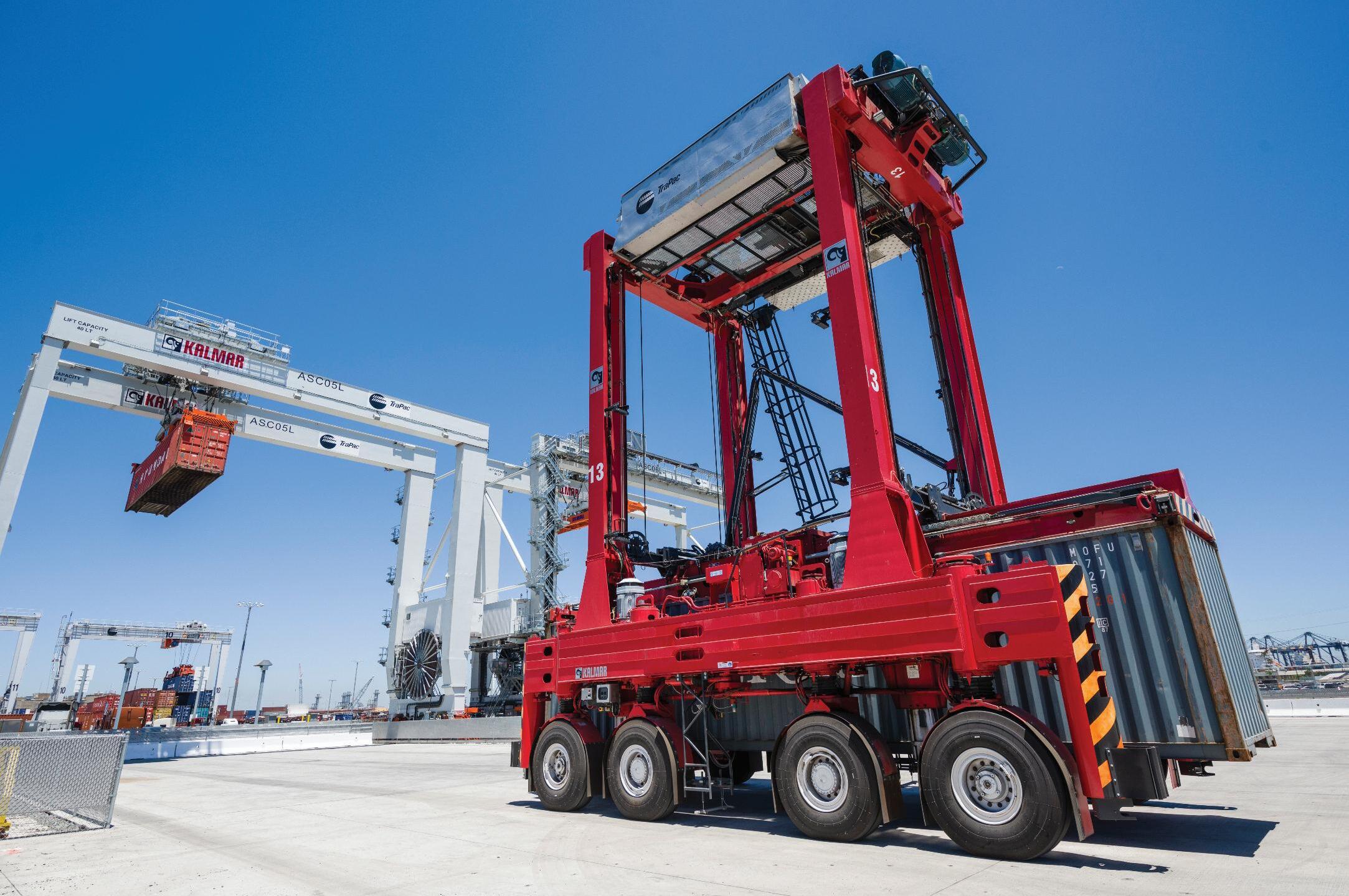
True to their word, Kalmar has been concentrating on the mobile solutions range when it comes down to straddle carriers, and has invested heavily in, for example, their AutoStrad (Automatic Straddle Carrier) automation system to ensure that the system is providing good productivity with high reliability Scalability has been addressed as well to be able to deploy AutoStrads in the biggest container terminals around the world The AutoStrad system has been expanded to be able to operate within all interfaces of a container terminal, including interchange of containers under the quay crane portal area, automatically interchanging containers with road trucks - without super vision and operating within rail interface and warehouse doors
In addition, the company has also been investing in safety improvements in manned straddle carriers, where stability alarm and monitoring functions have been fur ther developed. Also a collision warning system will be available for manned straddle carrier operations
But is not only automation and improvements under scutiny, electrification is another hot topic in container terminals, and customers are looking for fully electric products to be able to reduce their carbon footprint.
According to Kalmar the number of fully electric straddle carriers will rapidly increase in 2023, as well as the number of their hybrid straddle carriers - capable of reducing fuel consumption by up to 40% compared to equivalent diesel-powered machines. Kalmar has sold more than 500 hybrid straddle carriers by now and around 60% of total sales in 2022 came from the sale of hybrid straddle carrier.
Similar repor ts come from Konecranes about their Noell Hybrid Straddle Carrier, albeit without the mention of sales figures. Although the company reports some interesting orders, more recently they have seen that those opting for the low-emission hybrid straddle carrier might need to increase their effor ts in the near future in decarbonising their container handling operations even fur ther in order to meet their company ’ s own set targets on operations As a consequence , Konecranes expect that these customers will implement electric drive technology on straddle carriers as soon as they are convinced that it is sufficiently mature With their tried-and-tested design and components on the batter y straddle carrier and well-adaptable charging concept, Konecranes feel prepared to serve the needs of the operators already
A similar commitment comes from Kalmar as they use the same batter y technology in their

hybrid straddle carriers, as on their electrically powered zero-emission straddle carrier, with FastCharge charging technolog y, which has been in their por tfolio for several years This technolog y has been piloted in a terminal environment and it is available globally
Mid-last year, Konecranes also launched their new full batter y Noell straddle carrier with the first units now (Januar y 2023) going into live terminal operations in the coming weeks According to Konecranes, last year saw a surprisingly robust market demand, eventually exceeding previous expectations Despite the still existing disruptions in global supply chain, the company has delivered orders on time , allowing customers to benefit from new container handling capacity as planned
One such contract came from long-standing customer Eurogate in Hamburg, Germany Since 1970, a total of 530 Konecranes Noell straddle carriers have been delivered to the Eurogate Group, which has grown steadily over the years, and with terminals around Europe has become indispensable to European container traffic
Last year, Konecranes delivered numerous Noell hybrid type NSC 644 EHY straddle carriers to Eurogate’s German container terminals alone . This type of straddle carrier can stack 1-over-3 with a Noell twin-lift spreader NTS 62 F and carries on the tradition of the diesel-electric straddle carrier with a downsized power train/genset. The hybrid Noell straddle carrier NSC 644 EHY uses a batter y pack instead of brake resistors, giving
World Port Development January/February 2023 30 c o n t a i n e r s t r a d d l e c a r r i e r
Hybrid is the buz z word… for now
Hybrid is the buz z word… for now
uncompromised performance in comparison with diesel-driven machines


According to Eurogate , the decision to go with the hybrid Noell NSC 644 EHY machine was easy as it offers a reduction of emissions by up to 30% or approximately 80 tonnes of carbondioxide per year compared to the emissions of the existing straddle carrier fleet
Konecranes repor ts a good order backlog into 2023 and has received some interesting recurring contracts, including 5 hybrid Konecranes Noell straddle carriers for Flinders Adelaide Container Terminal in Adelaide, Australia and 8 hybrid straddle carriers for CSP Zeebrugge, Belgium In 2022, Port of Cork Company (POCC) in Ireland, placed an order for 2 hybrid Konecranes Noell straddle carriers, with another order for 2 fur ther machines in Januar y 2023
In Februar y 2023, Kalmar secured a significant order from their long-term customer DP World for nine hybrid straddle carriers for their operations at the Antwerp Gateway terminal in Belgium The terminal is a joint venture between DP World Antwerp Holding, Cosco, Terminal Link and Duispor t group The new machines will have a lifting capacity of 60 tonnes, which is a new offering from Kalmar designed to improve productivity by enabling twin-lifting of heavier container combinations. When they are being delivered in the last quar ter of this year the new straddle carriers will replace older machines from the existing fleet at Antwerp
Electrification is high on Kalmar’s agenda, but it admits that there is also a growing interest in hydrogen powered solutions, but - according to the company - the time for this is not yet there for full fleet size implementations due to availability and cost of green hydrogen.
Similar reports come from Konecranes for those that are testing or using low/zero emission solutions with some of their customers changing to 100% HVO use instead of fossil diesel, with the transition going easy and trouble-free
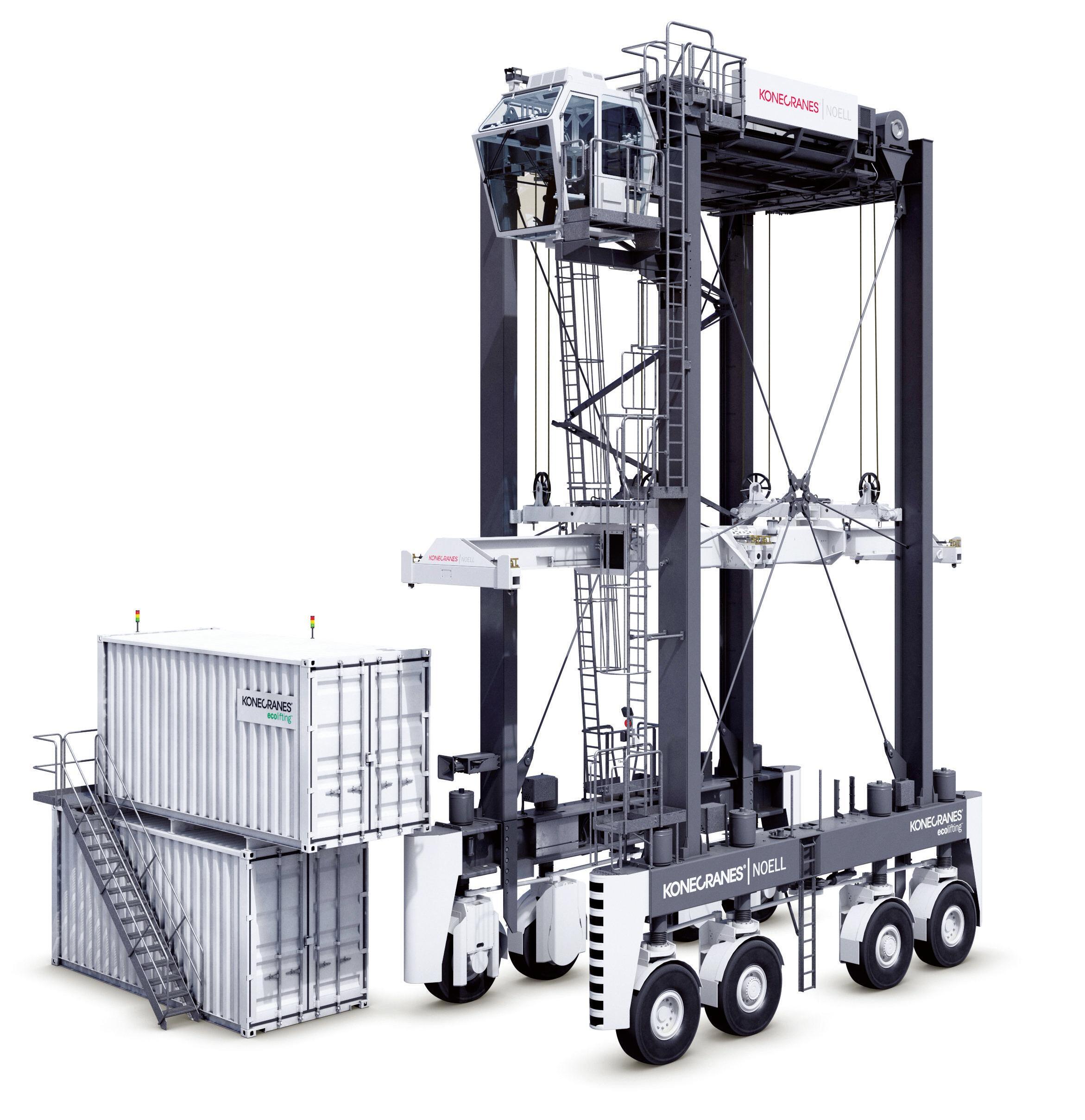
Another development that is evolving rapidly is the creation of a standardised data exchange interface for straddle carriers. To do this, manufacturers have been active in the TIC4 0 initiative and many of them can already deliver their straddle carriers TIC4.0-ready.
Currently, the world might be an unfamiliar place but the ‘show’ must go on, hence manufacturers have not seen a noticeable uncer tainty or even hesitation from their (future) customers with regards to new investments in straddle and sprinter carriers.
January/February 2023 World Port Development 31 c o n t a i n e r s t r a d d l e c a r r i e r
C R : m u c h m o r e t h a n d a t a a l o n e
Certus Automation gives WPD an update on the OCR industry, its future and what it is doing to remain one of the leaders in the field.
Optical character recognition (OCR) technologies are constantly evolving with new innovations. Today, OCR systems are no longer just innovative solutions, but rather essential pieces of technolog y for any container terminal that wants to be highly productive .
That’s the view of OCR provider CERTUS Automation which believes that in the near future , most container terminals will identify street trucks, terminal tractors, containers and wagons by means of sensor technolog y. Moreover, by 2050, the company is sure that ever y cargo transaction will be identified in a digital fashion With this in mind, its future developments will not just focus on the container or the crane moving the box, but the whole journey of the container from the gate through the terminal.
“In the shor t term we see ever y greenfield adopting OCR technolog y and AutoGate solutions, and for most new STS Cranes, OCR technolog y is becoming a default,” states a company representative

“To suppor t this movement, CERTUS is able to deliver its solutions on a global scale , provide 24/7 suppor t globally and has exper ts available to advise on the process automation.”

OCR is so much more than data alone - it enables process automation within the terminal operations It is impor tant terminal operators consider the goals they want to achieve and select a supplier that can advise , deliver and suppor t the full solution.
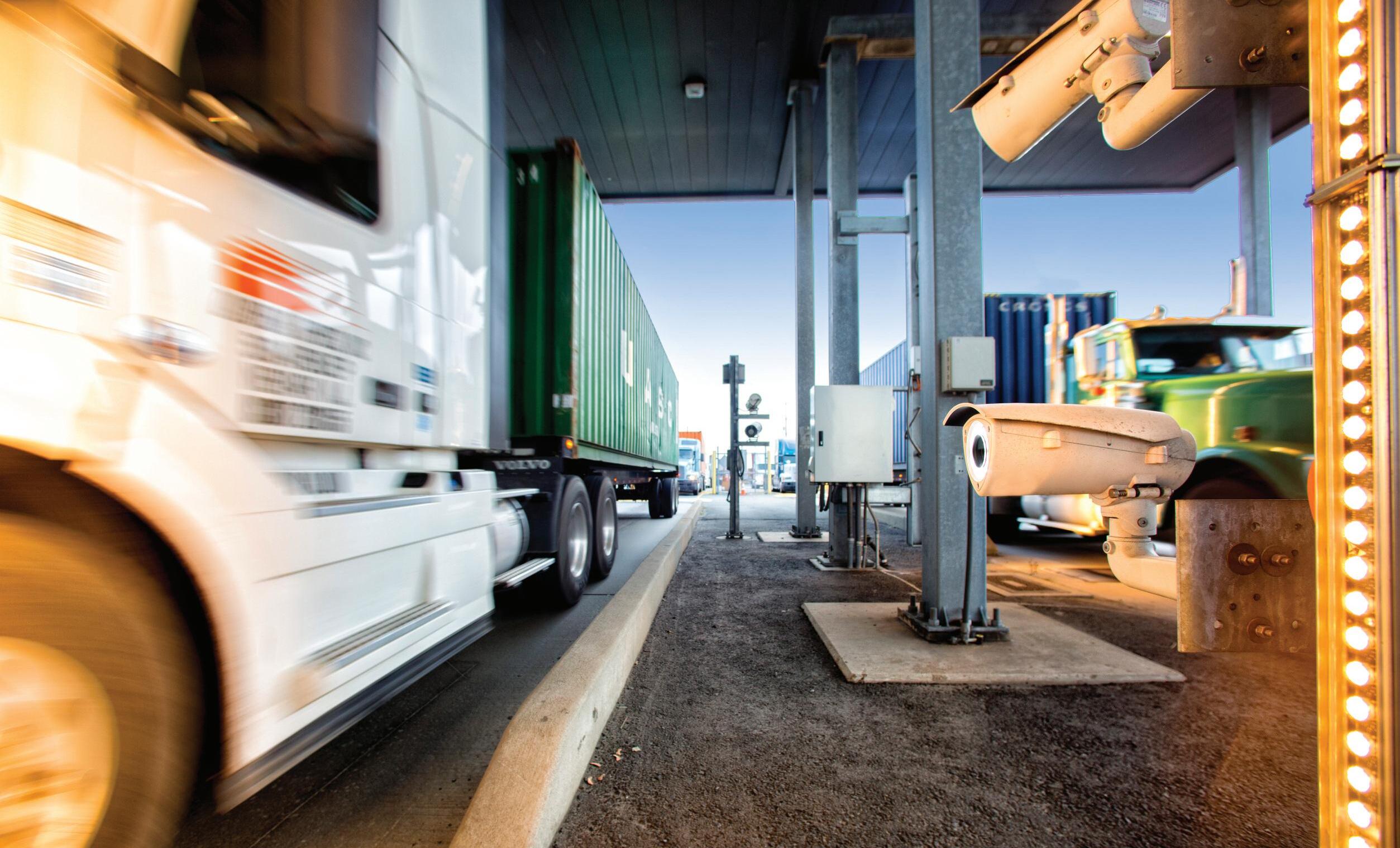
“Our advice is to choose an OCR supplier that can deliver Process Automation. OCR alone is nice , but what you do with the OCR data and how you streamline your operations with OCR is what counts. That’s why CERTUS delivers a complete AutoGate solution ”
When asked fur ther advice on what to do and not to do, CERTUS stated: “Never split the hardware and software responsibility and prevent finger pointing if the end result is not to your satisfaction. Overall, terminal operators should select a provider that takes responsibility over the complete solution OCR will become a crucial par t of the terminal’s daily operations so choose a supplier that offers 24/7 maintenance and suppor t ser vices ”
Innovation and design
In order to maintain its position as one of the leading providers in the field of OCR, image processing and software development, CERTUS is continuously striving to enhance its offerings with innovative design Some of the company ’ s recent additions include the newly developed Vehicle Booking System (VBS) and Damage Detection
The former allows container terminals to schedule in- and outbound visit flows to balance peaks, improve capacity utilisation and reduce vehicle turnaround times VBS easily connects different supply chain partners which reduces the administrative work for all parties, thus saving costs The pre-announcement of visits will optimise the (Auto)Gate throughput, prevent operational interruptions and makes your yard more secure through registration and validation of booking details of visits
As for Damage Detection, in addition to the 5-side damage images the OCR systems captures and stores in the Gate Operating System, the exception handling desk can receive a signal when a container with damage is detected by the system. The system verifies the integrity and ‘stackability’ of the container and an alarm is generated for manual review when necessar y
O
c o n t a i n e r o c r u p d a t e World Port Development January/February 2023 32 O
C R : m u c h m o r e t h a n d a t a a l o n e
Photos courtesy of Certus Automation
Triggers can be created on severity percentage or damage class This feature is available for both STS crane OCR and the gate OCR por tals. Moreover, the organisation recently added Stacker OCR to its offering In addition to the OCR systems for STS cranes, yard cranes, gate and rail, CERTUS has now developed an OCR system that can be deployed on empty handlers The system uses a dual camera setup and suppor ts up to eight tiers. Data is transmitted directly to the Terminal Operating System and/or the Position Detection System
Recent installations and contracts
When asked for an update on how business has been in recent months CERTUS gave World Por t Development a round-up of its latest contracts and projects:
- Lekki Freeport Terminal
An agreement was signed with Lekki Freeport Terminal (LFT) to deliver an automated gate solution combined with fleet telematics and position detection to suppor t the gate and yard processes for LFT in Lekki Por t, Nigeria
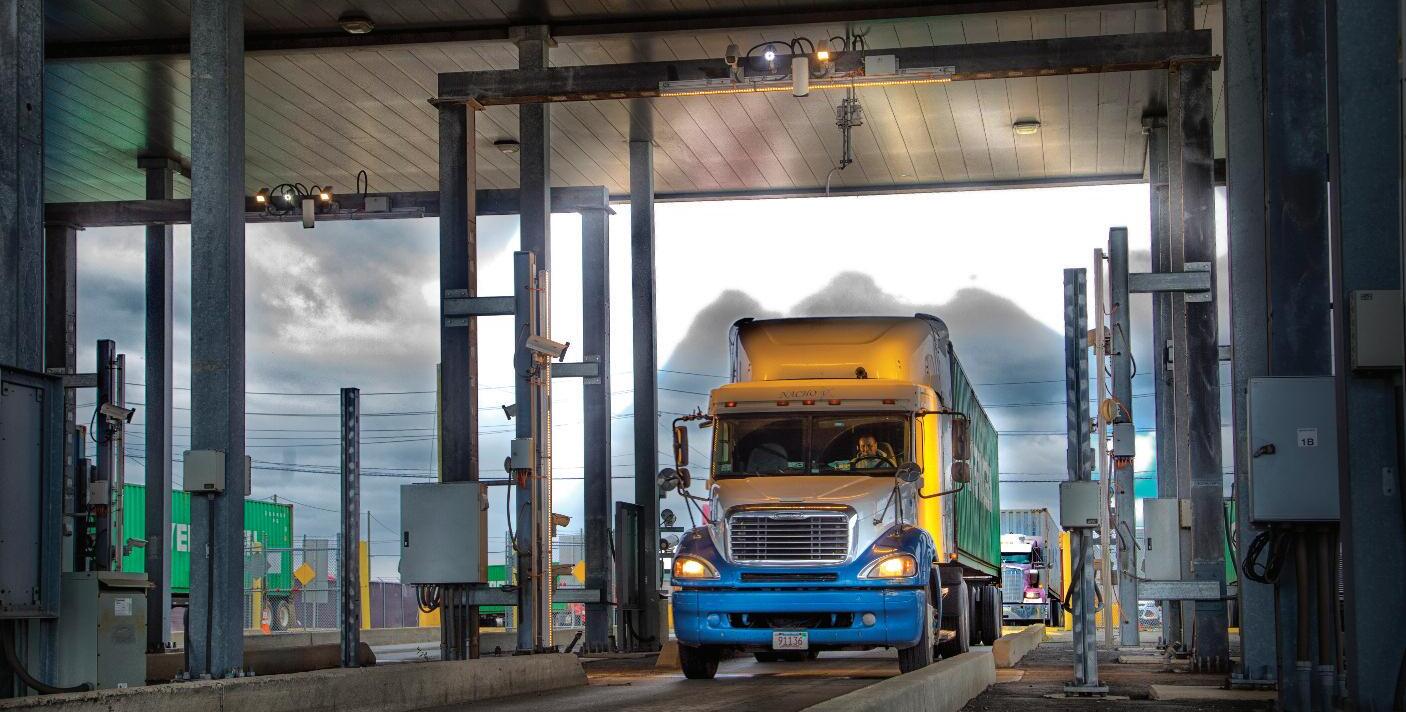
The solution deliver y includes an automated gate which consists of 5 gate OCR por tals, weigh in motion scales, 15 gate lanes equipped with kiosks, RFID readers and traffic control equipment, the GOS software suite together with a Vehicle Booking System (VBS), combined with truck RFID equipment and fleet telematics devices for 35 terminal tractors, 15 RTGs and 9 reachstackers/empty handlers
- Evergreen Marine Corporation


For Evergreen Marine Corporation (Taiwan) Ltd (EMC) CERTUS will deliver its automation solutions to both the gate and the STS and ARMG cranes of the Kaohsiung Por t Seventh Container Terminal (KC7) in Kaohsiung City, Taiwan As par t of the terminals road to full automation, CERTUS will deploy Optical Character Recognition (OCR) systems to both their yard and ship-to-shore (STS) cranes in combination with an automated gate solution that includes gate OCR systems, truck-driver kiosks, license plate recognition (LPR) cameras and traffic control equipment
All solutions will be integrated via the provider’s middleware software called PASS (Por t Automation & Security System)
- Euromax Terminal Rotterdam
Hutchison Por ts ECT Euromax is one of the most advanced container terminals in the world. The facility has been especially designed for the fast, safe and efficient handling of the biggest container ships
Automation plays an impor tant role in the terminal operations Fifteen years after deploying the current automated gate, CERTUS Automation has signed an agreement for the replacement of all OCR lanes, LPR cameras and over 75 gate pedestals. Apar t from the hardware upgrade , all suppor ting software will also be upgraded
- APM Terminals Salalah
Strategically located on the major East-West shipping lane , the Por t of Salalah is a major Arab Gulf regional gateway por t and trans-shipment hub on the Arabian Sea APM Terminals signed a 30-year concession agreement with the government of Oman to build and manage this world-class container facility until 2028 Since then, the por t has made significant strides towards achieving world-class operational standards. CERTUS has signed an agreement with APM Terminals Salalah for the deployment of crane OCR on 17 existing STS cranes and 10 new STS cranes With these OCR systems installed, the terminal will benefit from increased productivity of crane operations.
- Georgia Port Authority
The Georgia Ports Authority (GPA) continues to move forward with a plan to enhance its terminal operations As par t of this plan to
expand its container-handling capabilities, GPA has signed several agreements with CERTUS concerning gate automation. In 2023 the company will be deploying another 8 gate OCR por tals and 11 gate IN lanes with kiosk at Westgate , 6 gate OCR por tals and 8 gate IN lanes with kiosk at Gate 9, and 4 gate IN lanes with kiosk at the Steamship terminal
- Maher Container Terminal LLC
With over 10,000 crane moves per day, Maher Container Terminal LLC is one of the busiest terminals in Nor th America. After the deployment of an automated gate and crane OCR on 17 STS cranes, CERTUS has now been awarded the deliver y of OCR for 37 empty handlers as well as OCR for the rail operations, which includes a double stack OCR portal with remote inspection software
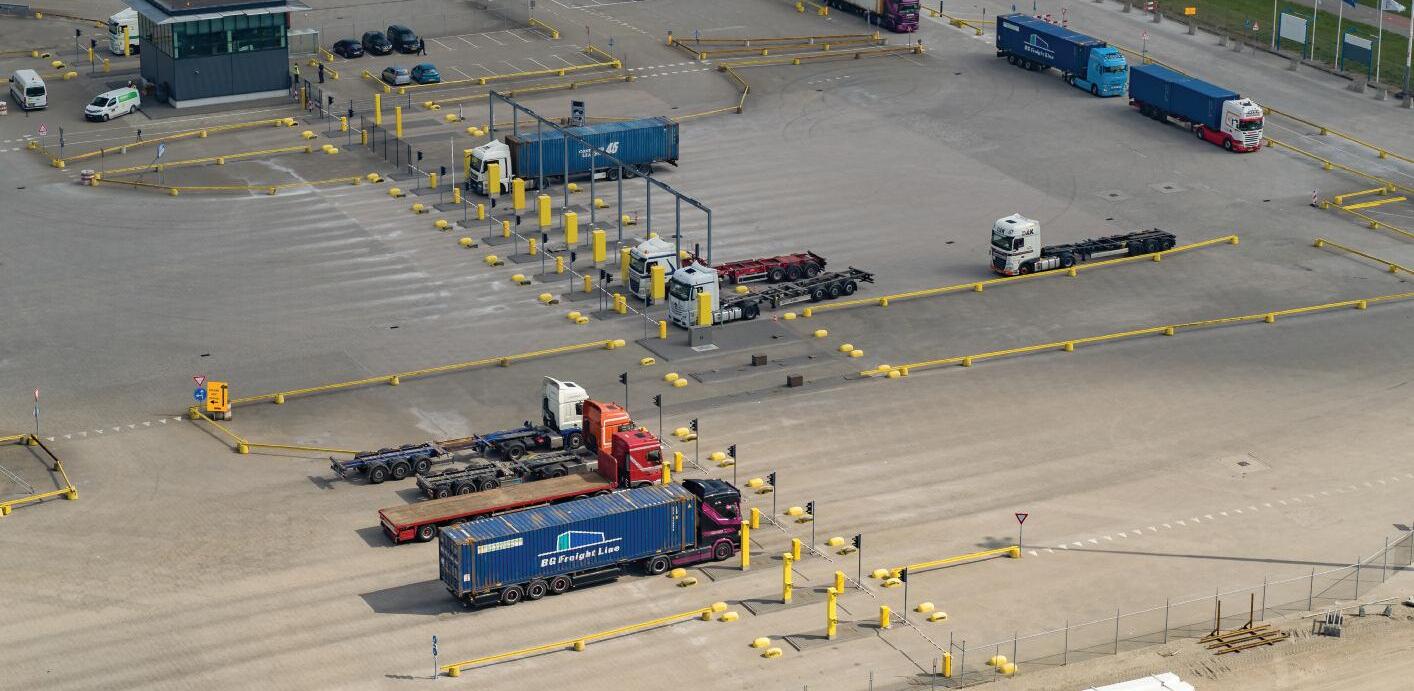
- Eimskip
CERTUS has signed an agreement with Eimskip Iceland EHF to deliver its automation solutions to both the gate and the STS crane at Eimskip’s Sundahofn Por t in Reykjavik
Eimskip is a leading transpor tation company in the Nor th Atlantic providing container and reefer liner ser vices with connections to international markets and is specialised in worldwide freight forwarding ser vices with focus on frozen and chilled commodities
c o n t a i n e r o c r u p d a t e January/February 2023 World Port Development 33
Bedeschi has been a global player in the bulk material industr y for many years and can offer any type of tailor-made solution to transpor t and store any type of material such as coal, iron ore , limestone , fer tiliser, clinker and many others, covering any capacity from 100 up to 10 000 tph The company has proven experience with all kinds of raw materials and provides the design, engineering and manufacturing of integrated solutions covering ever y company ’ s needs.
Thanks to its wide team of engineers, Bedeschi can study, develop and constantly offer different solutions and innovations from the technical and design point of view, always keeping an eye on the latest environmental requirements.
Outlook for the industr y for 2023
According to Bedeschi, following the trends of 2022, the cement industr y is showing promising improvements worldwide Reducing emissions across the cement industr y will
play a pivotal role in addressing climate change and for this reason, by 2050, a global goal to lower CO2 emissions has been set, limiting the global temperature increase to 1 5°C above pre-industrial levels. Bedeschi is committed to helping reach this goal; its R&D department is constantly working to improve the capability of their systems, focusing on environmental protection, energ y efficiency, investments in eco-friendly and innovative equipment and pollution prevention.
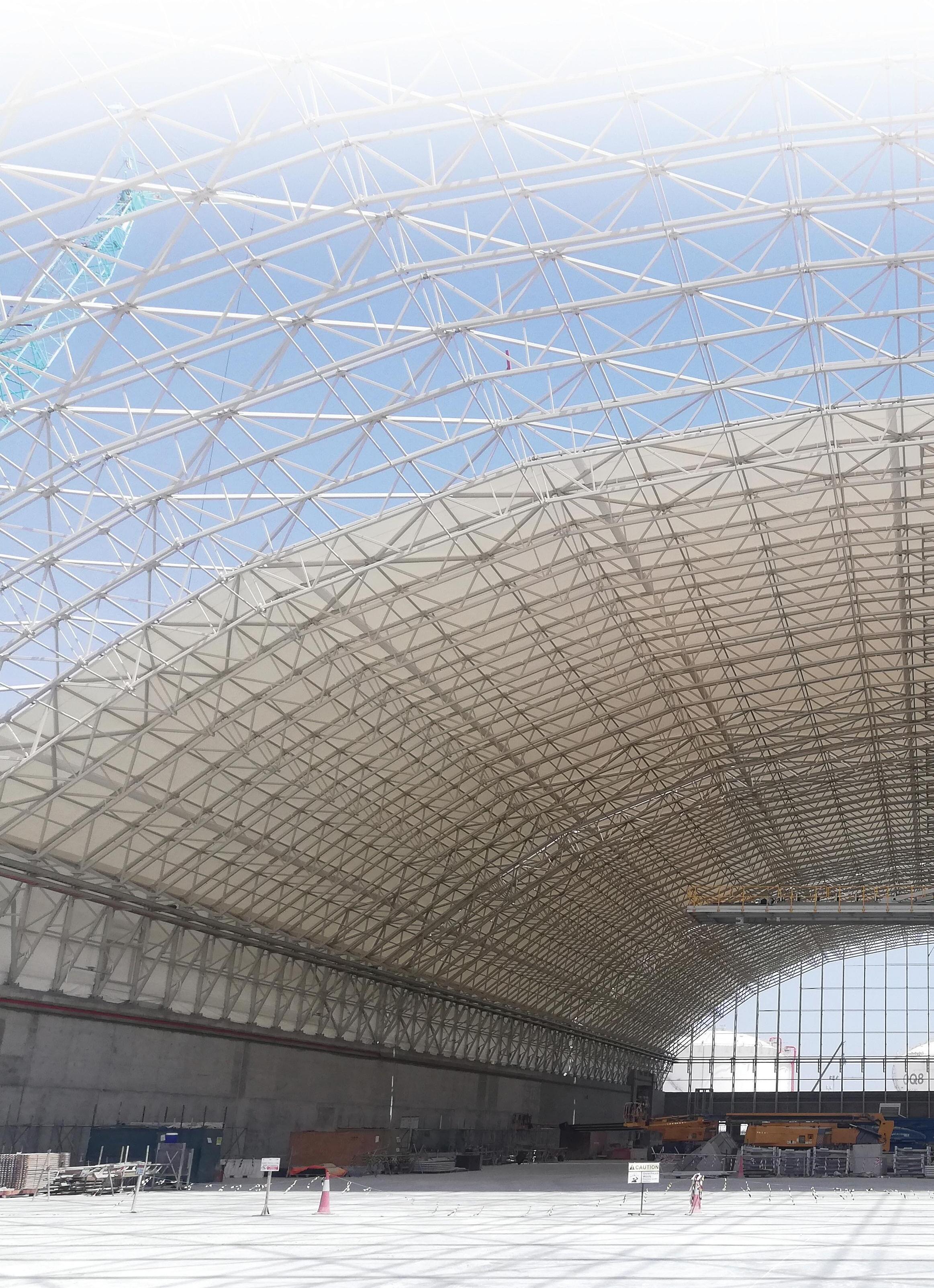
b u l k s t a c k e r r e c l a i m e r B e d e s c h i o u t l i n e s f u t u r e t r e n d s a n d c h a l l e n g e s f o r t h e s t a c k e r - r e c l a i m e r i n d u s t r y
World Port Development January/February 2023 34
Bedeschi new storage under construction
For many years, Bedeschi has been involved in safeguarding the environment and is committed to manufacturing machines to the highest environmental standard in order to deliver the most efficient equipment possible to its clients
In terms of other industries beyond cement, Bedeschi is cer tain that the aftermath of the situation in Ukraine will probably change the declining forecasts for coal power plants, at least in the shor t term, as the world copes with the exceptional price fluctuation relevant to energ y production. As for the food handling business, this has faced a slight increase despite the war : the forced change of main cereal and oilseed supply routes has favoured
the refurbishment and construction of new terminals in alternative areas Bedeschi acknowledges these are uncer tain times and looks to suppor t companies in order to i dentify the best path forward via innovation, eco-friendly equipment, and modern technology.
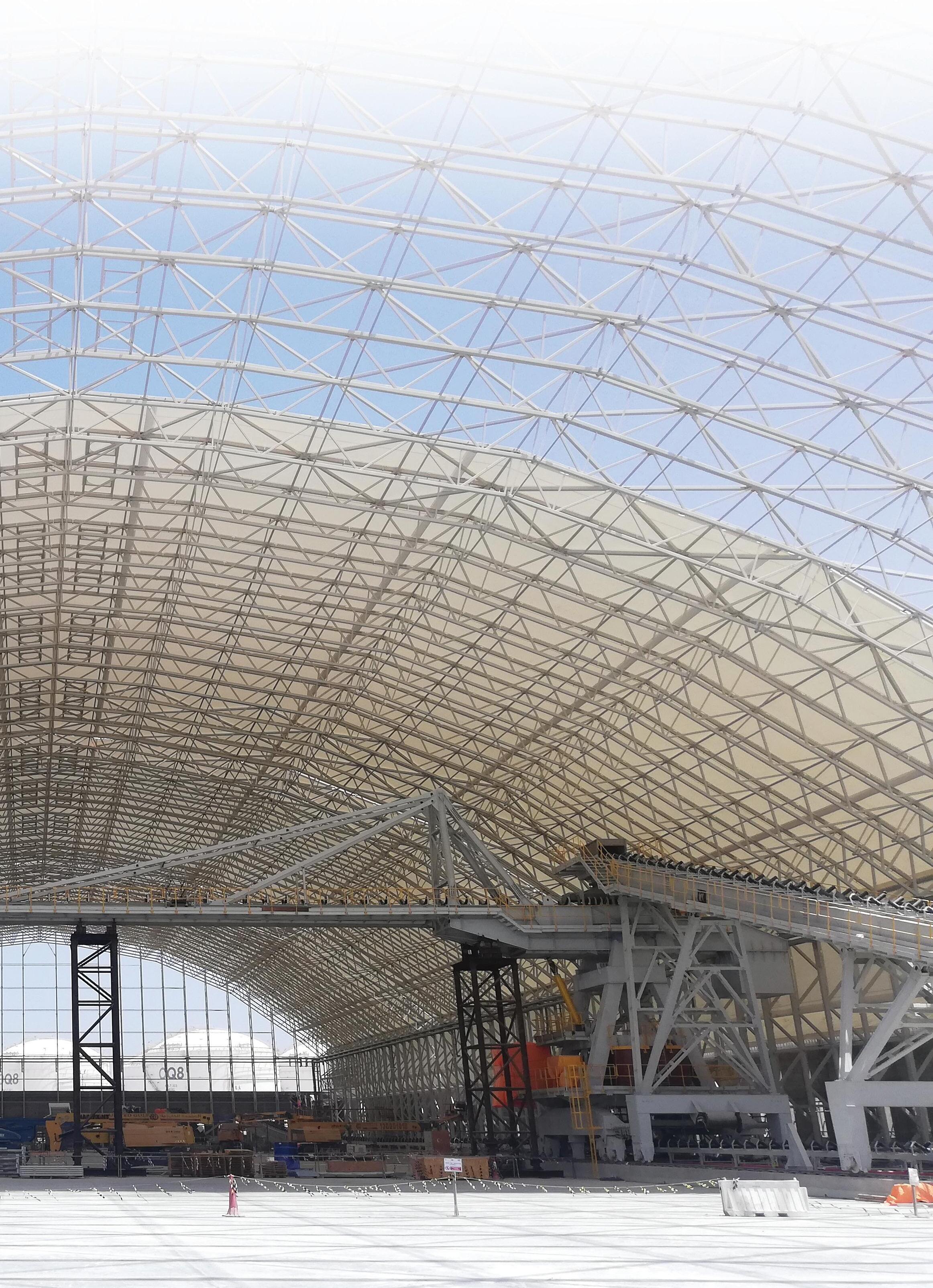
With regards to stacker and reclaimer manufacturing and development Bedeschi see diversification as the company ’ s major asset to ensure continuous innovation in products and ser vices to tailor fit customers’ needs Operating in different industries and with different materials they are able to think out of the box, using technically consolidated concepts for a totally customised solution.
As metioned, in the R&D Depar tment, the company is focusing on environmental protection, energ y efficiency and pollution prevention which will become even more impor tant as time goes on As such, this is where Bedeschi is focusing its effor ts with regards its upcoming technology development
As well as the traditional stackers and reclaimers designed for sticky and difficult materials, Bedeschi also offers special applications such as the combined stackerreclaimer bucket wheel, which has been the most supplied equipment of late The company offers a wide variety of tailor-made machines as the following case studies of the past year show.
b u l k s t a c k e r r e c l a i m e r
January/February 2023 World Port Development 35
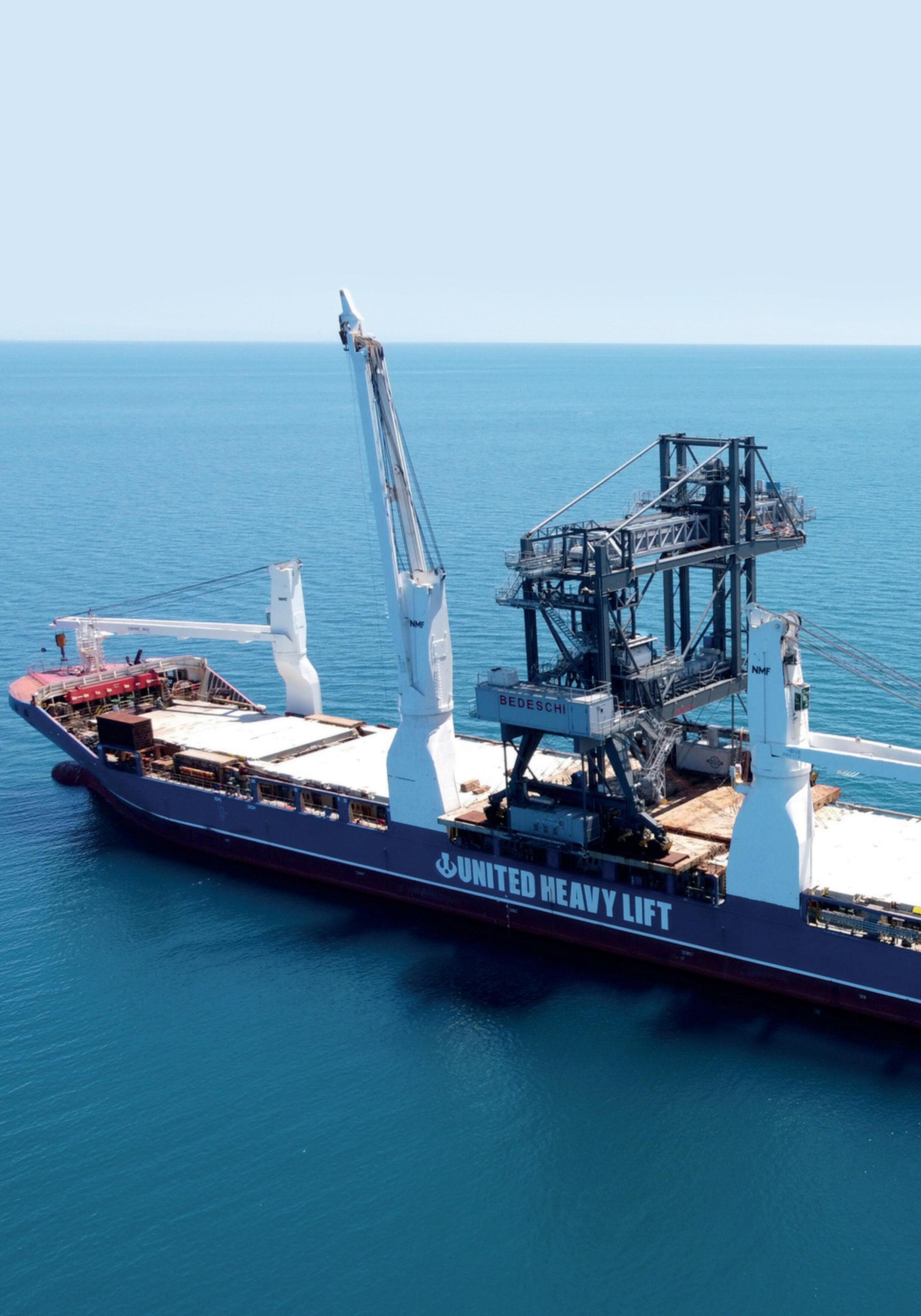
Longitudinal Storage

At the beginning of 2020, Bedeschi was awarded a bauxite storage facility for Guinea Alumina Corporation The plant is located in Kamsar (Nor th of Guinea, Boke Region), and the scope of supply includes a stacker with a capacity of 3000 t/h and a 420 meters long storage belt conveyor It is a stacker for handling bauxite both in dr y and wet conditions, when the material becomes sticky due to the humidity. The material is stored in two stockpiles of 160 000 tons each with chevron method
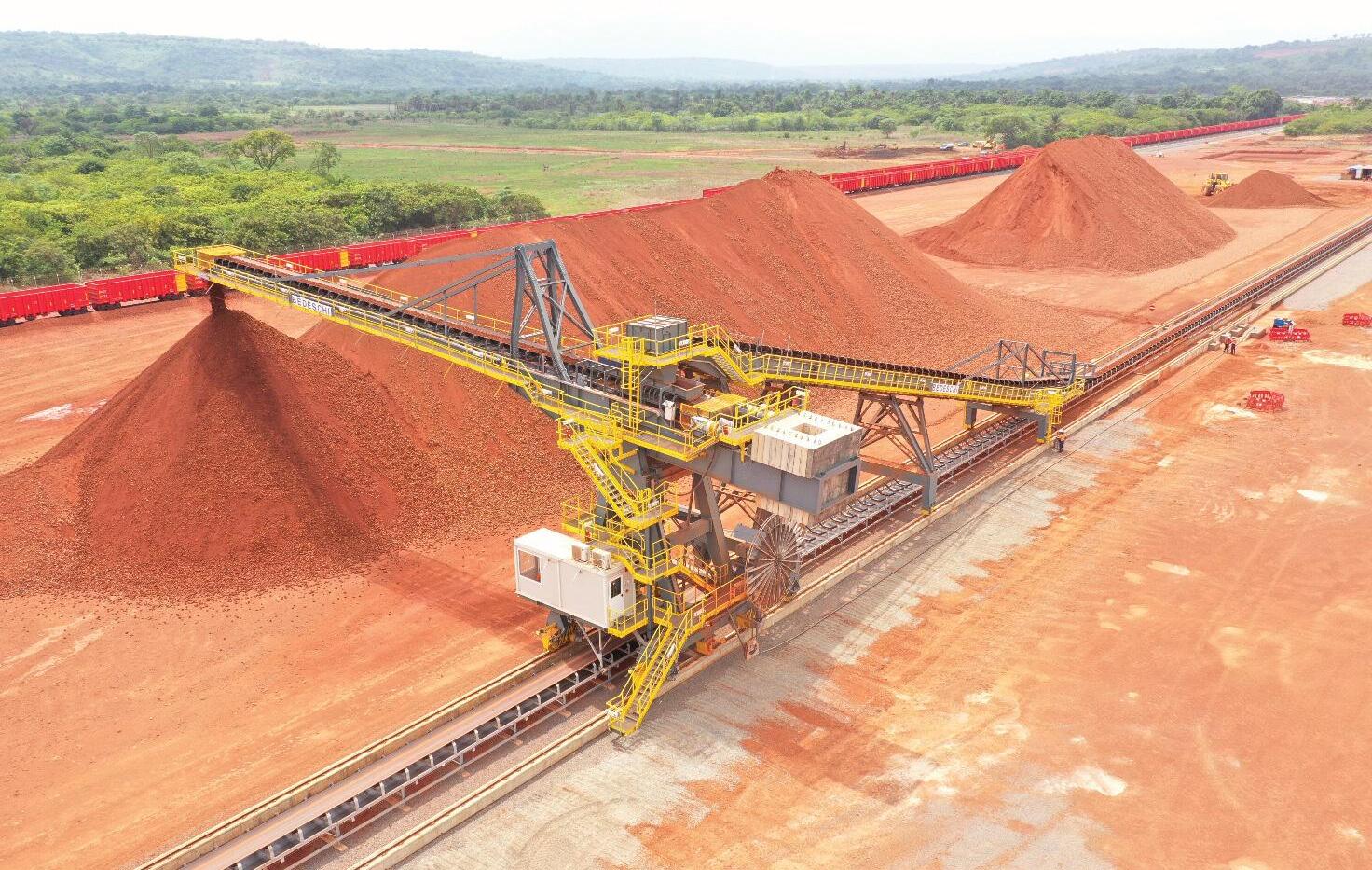
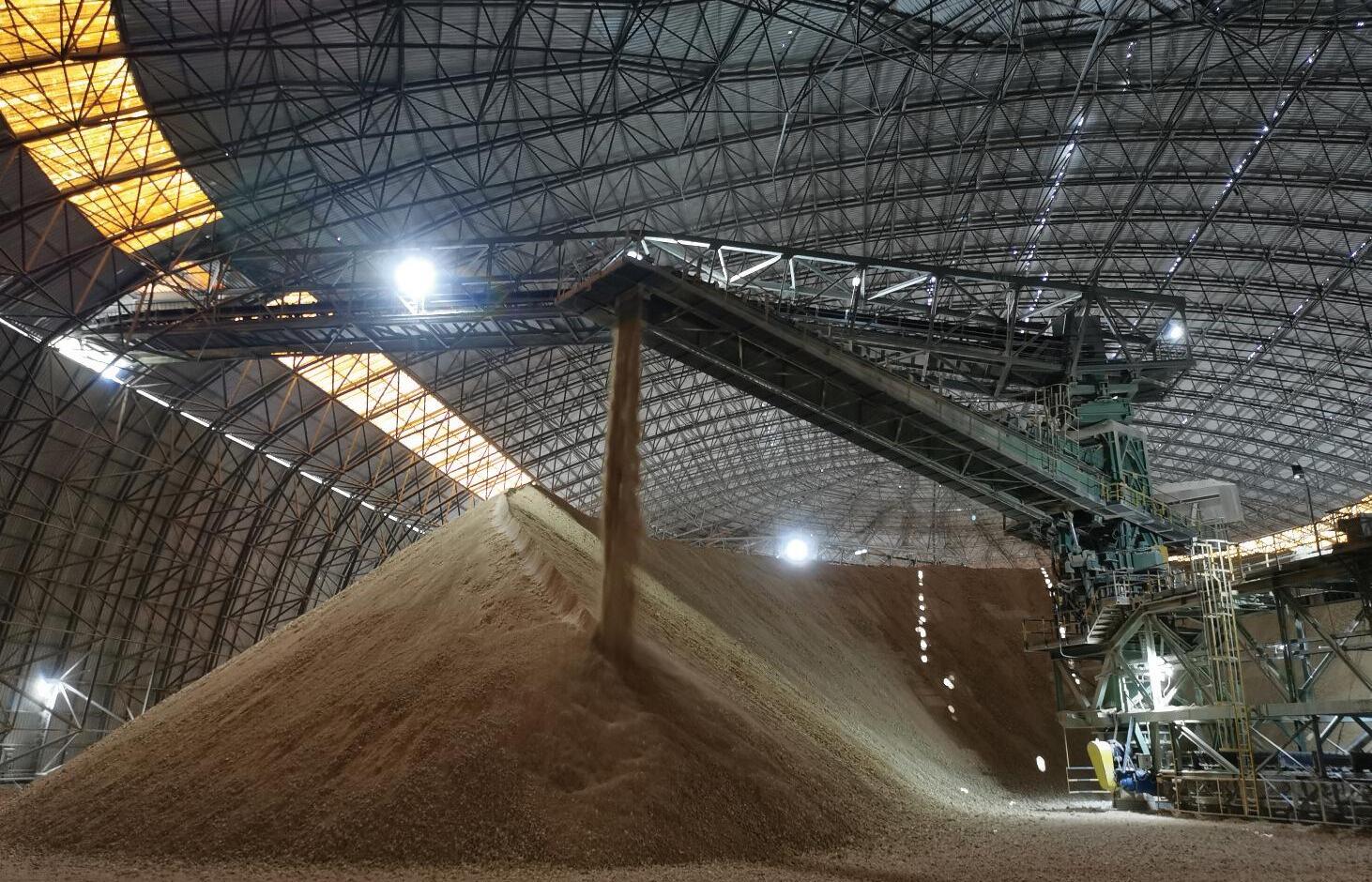
The machine has a capacity of 3000 tph and a 42 meters-long boom
In another order Bedeschi manufactured one stacker STK33/1000 for a Peruvian mining company active in the extraction, processing and commercialisation of iron ore The supply includes a new stacker and yard conveyor which are par t of the new expansion project of Shougang and are installed in the San Nicolas area, where the mineral is processed and stocked before dispatching The new conveyor and the stacker have a design capacity of 1,800 tph of iron ore and are currently in the commissioning phase ready to be handed-over to the mine operator
Ver tical Walls Blending Storage
The company also supplied 2 BEL C and 3 STKP for a typical cement plant for the processing of wet and sticky materials. Bedeschi has a long experience in the treatment of this kind of material The mixed clay and coal terminal has a capacity of 470 t/h for storage and a capacity of 200 t/h in reclaiming Based on the creation of rectangular section piles, the BEL C system, is composed of an interconnected system with a tripper, two bridge stackers and one overhead bucket reclaimer, to provide a complete remote automatic material stacking and reclaiming process. Thanks to the BEL C system it is possible to achieve a very high blending effect, comparable to or higher than a pre-blending bridge reclaimer.
More recently, Bedeschi was awarded two different projects supplying dry bulk stockyard equipment. For one client, the company will supply 5 bucket wheel stacker-reclaimers to handle coal with a 4,000/4,500 t/h capacity For another client, to whom Bedeschi already supplied 4 reclaimers to implement the capacity of their existing plant, the company will supply 3 reclaimers, one for sulphur with a reclaiming capacity of 500 t/h and two 1,500 t/h reclaimers for fer tiliser These projects are currently under the commissioning phase
Revamping Circular Storage

The long cooperation between Colacem and Bedeschi also continues with a new contract for the complete revamping project for the limestone reclaiming system for their plant in San Cristobal, Dominican Republic , and managed by Domicem (part of Colacem Group)
The original stacking and reclaiming equipment, installed by Bedeschi in 2004, allows clay and limestone handling at the plant The revamping of the machine will improve the limestone reclaiming system, increasing its capacity from 200 t/h to 360 t/h The capacity needed in order to feed the new production line will be installed at the plant. The system will be renewed from the
mechanical and electrical point of view, in order to guarantee the upgrade of all the components and deliver to their client a completely new system
New storage under construction
Saipem has awarded Bedeschi the pet coke and sulphur handling package for Duqm Refiner y in Oman The system will feature truck unloading on surface feeders, stackers, mobile hoppers for product reclaiming, complete conveyor system from storages to wharf and a loading system by mobile link conveyors to a radial shuttle type shiploader The stacking capacity for both pet coke and sulphur is 1.500 t/h. The equipment has been designed to operate in hazardous areas
January/February 2023 World Port Development 37 b u l k s t a c k e r r e c l a i m e r
Bedeschi circular storage in Dominican Republic
Bedeschi longitudinal storage in Guinea
One way to increase aport’s throughput and functionality is to create a complementary offshore - very large container vessel(VLCV) capable - floating terminal. This, and in some locations, given the heightened need to site provisional offshore wind (OSW) turbine fabrication and assembly facilities within some landconstrainedports, creates a unique business opportunity and an engineering challenge. This article, by Reece Shaw ofBurns &McDonnell, describes the Floating Automated Ship-to-Ship Terminal (FASST®) which meets these challenges.
Introduction
It is well known that many por ts around the world cannot accommodate VLCVs due to draught and ship-to-shore crane height and reach restrictions. The deepening of access channels and harbours, and the retrofitting of quays and the topside cranes, is often prohibitive - if not impossible - both in terms of high costs and environmental impacts Additionally, to create greener and more efficient facilities, often por ts are maximising the deliver y of containers to and from ships by train because this is the most sustainable and efficient way to move such cargo Separately, but in some cases, these same por ts would avail their facilities to the OSW industr y if they could
With this in mind, a floating terminal which is configurable to a client’s specific requirements has been developed that utilises a port’s existing infrastructure and facilities, leverages its offshore protected deeper water, has a limited environmental impact, is imper vious to sea-level rise , and is rapidly implementable .
Fur ther, when used for container transfer to-and-from VLCVs it significantly increases the potential deliver y of containers to-and-from ships by train and reduces container double handling by container bundling and direct to rail loading. When used for OSW turbine fabrication and assembly it can be configured to suppor t the building of the various floating
foundations including barge , semi-submersible (Figure 1), spar buoy, and tension-leg types, and can be repurposed as a container transfer facility upon decommissioning
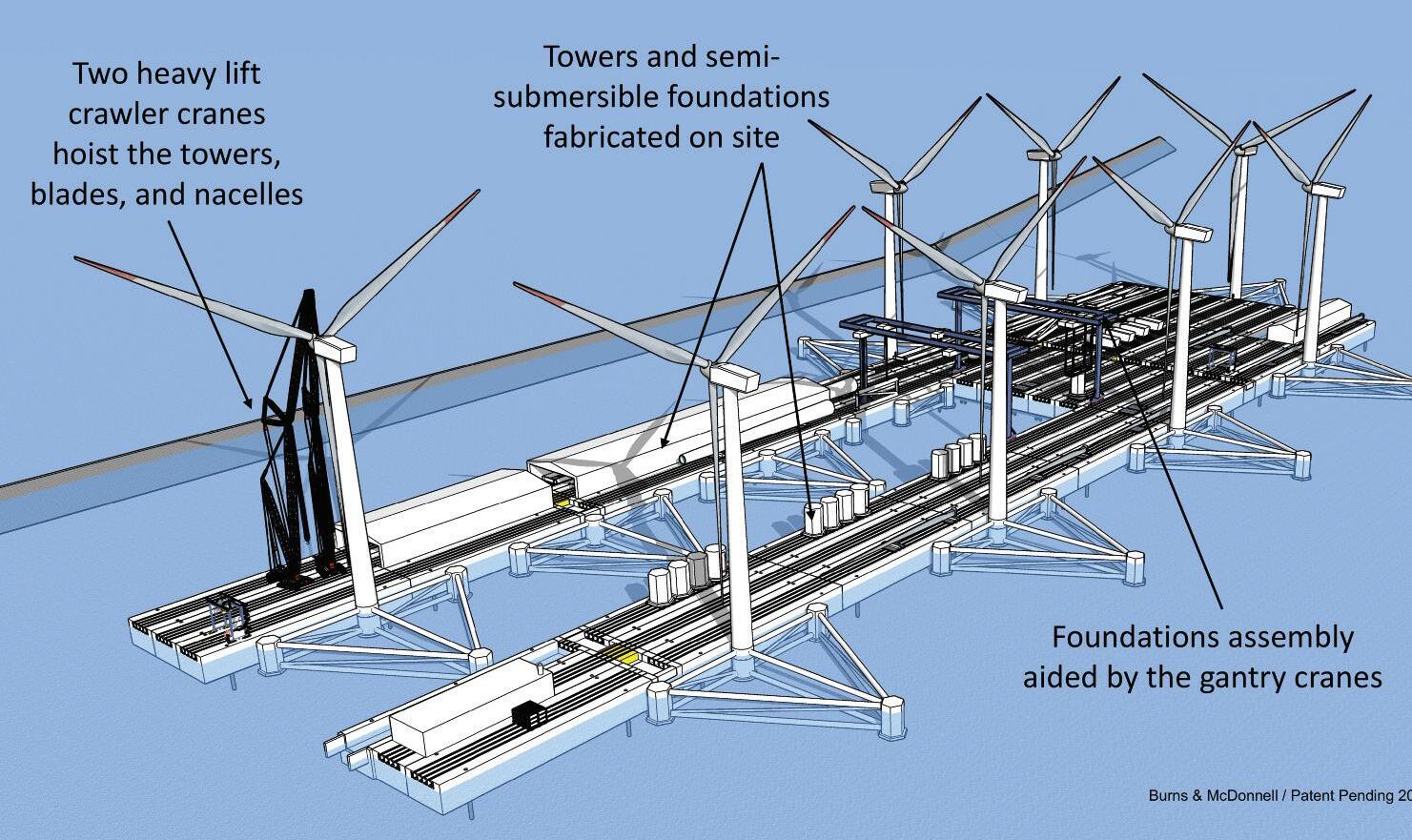
Ocean FASST
Stationed offshore in deep-water, the container transfer Ocean FASST shown in Figure 2 is tethered to a single-point mooring which is
Over view
There are two versions of the floating terminal, one designed for open water (Ocean FASST) and the other for sheltered water (Harbor FASST). Both versions can be configured to suppor t OSW turbine manufacturing and assembly This ar ticle is focused mainly on the container handling configuration
The FASST is designed to ber th up to a single 24,000 TEU VLCV, a Chinamax bulk carrier, or alternatively, two Panamax vessels simultaneously The cargo handled at the terminals will be containerised including containerised bulk The containers will be transpor ted to-and-from offshore via the purpose-built barges.
However, oversized cargo that cannot fit inside a 40-foot container due to being either too long, too high, or too wide can be delivered directly to the FASST via conventional marine vessels

also a weather vaning link between it and requisite geostatic subsea shore-connections It self-orients, facing the sum of the combined wind, wave, and current forces, which maximises its operation functionality Various mooring configurations can be utilized depending on the water depth.
Harbor FASST
The main difference between the Harbor FASST and the Ocean FASST is the mooring protocol (spud vs SPM) Located in a por t’s sheltered water adjacent to its main shipping channel, the Harbor FASST as shown in Figure 3 is held in the horizontal plane by retractable spuds while allowing it to float
Elements of the FASST System
The FASST systems can be comprised of various combinations of the following eight elements, (1) a catamaran vessel, (2) ship-to-ship gantry cranes, (3) a floating platform, (4) a Single Point Mooring (SPM) system, (5) a Vacuum Mooring System, (6) a Container Block
A P r o p o s e d F l o a t i n g C o n t a i n e r T r a n s f e r / O f f s h o r e W i n d T u r b i n e F a b r i c a t i o n a n d A s s e m b l y Te r m i n a l World Port Development January/February 2023 38 e n g i n e e r i n g f l o a t i n g t e r m i n a l
A P r o p o s e d F l o a t i n g C o n t a i n e r T r a n s f e r / O f f s h o r e W i n d T u r b i n e F a b r i c a t i o n a n d A s s e m b l y Te r m i n a l
Figure 1: A variation of FASST configured for semi-submersible offshore wind turbine manufacture and assembly
Transpor ters (CBT) system, (7) purpose-built yard engines, and (8), purpose-built barges Each of these elements are described below.
1 Catamaran Vessel
Depending on the geo-economics and metocean conditions of where a FASST is to be located, a catamaran vessel is an impor tant option Built in a shipyard, the catamaran vessel (Figure 4) will be self-propelled or towable . It is comprised of two bridged together pontoons which suppor t three straddling ship-to-ship (STS) gantr y cranes. Depending on the client requirements, the catamaran vessel could have onboard generation capabilities powered by LNG, green ammonia or hydrogen which is stored in exchangeable ISO tank containers A sufficient distance between the pontoons will allow for tug assisted manoeuvring of visiting vessels and bunkering ser vices
2. STS Gantry Cranes
The three symmetrical widespan STS rail mounted gantr y cranes, which are based on the Konecranes Cofatrans STS or a similar design, will straddle the catamaran, and translate along the top of the pontoons Each crane will have four spreaders resulting in a system capable of moving twelve boxes simultaneously which readily suppor ts the annual throughput capacity of over two million TEUs.
3 Floating Platform
The FASST platform is comprised of a series of modular precast prestress post-tensioned components which are built remotely, towed to the site , and incrementally assembled There are three basic types of precast components, platform units, docking basin units and transfer table units as shown in Figure 5. Additionally, in the case of the Ocean FASST, there are bow units which when assembled function as both a breakwater / windscreen and the pivoting connection with the SPM anchorage system
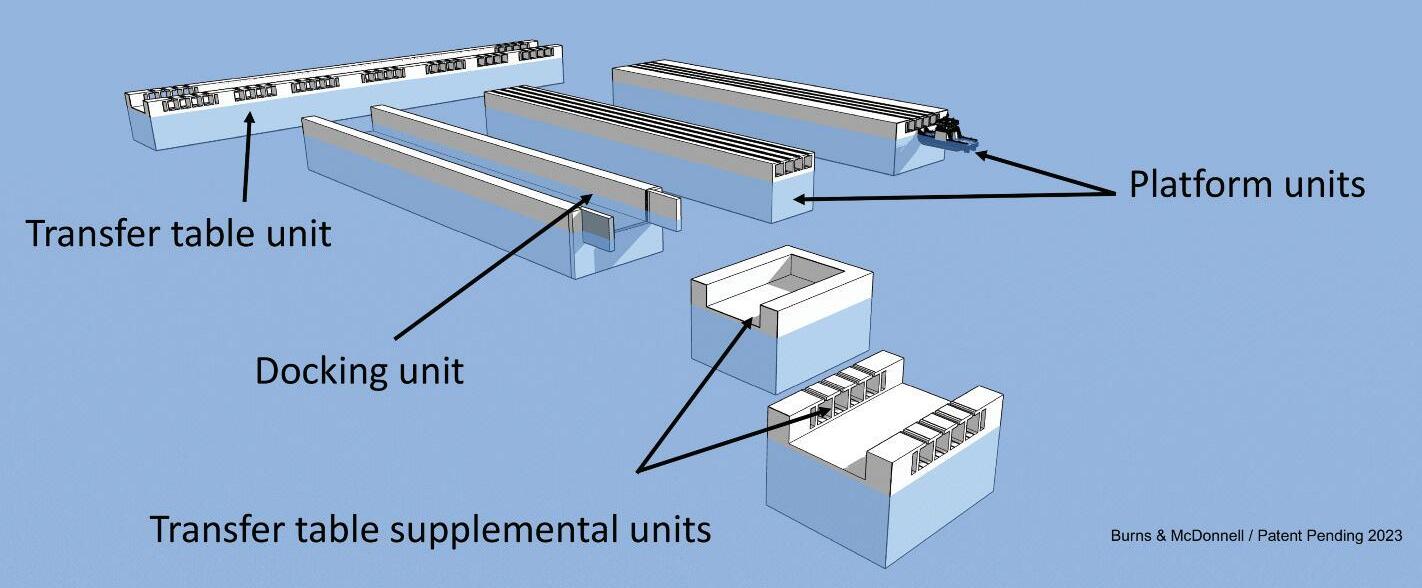
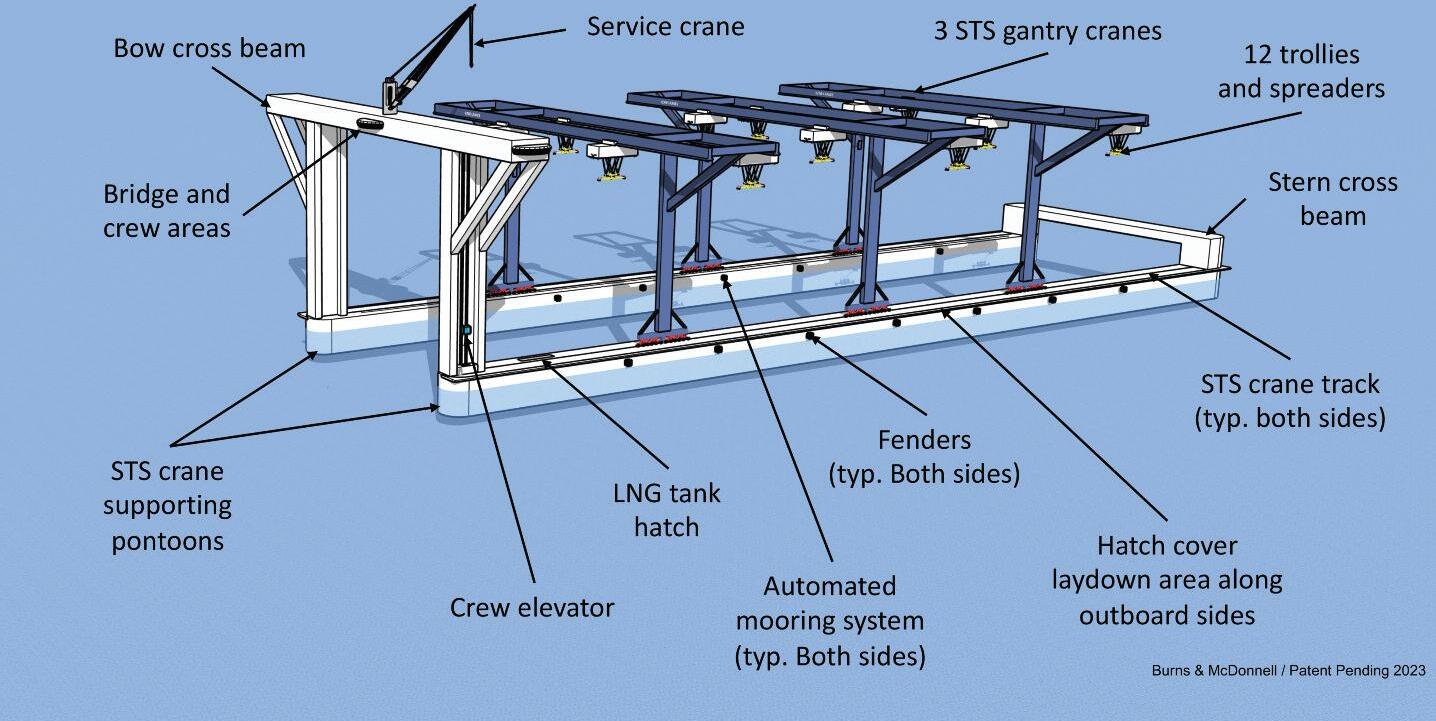
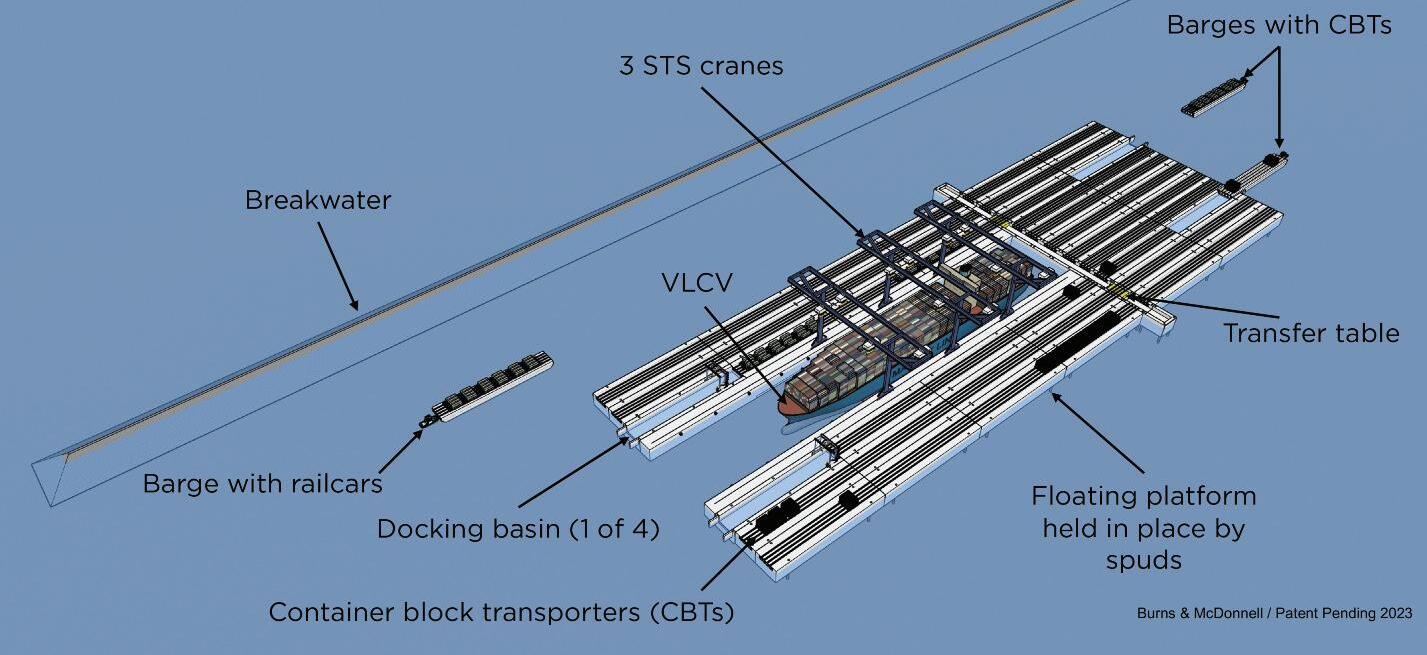

4 Single Point Mooring System
The SPM tower mooring system consists of either a tower structure that is permanently fixed to the seabed by means of piles or in a deep-water environment, a spread mooring systems using multiple mooring lines The SPM contains a bearing system that allows the platform to rotate around the fixed geostatic par t.

January/February 2023 World Port Development 39 e n g i n e e r i n g f l o a t i n g t e r m i n a l
Figure 2: Concept Ocean FASST pivoting about a single point mooring tower
Figure 3: Concept Harbor FASST is held in position by spuds
Figure 4: Catamaran vessel with three STS gantry cranes
Figure 5: Representative prestressed - precast platform units which are post-tensioned together at the site
5 Vacuum Mooring System

The interface connectivity and the dampened relative motion between the visiting vessel, the catamaran vessel, and the platform will be accomplished by Cavotec’s NxG mooring system or a similar solution This vacuum system will allow mooring and releasing of vessels in seconds and which drastically reduces vessel motion, provides for more efficient cargo transfer, increases loading and offloading productivity, and enhances safety The mooring system will also be able to marginally “fleet” the visiting vessel to assist STS crane positioning over the containers
6. Container Block Transporter System
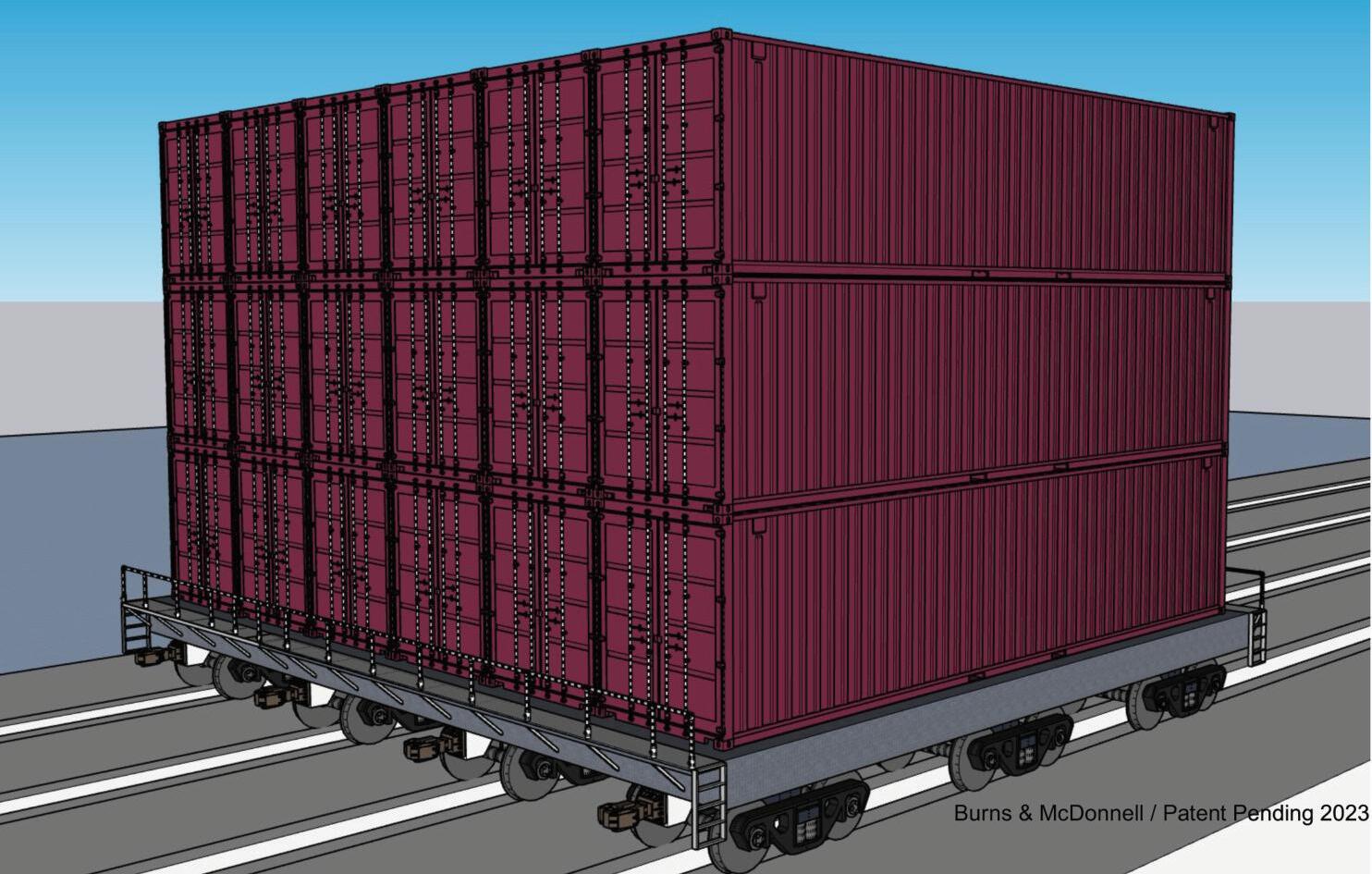
Container Block Transpor ters (CBTs) are designed to reduce container rehandling by holding up to eighteen for ty-foot containers each (Figure 6) They are 15 m (50-ft) long x 12 m (40-ft) wide and are fitted with couplers and brakes. The transpor ters ride on twelve railcar trucks distributed over four sets of standard gage railroad tracks Ergo, the purpose-built barges and the platform itself are also outfitted with sets of four parallel tracks These tracks allow for direct container-to-rail loading and unload when railcars are placed on the barges and brought to the offshore platform
7. Purpose-Built Yard Engines
The CBTs are moved as unit trains or individually by battery electric wireless charging yard engines (Figure 7) which travel on the platform’s lower deck In this way, the yard engines can freely move about and position the CBTs under the STS cranes or on the barges. The yard engines are fitted with a telescoping (retractable) coupler mechanism When the coupler arm is retracted, the yard engine can travel beneath the CBTs. Hence , when a yard engine arrives at a CBT that needs to be moved, the telescoping coupler can be extended through a slot in the main deck tracks and couple to the CBT Multiple yard engines can work in tandem to jointly move a barge load of ten CBTs (180 containers).
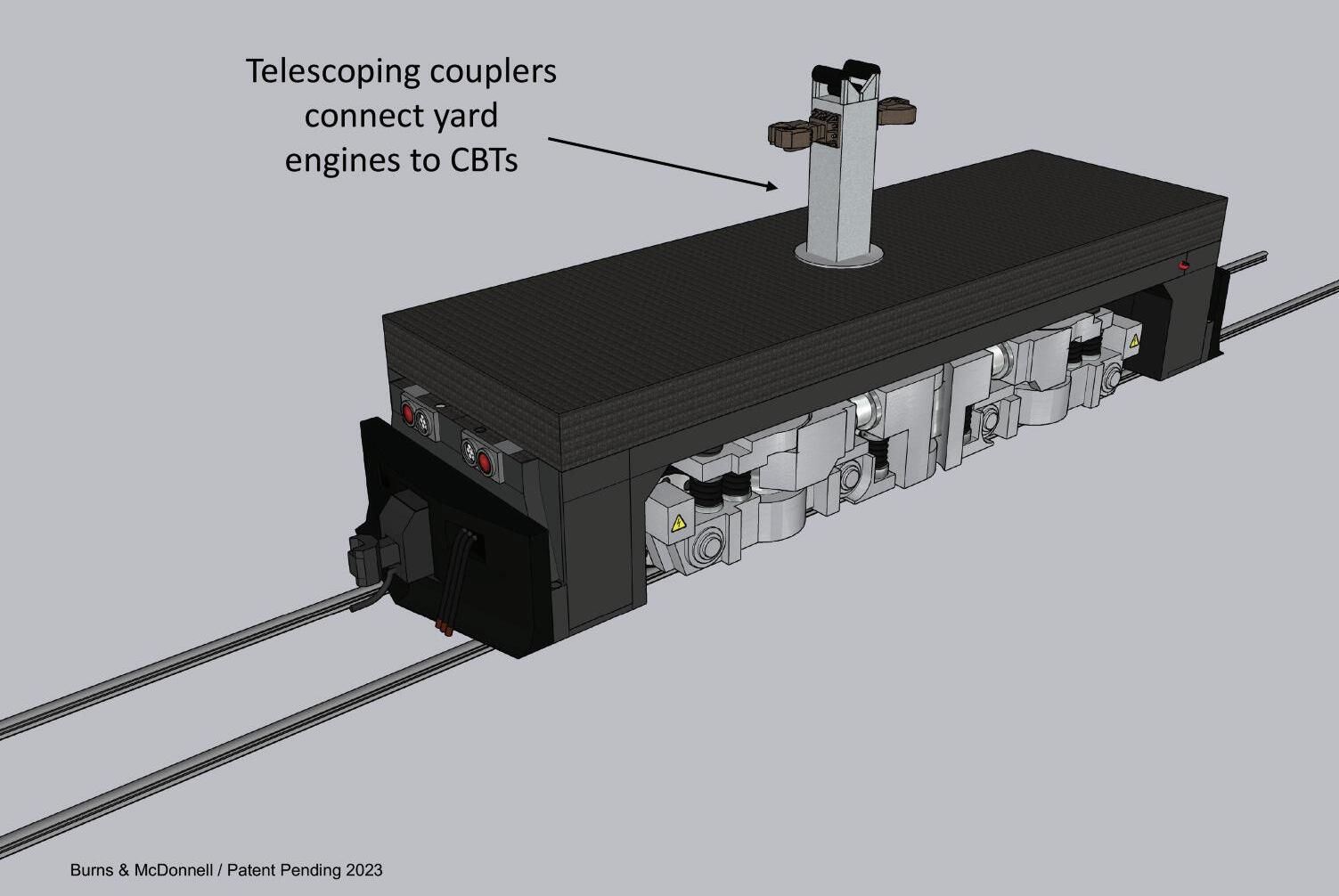
8 Purpose-Built Transport Barges for Railcars and CBTS
Towable harbour or oceangoing barges shuttle CBTs or railcars loaded with containers to and from the FASST and the shoreside hub These transpor t barges - which are designed to move 180 forty-foot containers on 10 CBTs or 48 for ty-foot containers on 24 railcars (Figure 8) - are brought to the platform and ber thed as shown in Figure 9.

World Port Development January/February 2023 40 e n g i n e e r i n g f l o a t i n g t e r m i n a l
Figure 6: Container block transporter (CBT)
Figure 7: The purpose-built Yard engines run on the below deck
Figure 8: A purpose-built barge with 10 CBTs (left) and one with double stack railcars (right)
Once a barge is inside a docking basin, its gates are closed, and water is pumped out so that the barge sits down on the basin floor. This berthing method both stabilises the barge and automatically aligns the barge’s and the platform’s railroad tracks
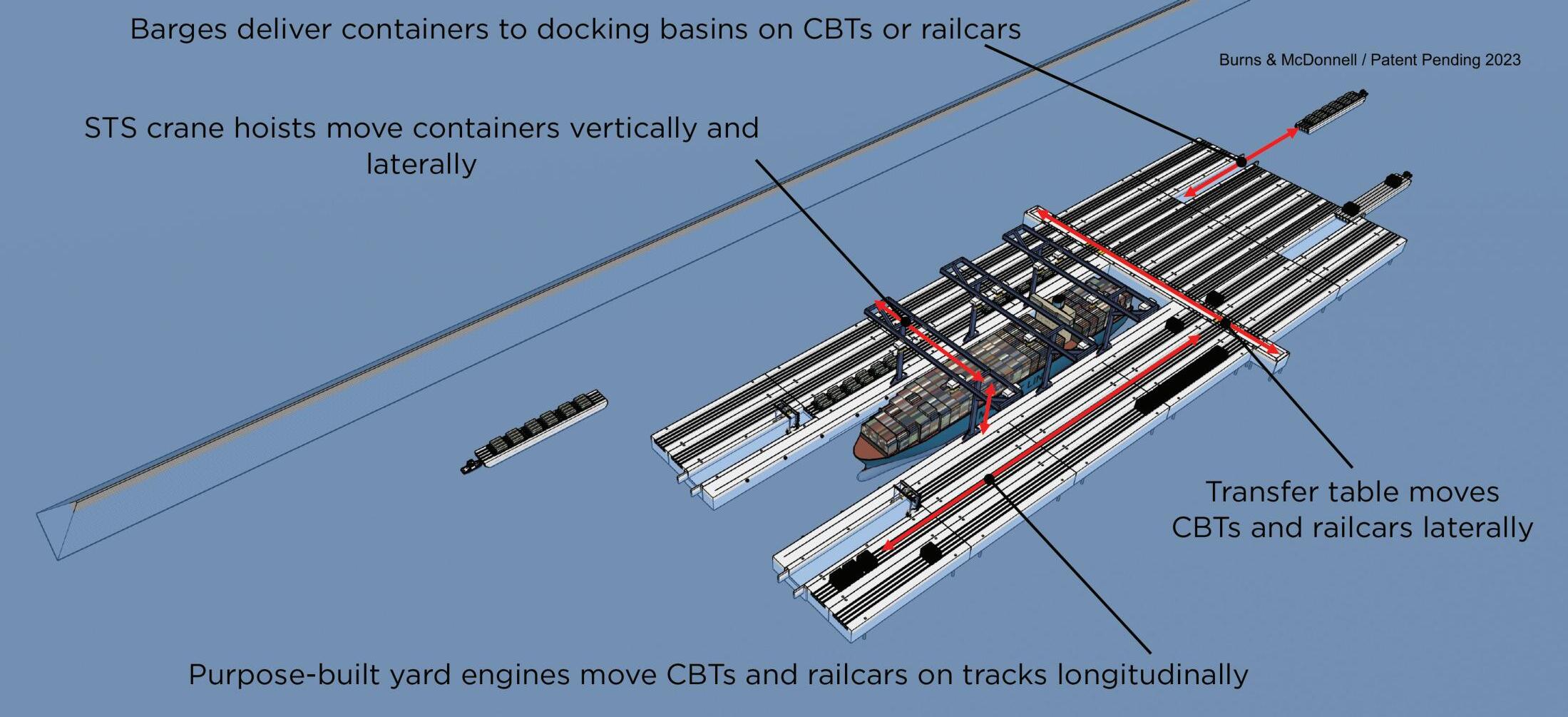
Offshore Operations

Once the floating platform has been fully assembled, the catamaran vessel is adjoined therewith. The FASST is designed so that in the event of a foreseen typhoon or hurricane, the catamaran can be moved out of harm’s way - by detaching from the platform and relocating to a secure site - while the platform remains in place and ride out the storm facing into the weather event
Figures 9 and 10 illustrate the movement of CBTs or railcars both longitudinally and laterally. Bulk material will be expor ted using a container bulk handling system such as the one developed by the Intermodal Solutions Group or by a similar system
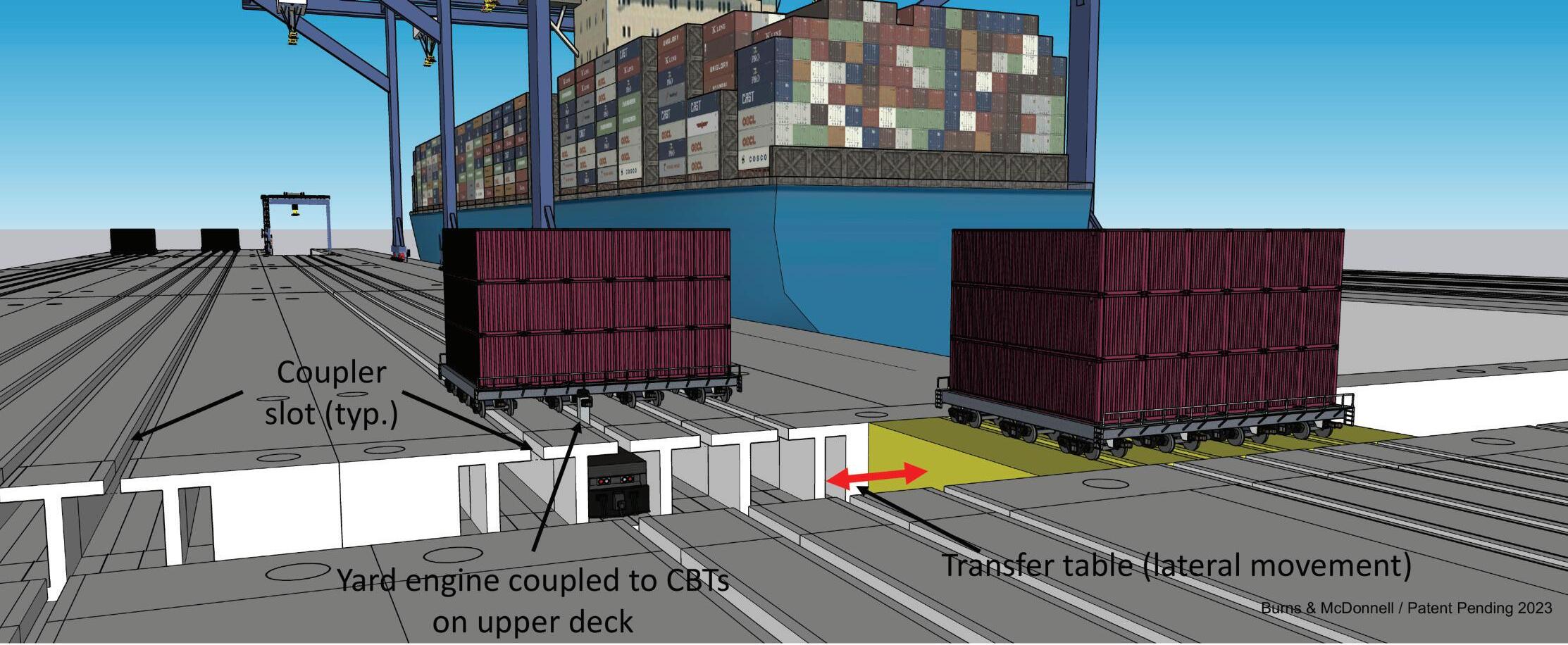
Purpose-built containers with removable lids will be lifted from a CBT and using a specifically designed “rotainer” spreader, will be tipped into the ship’s hull
Additionally, a fully automated twistlock removal system will be utilised to reduce the risk of injuries, lower costs, and improve productivity
Conclusion
An investment decision to site and build a floating container transfer / OSW turbine manufacturing and assembly terminal is based on a combination of, (1) the availability of labour and the requisite suppor ting ser vices, (2) the projected freight or turbine volumes traversing the facility, (3) an objective assessment of the hosting por t’s unmet logistics needs, and (4) a determination of whether containers or completed turbines can efficiently and cost effectively be processed from it into the supply chain. The FASST, with its various configurations can be used as a technological basis to aid in rationally assessing these business decision indicators

January/February 2023 World Port Development 41 e n g i n e e r i n g f l o a t i n g t e r m i n a l
Figure 9: The Container movement on the FASST
Figure 10: The Container Block Transports are moved laterally by a rolling transfer table and longitudinally by yard engines which run on a deck below
Claire Instone reports…

After the disruption of recent years, shipping lines and cargo owners are looking for capacity, reliability and growth opportunities and that’s what operators and por t authorities are striving to provide We take a look at the projects underway to expand and improve infrastructure and create brand new best-in-class facilities as por ts around the globe kick off 2023 with a bang.
DP World invests in India and UK
DP World has secured a huge concession to develop, operate and maintain the mega container terminal at Deendayal por t in Gujarat in India The project involves the construction of a mega-container terminal at Tuna-Tekra through a Public-Private Par tnership (PPP) The facility will include a 1,100-meter ber th and be capable of handling vessels in excess of 18,000 TEUs Its total capacity will be 2 19m TEUs The contract was awarded under on a Build-Operate-Transfer
Expectations for the new terminal are that it will unlock future container traffic growth in India, catering to expor ts and impor ts from Northern, Western and Central India, reducing logistics cost and enhancing efficiencies across supply chains DP World’s strategic investments in por ts and terminals in the countr y is aligned with the Indian Government’s Vision 2047, which aims to quadruple the country’s port handling capacity
“India represents a significant landscape for opportunity As the value chain becomes more integrated, significant growth oppor tunities exist across the entire Indian por ts and logistics space With the development of Tuna Tekra terminal in Gujarat, DP World will be well placed to capture these oppor tunities. This is yet another step in our collective effor ts with the National Investment and Infrastructure Fund to leverage our exper tise in logistics infrastructure and local knowledge to fur ther strengthen India’s supply chain,” confirmed Sultan Ahmed Bin Sulayem, CEO
The new terminal will be constructed and equipped with most modern facilities and equipment over an area of approximately 63 hectares It will be well connected to the hinterland through the network of roads, highways, railways and the Dedicated Freight Corridors
The global terminal operator is also set to invest £12 million in two new Rail Mounted Gantr y (RMG) cranes at the London Gateway facility over in the United Kingdom in order to meet fast growing demand for rail connections from customers at the smart logistics hub, which will increase its capacity by a third when a new four th ber th opens next year
The investment in the cranes - which are used for the quick, safe and automated handling of containers and will be operational in time for the new ber th’s opening - will lift rail capacity at London Gateway by a pretty whopping fifty percent

e n g i n e e r i n g p o r t c o n s t r u c t i o n
World Port Development January/February 2023 42
S t r i v i n g t o b e b e s t - i n - c l a s s
Freeport East has received final Government approvals allowing it to move forward into the delivery phase
Andrew Bowen, Por t Operations Director at London Gateway, said: “We are delighted to be making a fur ther investment in our rail capability and rail capacity with two new RMG cranes which will arrive in the same year that we open a new four th ber th ”
DP World runs the UK’s most advanced logistics hubs at London Gateway and Southampton: two deep water por ts with access to freight rail terminals, and a rapidly expanding logistics park on the doorstep of the capital Between them they moved a record volume of cargo in the first half of last year, with a combined total of 1.93 million TEUs
The operator has now star ted construction at London Gateway’s new £350 million four th ber th, which will lift capacity by a third when it opens in 2024 The construction project is suppor ting 1,000 jobs and the por t-centric logistics park will employ a fur ther 12,000 people when it is completed in four years ’ time . The company has also earmarked a fur ther hefty £1 billion of investment in the United Kingdom over the next 10 years
Por ts go deeper and higher in the United States
In the US, Georgia officials have agreed on a plan to raise Savannah’s towering suspension bridge to make room for larger cargo ships to reach the city’s seapor t A contractor will be hired later this year to consult on the project while it’s still in the design phase
The Eugene Talmadge Memorial Bridge spans the Savannah River at the Georgia-Florida line. Cargo ships passing Savannah’s downtown riverfront must sail under the bridge to reach the Por t of Savannah. The plan is to raise the bridge while also replacing its decades-old suspension cables - the construction costs of which would be between around USD150 million and USD 175 million.
In addition to the raising of the bridge , the Georgia Por ts Authority is also increasing chilled cargo capacity to stay ahead of anticipated growth in demand “Expansion among our cold storage par tners in the Savannah market will drive greater volumes of chilled cargo crossing our docks,” said GPA Executive Director Griff Lynch “While the Por t of Savannah already accommodates the most refrigerated containers on the South Atlantic and Gulf coasts, enhancing our on-terminal capacity will better suppor t oppor tunity sparked by private investment ”
Private chilled and frozen warehouse space in Savannah is set to grow by 11 percent in 2023 to more than 2 2 million square feet The GPA board has approved construction of seven additional refrigerated container racks at Savannah The USD6 2 million project will grow the number of slots for cold cargo to 3,506 at Garden City Terminal, counting chassis plug-ins Savannah’s Ocean Terminal has another 368 refrigerated container plugs
In other news, over in Virginia lawmakers are proposing funds for the state’s second inland por t State budget amendments totalling USD65 million have been filed in order to establish a facility in the Southwest region To be owned by the Por t of Virginia the hub is expected to be a USD50m initial investment and create 1,370 permanent new jobs


As for the por t of New York and New Jersey, it’s maintenance dredging that’s on the agenda at present The New York District of the US Army Corps of Engineers (USACE) proposes to perform maintenance dredging of the NYNJ harbour to a depth of -50 feet Mean Lower Low Water (MLLW) plus 1 foot of
allowable over-depth The work would remove around 125,000 cubic yards of material Based on past projects, the proposed project will have to be performed by a mechanical clamshell dredge with environmental bucket Additionally, tugboats, sealed hull barges and sur vey vessels will be required to perform the work during the dredging, transpor t, processing and placement activities The work is set to take place later this year at a cost of between USD10 and USD25 million
Also working alongside the USACE is the Por t of Houston with regards funds for expansion Project 11 A federal omnibus bill signed by President Joe Biden at the end of last year allocated funding to the Army Corps of Engineers As such, the Por t of Houston is seeking consideration for USD80 million in funding from the Corps for the expansion of the Houston Ship Channel from 530 feet to 700 feet This will be the 11th major expansion of the channel (hence , the name Project 11) and will allow for easier and safer two-way transit of vessels At present the overall USD1 billion project is around 82% funded. If the por t receives USD80 million from the Corps, it could put Project 11 about USD98m away from being fully funded The project star ted construction back in May and will be on track for completion by 2025 if remaining funding is received in a timely manner
Not to be outdone , the Por t of Long Beach is also working on increasing its channel and just recently received federal authorisation for its long-planned project - the aim of which is to improve the movement of large vessels in and out of the por t by reducing the need for lightering. The initiative , which should be completed by 2030, has both operational and environmental benefits and was one of only five navigational projects nationwide that received Army Corp of Engineers endorsements for construction authorisation under the Water Resources Development Act of 2022 The Corps will now proceed with the Por t of Long Beach project with the Corp and the Por t of Long Beach sharing the USD200 million cost.
“This project will widen and deepen the harbour ser ving one of the world’s top ten busiest container por t complexes,” said Por t Executive Director Mario Cordero “Increasing the safety and efficiency of vessels transiting our waterways suppor ts our mission to remain competitive while reducing pollution from por t-related operations ”
e n g i n e e r i n g p o r t c o n s t r u c t i o n January/February 2023 World Port Development 43
Key elements include deepening the Long Beach Approach Channel from 76 to 80 feet, easing turning bends in the Main Channel to deepen a wider area to 76 feet, deepening par ts of the West Basin from 50 to 55 feet, constructing an approach channel and turning basin to Pier J South with a depth of 55 feet, improving the breakwaters at the entrance to Pier J, and depositing dredged material in nearshore sites for reuse or in federally approved ocean disposal sites Authorisation of the project enables the port and Corps to proceed with engineering agreements, detailed planning and budgets, bidding and awarding construction contracts, and procuring funding In the coming year, the por t and Corps are expected to execute a design agreement and initiate design work Construction is projected to star t in 2027 and take around three years
And the funding doesn’t stop there In January of this year it was confirmed that the Por t of Corpus Christi Ship Channel Improvement Project (CIP) has received USD157 3m in federal funding The money will advance the last phase of the CIP, a national critical infrastructure project that will render the Corpus Christi Ship Channel the most improved in the entire US Gulf Coast from Texas to Florida. “The Project, over 30 years in the making, will significantly increase the ability of our customers and port stakeholders to move greater volumes safely and efficiently,” said
Sean Strawbridge
CEO of the Por t
,
The CIP will increase the depth of the channel from -47 feet Mean Lower Low Water (MLLW) to -54 feet MLLW, while also widening it to 530 feet An additional 400 feet of barge shelves will also be constructed, allowing for two-way traffic of both vessels and barges in tandem The project is due for completion in 2024
New facilities in the Middle East
Head of the Suez Canal Economic Zone (SCZone) Waleid Gamal El-Dein recently confirmed that the work plan for the development of the Por t of Arish will be completed during the first quar ter of 2024
Estimated at EGP 830 million, the plan includes the implementation of sea docks, breakwaters, container handling yards, and internal roads. The por t is being developed in cooperation with the Armed Forces’ Engineering Authority, the Suez Canal Authority, and national contracting companies. The facility consists of one dr y bulk terminal, one ber th of 242 meters for dr y bulk and general cargo, and a ber th for ser vice boats
As for container terminal development in the Middle East, it is King Abdulaziz Por t which is in line for development. The Saudi Por ts Authority (MAWANI) recently announced the laying of the foundation stone for upgrading and developing two container terminals at the por t in Dammam The project comes under the Build-Operate-Transfer (BOT) concession signed with Saudi Global Por ts (SGP) valued at over USD1.86 billion.
The concession will work on refurbishing ber ths and facilities across the por t’s first container terminal alongside expanding ber ths and overhauling the container yard within the second container terminal to enable the Arabian Gulf hub to handle giant containerships Works will also add a custom-built sandbox to test cutting-edge technologies and conceptualise new processes before going online The project is cited to up the por t’s overall capacity by 120% to 7 5 million TEUs.
Approvals and finance granted for por ts in Europe


In the United Kingdom, Freepor t East has received final Government approvals allowing it to move forward into the deliver y phase The development of the Freepor t will be boosted by £25 million in Government funding to suppor t infrastructure enhancement
“This is a major milestone and the result of a great deal of hard work from all our par tner organisations. Freepor t East is a locally led initiative but has global connections and ambition,” said Steve Beel, Chief Executive “Bringing together key stakeholders including local government, the private sector, and educational institutions we will attract new investment to create a hotbed for trade , innovation and green energ y driving growth in both the regional and national economies We will look to par tner and collaborate with all organisations interested in the economic success of the region and encourage par ties to get in touch with us directly ”
Freepor t East covers an area within roughly 45 kilometres of the por ts of Felixstowe and Harwich and has three main development sites at the Por t of Felixstowe , Harwich International Por t and Gateway 14 near Stowmarket Work has already commenced on the Gateway 14 development and there are ambitious plans to create a green energ y hub in Harwich to ser ve sectors including offshore wind
Also on the receiving end of good news at the beginning of this year was Lithuania’s largest seapor t. European Union officials have announced plans to suppor t the development of an expanded por t in Lithuania as par t of an effor t to suppor t a green transition and enhance maritime capabilities in the Baltic and Eastern Europe The European Investment Bank (EIB) and Klaipeda State Seaport Authority recently signed a €65 million (approx. USD69m) loan agreement for the development of Klaipeda seapor t The project suppor ts an impor tant European maritime transpor t hub and is of strategic importance for the Lithuanian economy The financing will be for rehabilitation, extension and deepening of the por t’s quay walls to facilitate access for larger vessels
Spain and Greece facilities get a makeover
The Por t Authority of Bilbao has approved the call for tenders for the construction and operation of a container terminal on the central quay - the last large area of the port of Bilbao for which a concession can be awarded The first phase (already complete) has given rise to an operational surface area of more than 30 hectares Meanwhile , construction of the second phase will begin this year and will also have an operational surface area in excess of 30 hectares Improving the connectivity and intermodality of the por t of Bilbao and attracting new traffic and shipping lines are strategic objectives of the Por t Authority The decision to proceed has been endorsed by several international operators who have confirmed that the por t of Bilbao is in a favourable position to be a real alternative to address the problem of congestion in the por ts of Nor thern Europe .
Major maritime infrastructure projects are also on the cards for Greece . Five facilities are due to be upgraded via six initiatives under the EU’s Connecting Europe Facility
The por ts of Pireaus, Thessaloniki, Heraklion and Igoumenitsa will see improvements such as the addition of electric charging solutions for ships using hybrid propulsion technolog y and the installation of digital technolog y to facilitate just-in-time arrival and sustainable logistics
Additionally, the Greek government plans to carr y out immediate works on the por t of Alexandroupolis to include dredging the por t channel out to a distance of 2 5km as well as instigating road construction The total cost of the upgrades has yet to be announced
e n g i n e e r i n g p o r t c o n s t r u c t i o n World Port Development January/February 2023 44
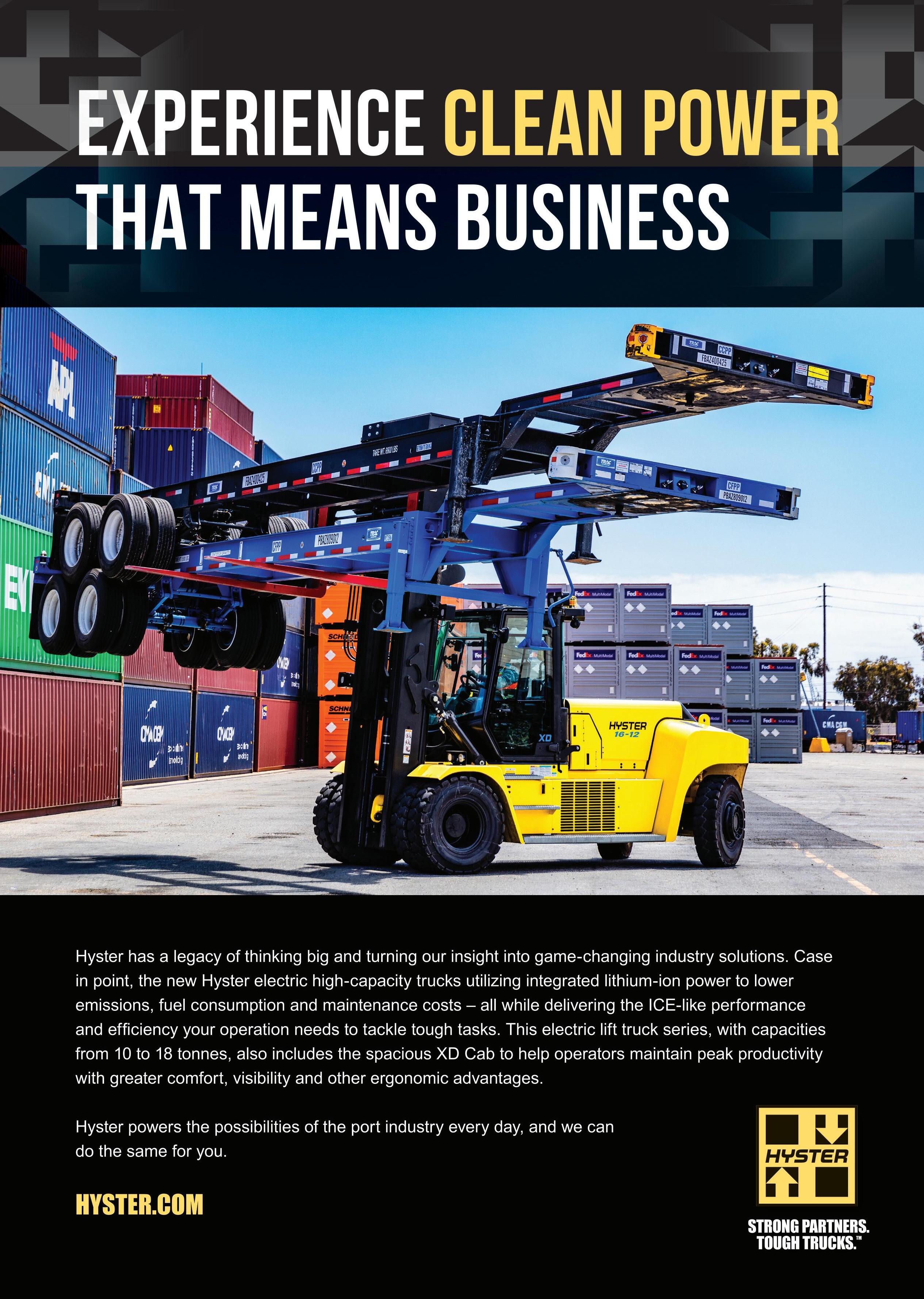
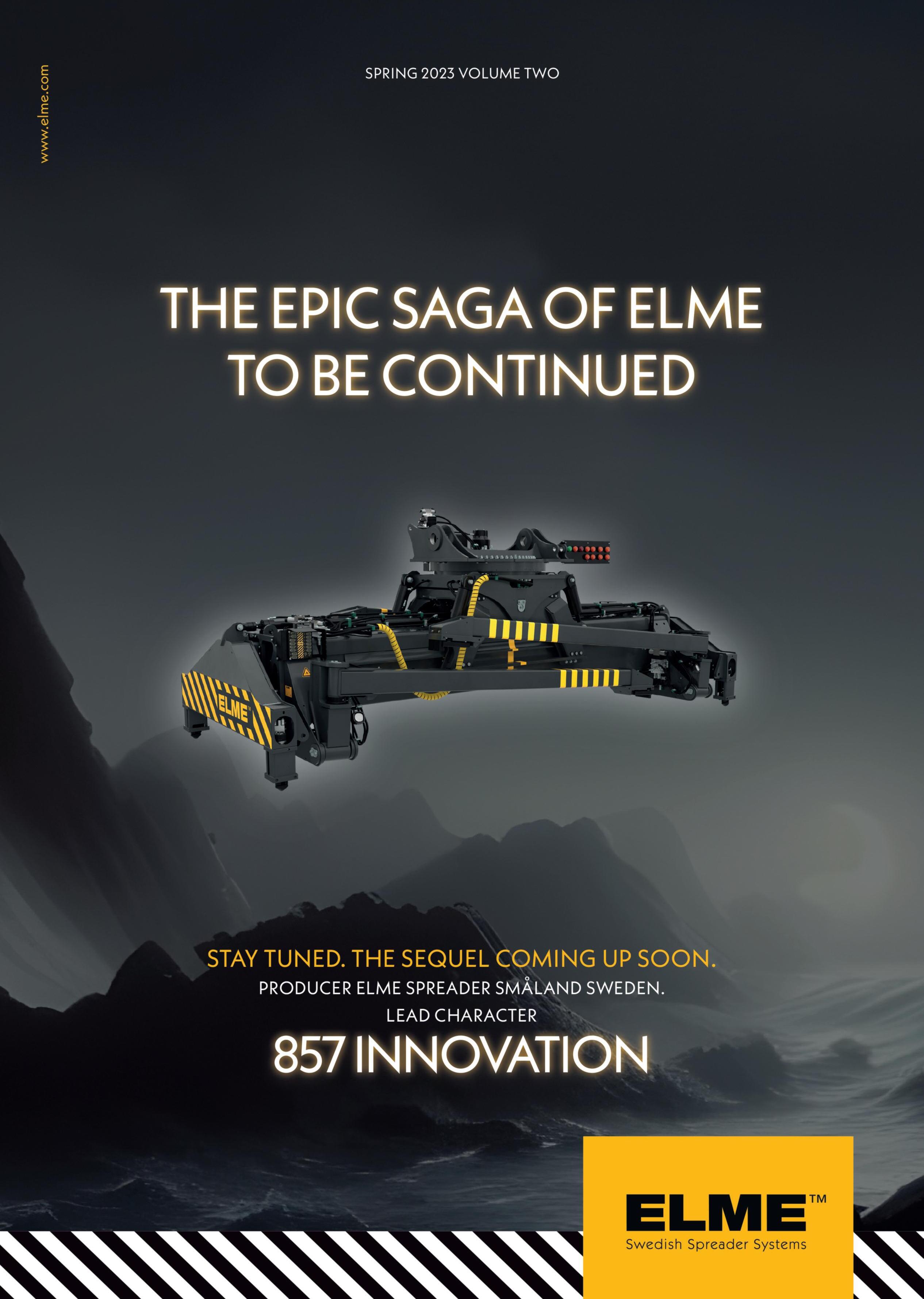















 Claire Instone Editor
Claire Instone Editor


































































